Management and leadership concepts Assignment 2022
VerifiedAdded on 2022/02/19
|37
|13202
|20
Assignment
AI Summary
Contribute Materials
Your contribution can guide someone’s learning journey. Share your
documents today.
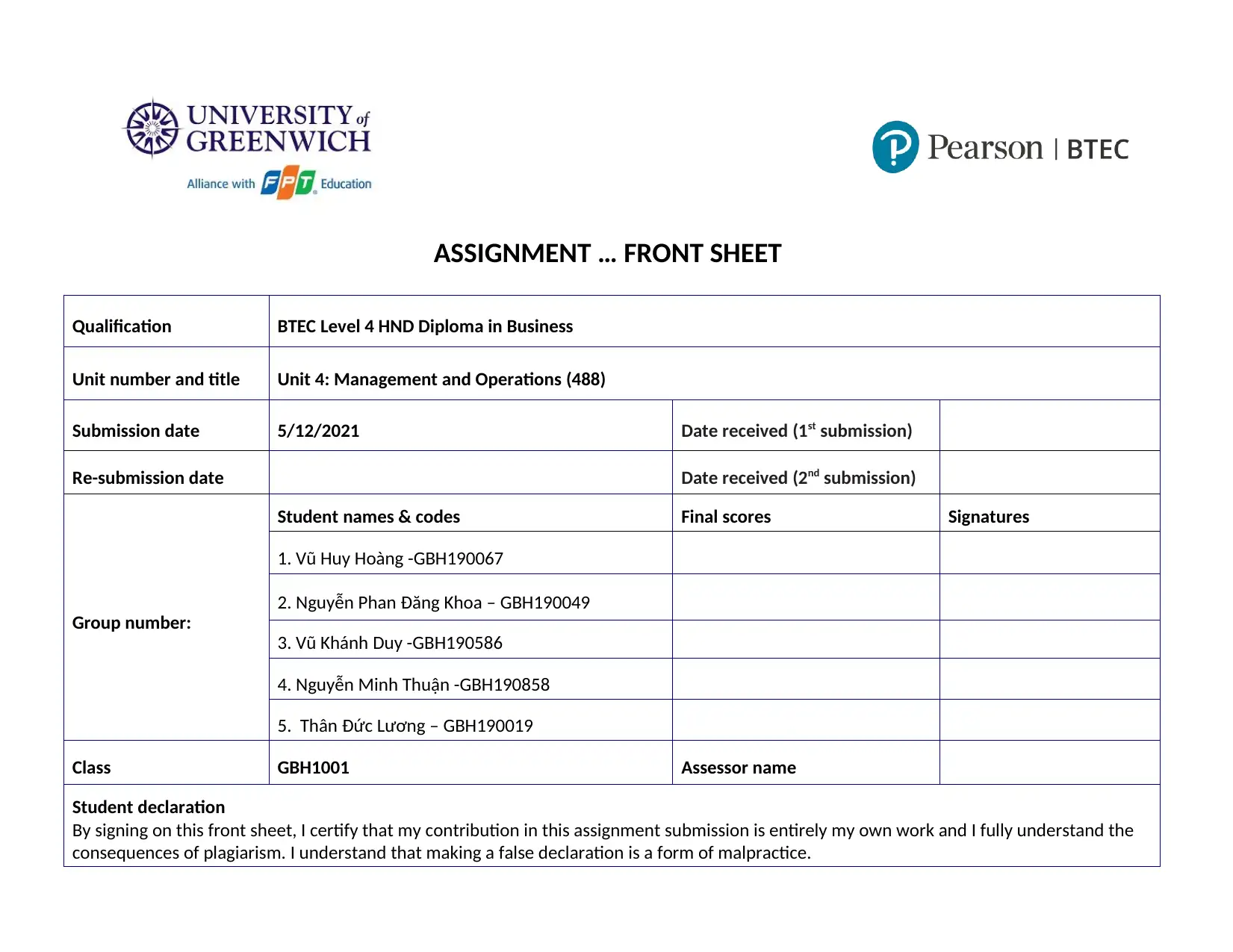
ASSIGNMENT … FRONT SHEET
Qualification BTEC Level 4 HND Diploma in Business
Unit number and title Unit 4: Management and Operations (488)
Submission date 5/12/2021 Date received (1st submission)
Re-submission date Date received (2nd submission)
Group number:
Student names & codes Final scores Signatures
1. Vũ Huy Hoàng -GBH190067
2. Nguyễn Phan Đăng Khoa – GBH190049
3. Vũ Khánh Duy -GBH190586
4. Nguyễn Minh Thuận -GBH190858
5. Thân Đức Lương – GBH190019
Class GBH1001 Assessor name
Student declaration
By signing on this front sheet, I certify that my contribution in this assignment submission is entirely my own work and I fully understand the
consequences of plagiarism. I understand that making a false declaration is a form of malpractice.
Qualification BTEC Level 4 HND Diploma in Business
Unit number and title Unit 4: Management and Operations (488)
Submission date 5/12/2021 Date received (1st submission)
Re-submission date Date received (2nd submission)
Group number:
Student names & codes Final scores Signatures
1. Vũ Huy Hoàng -GBH190067
2. Nguyễn Phan Đăng Khoa – GBH190049
3. Vũ Khánh Duy -GBH190586
4. Nguyễn Minh Thuận -GBH190858
5. Thân Đức Lương – GBH190019
Class GBH1001 Assessor name
Student declaration
By signing on this front sheet, I certify that my contribution in this assignment submission is entirely my own work and I fully understand the
consequences of plagiarism. I understand that making a false declaration is a form of malpractice.
Secure Best Marks with AI Grader
Need help grading? Try our AI Grader for instant feedback on your assignments.
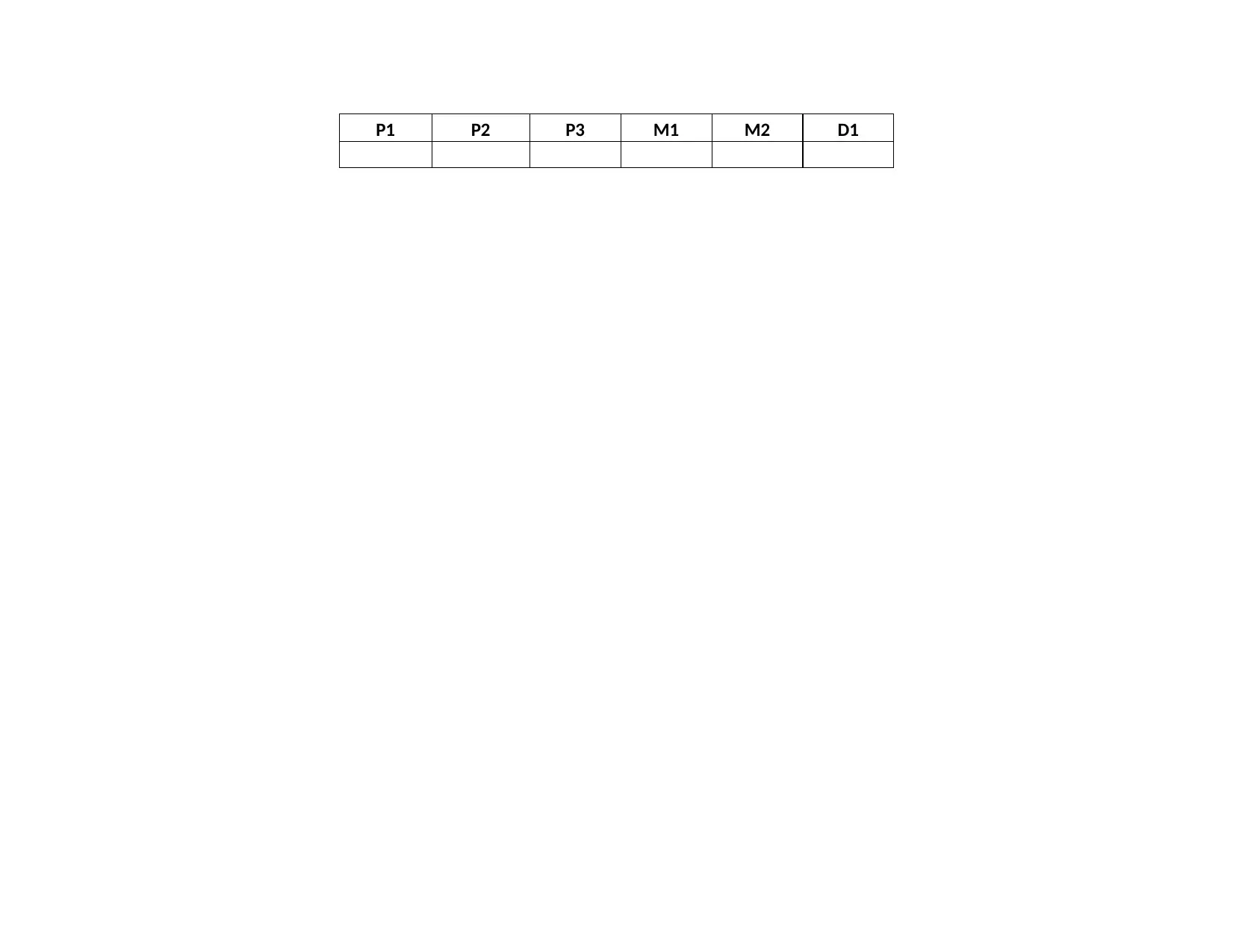
P1 P2 P3 M1 M2 D1
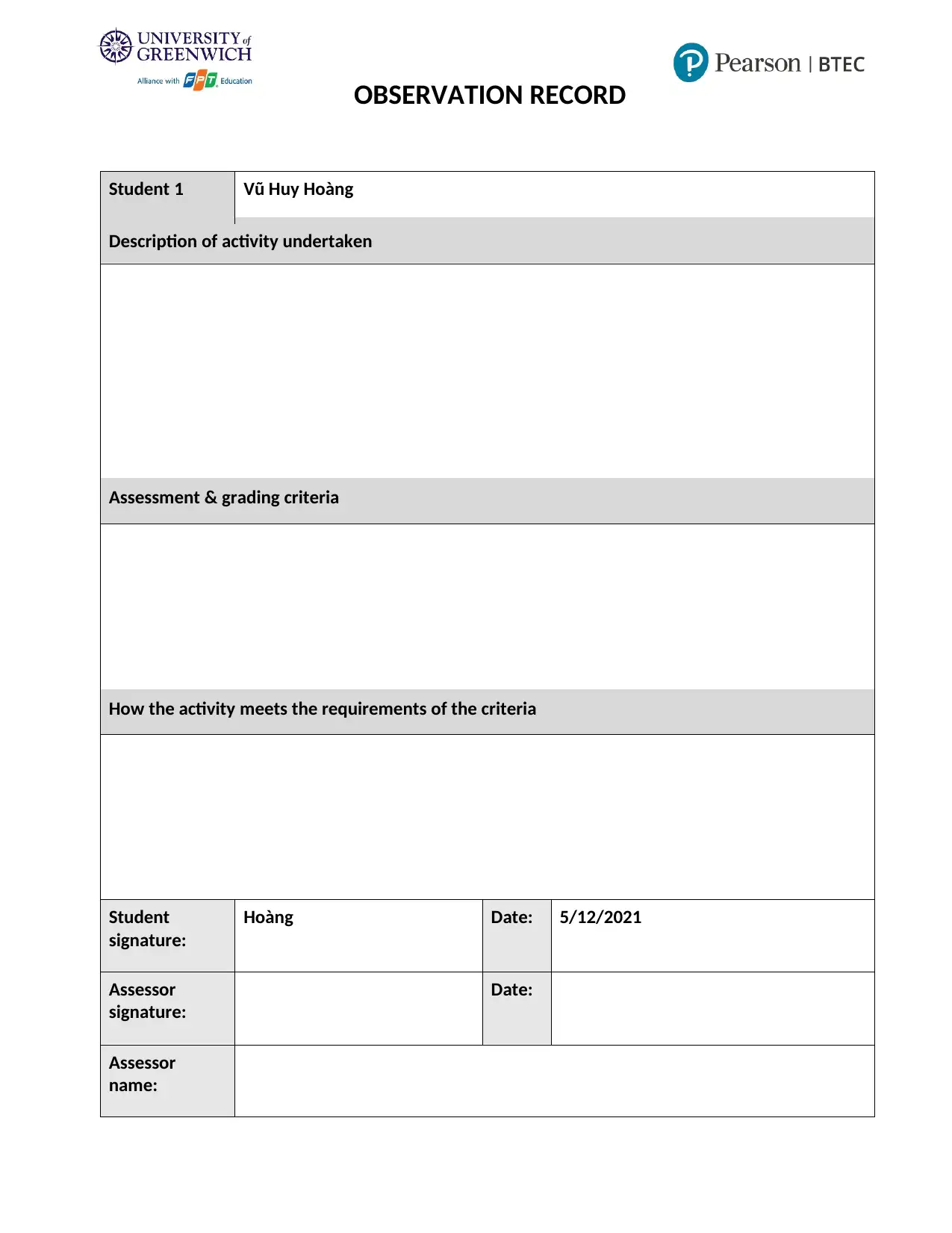
OBSERVATION RECORD
Student 1 Vũ Huy Hoàng
Description of activity undertaken
Assessment & grading criteria
How the activity meets the requirements of the criteria
Student
signature:
Hoàng Date: 5/12/2021
Assessor
signature:
Date:
Assessor
name:
Student 1 Vũ Huy Hoàng
Description of activity undertaken
Assessment & grading criteria
How the activity meets the requirements of the criteria
Student
signature:
Hoàng Date: 5/12/2021
Assessor
signature:
Date:
Assessor
name:
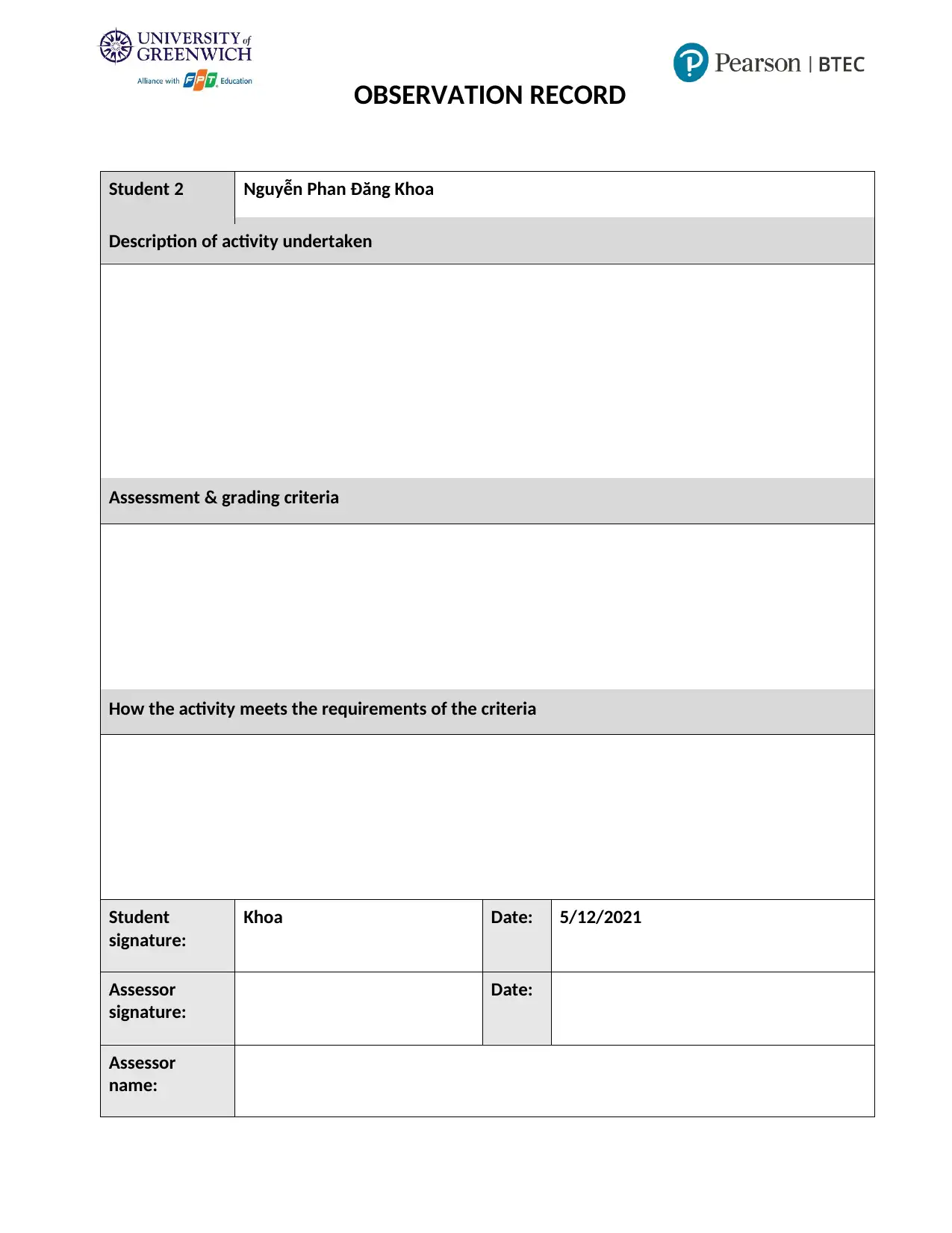
OBSERVATION RECORD
Student 2 Nguyễn Phan Đăng Khoa
Description of activity undertaken
Assessment & grading criteria
How the activity meets the requirements of the criteria
Student
signature:
Khoa Date: 5/12/2021
Assessor
signature:
Date:
Assessor
name:
Student 2 Nguyễn Phan Đăng Khoa
Description of activity undertaken
Assessment & grading criteria
How the activity meets the requirements of the criteria
Student
signature:
Khoa Date: 5/12/2021
Assessor
signature:
Date:
Assessor
name:
Secure Best Marks with AI Grader
Need help grading? Try our AI Grader for instant feedback on your assignments.
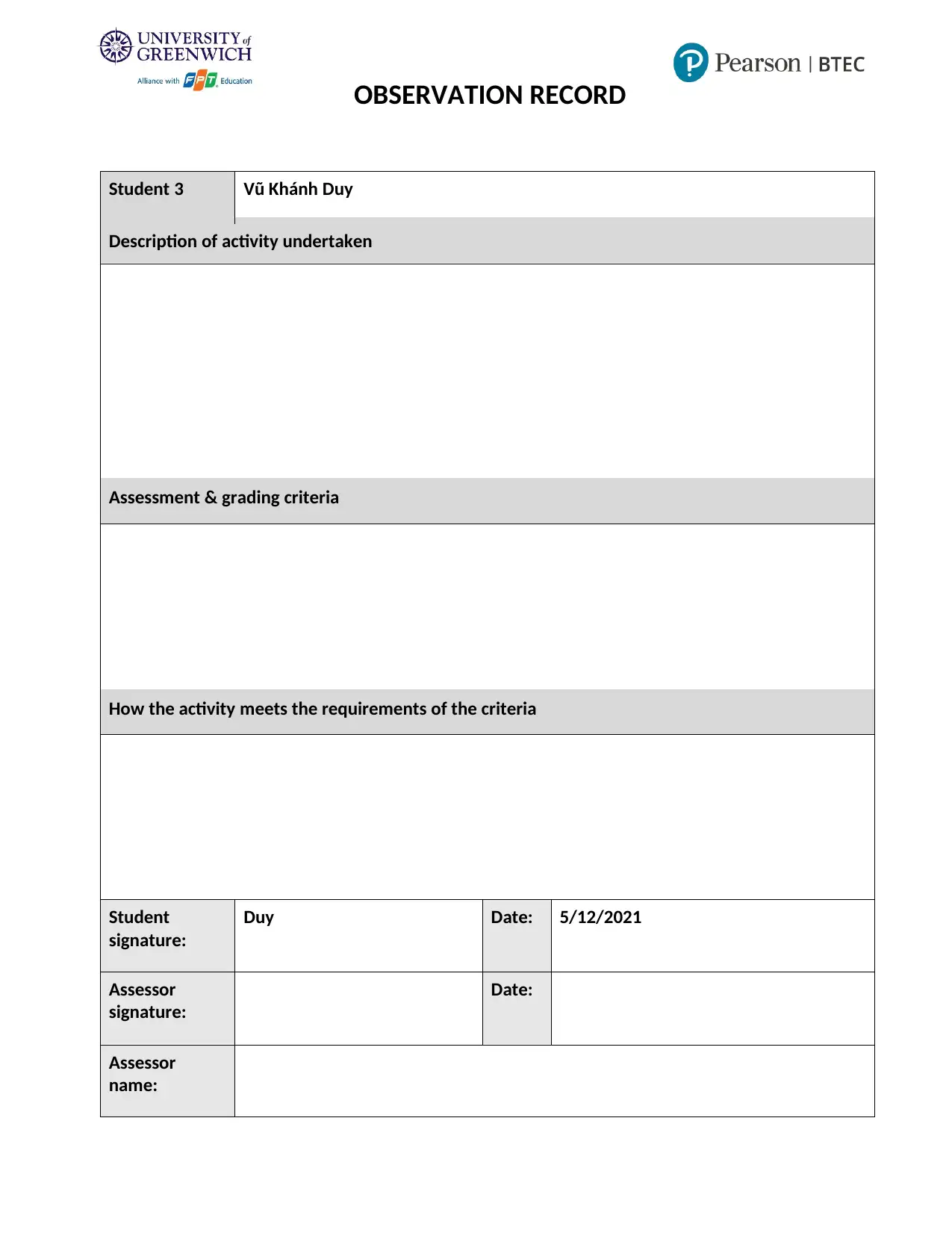
OBSERVATION RECORD
Student 3 Vũ Khánh Duy
Description of activity undertaken
Assessment & grading criteria
How the activity meets the requirements of the criteria
Student
signature:
Duy Date: 5/12/2021
Assessor
signature:
Date:
Assessor
name:
Student 3 Vũ Khánh Duy
Description of activity undertaken
Assessment & grading criteria
How the activity meets the requirements of the criteria
Student
signature:
Duy Date: 5/12/2021
Assessor
signature:
Date:
Assessor
name:
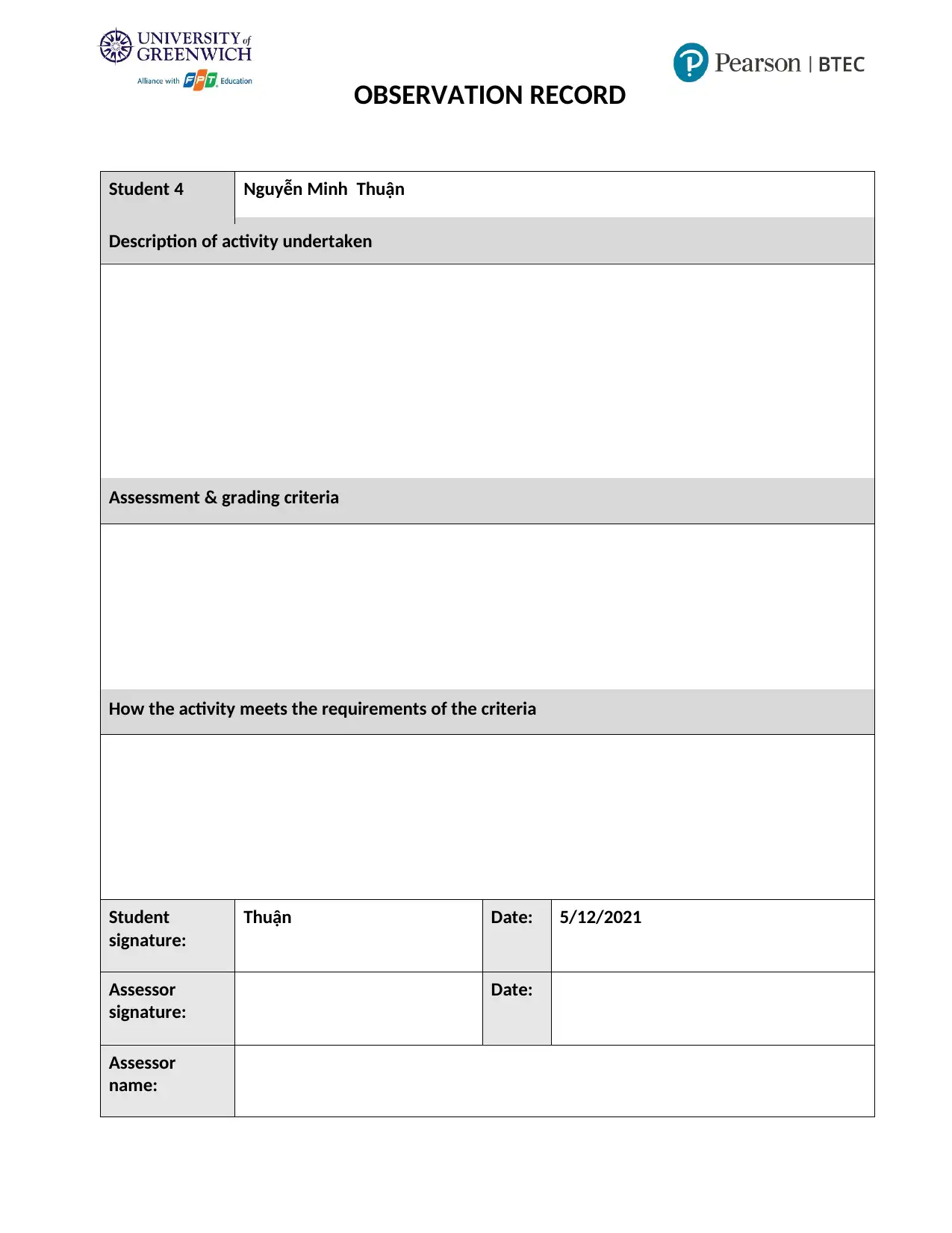
OBSERVATION RECORD
Student 4 Nguyễn Minh Thuận
Description of activity undertaken
Assessment & grading criteria
How the activity meets the requirements of the criteria
Student
signature:
Thuận Date: 5/12/2021
Assessor
signature:
Date:
Assessor
name:
Student 4 Nguyễn Minh Thuận
Description of activity undertaken
Assessment & grading criteria
How the activity meets the requirements of the criteria
Student
signature:
Thuận Date: 5/12/2021
Assessor
signature:
Date:
Assessor
name:
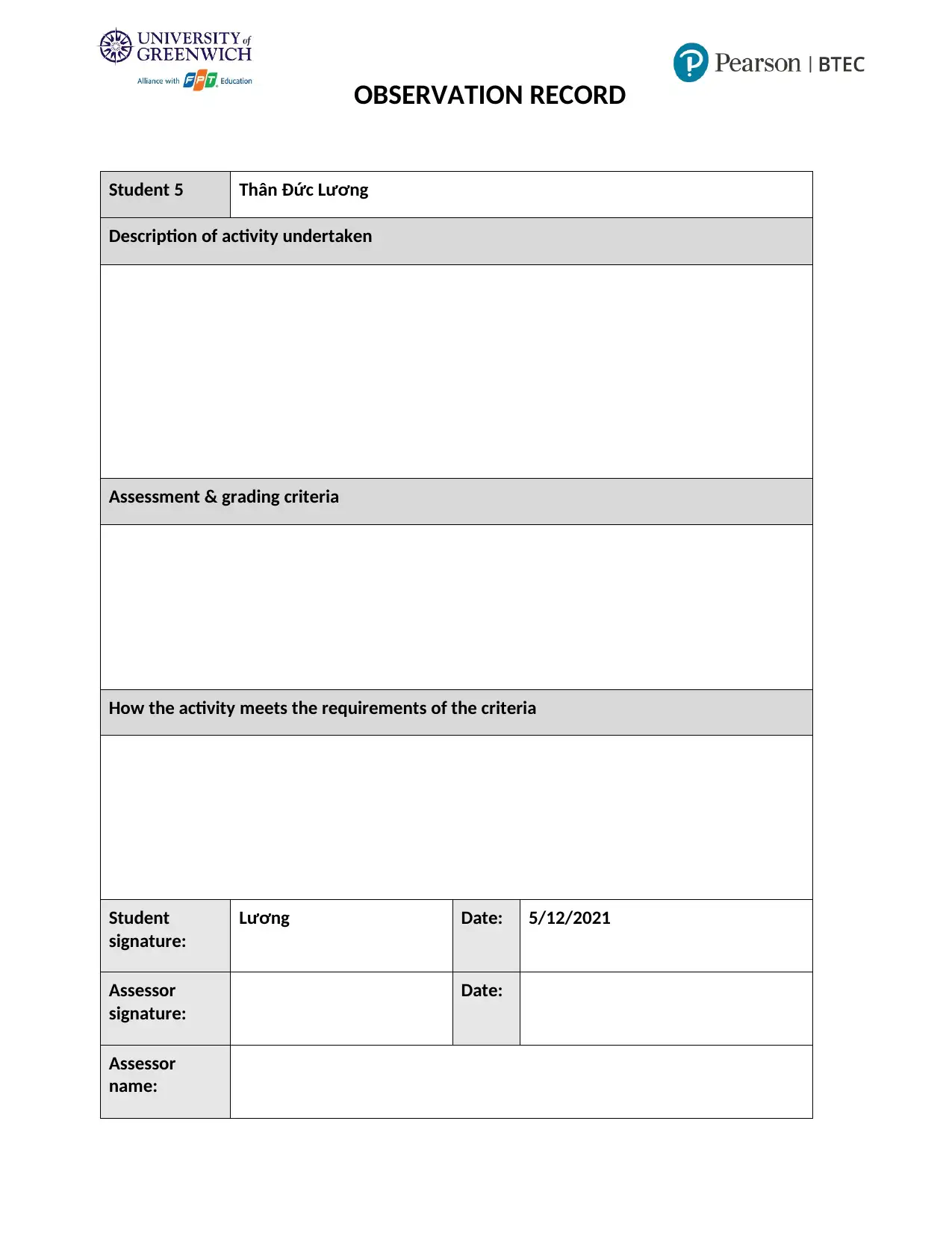
OBSERVATION RECORD
Student 5 Thân Đức Lương
Description of activity undertaken
Assessment & grading criteria
How the activity meets the requirements of the criteria
Student
signature:
Lương Date: 5/12/2021
Assessor
signature:
Date:
Assessor
name:
Student 5 Thân Đức Lương
Description of activity undertaken
Assessment & grading criteria
How the activity meets the requirements of the criteria
Student
signature:
Lương Date: 5/12/2021
Assessor
signature:
Date:
Assessor
name:
Paraphrase This Document
Need a fresh take? Get an instant paraphrase of this document with our AI Paraphraser
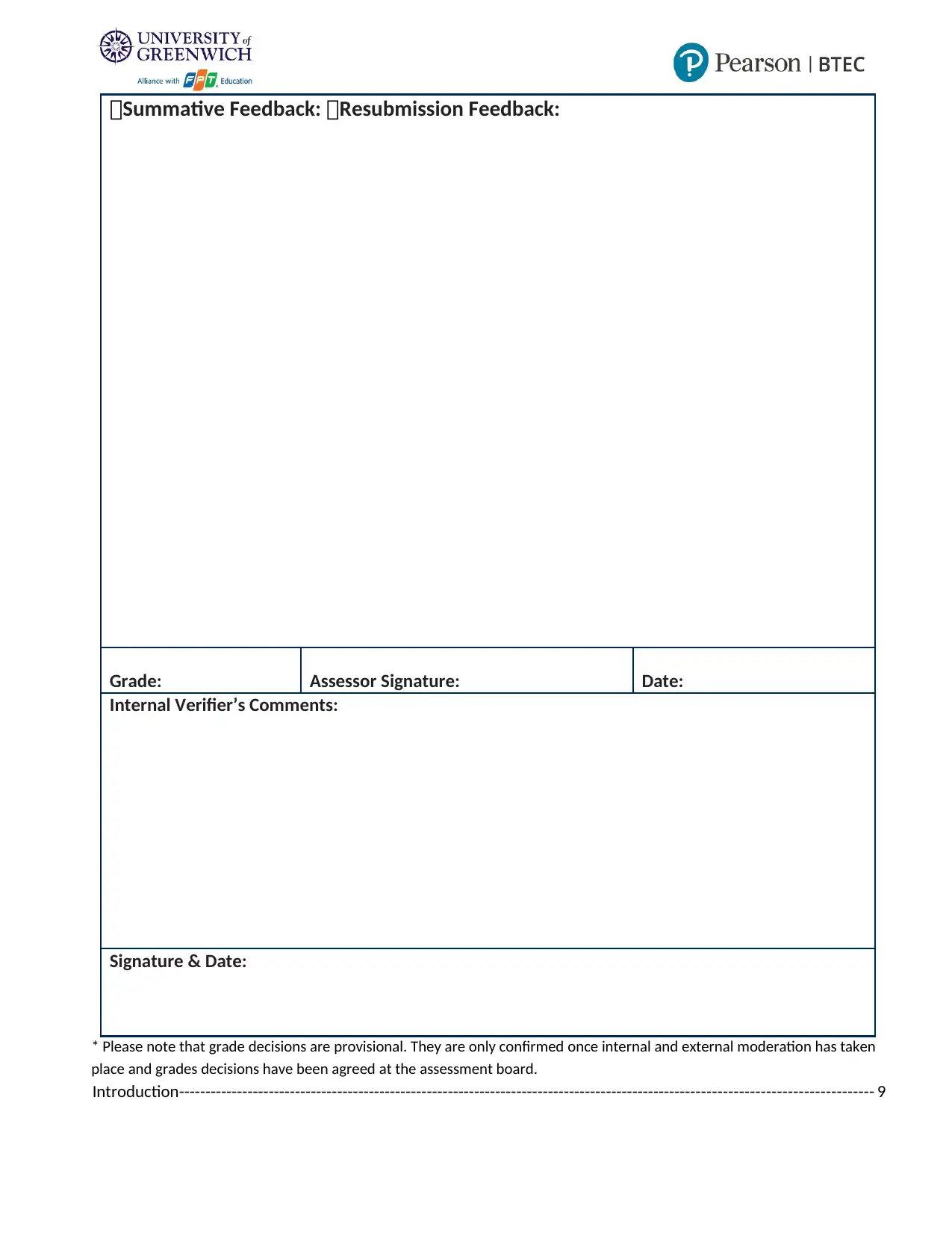
Summative Feedback: Resubmission Feedback:
Grade: Assessor Signature: Date:
Internal Verifier’s Comments:
Signature & Date:
* Please note that grade decisions are provisional. They are only confirmed once internal and external moderation has taken
place and grades decisions have been agreed at the assessment board.
Introduction----------------------------------------------------------------------------------------------------------------------------------- 9
Grade: Assessor Signature: Date:
Internal Verifier’s Comments:
Signature & Date:
* Please note that grade decisions are provisional. They are only confirmed once internal and external moderation has taken
place and grades decisions have been agreed at the assessment board.
Introduction----------------------------------------------------------------------------------------------------------------------------------- 9
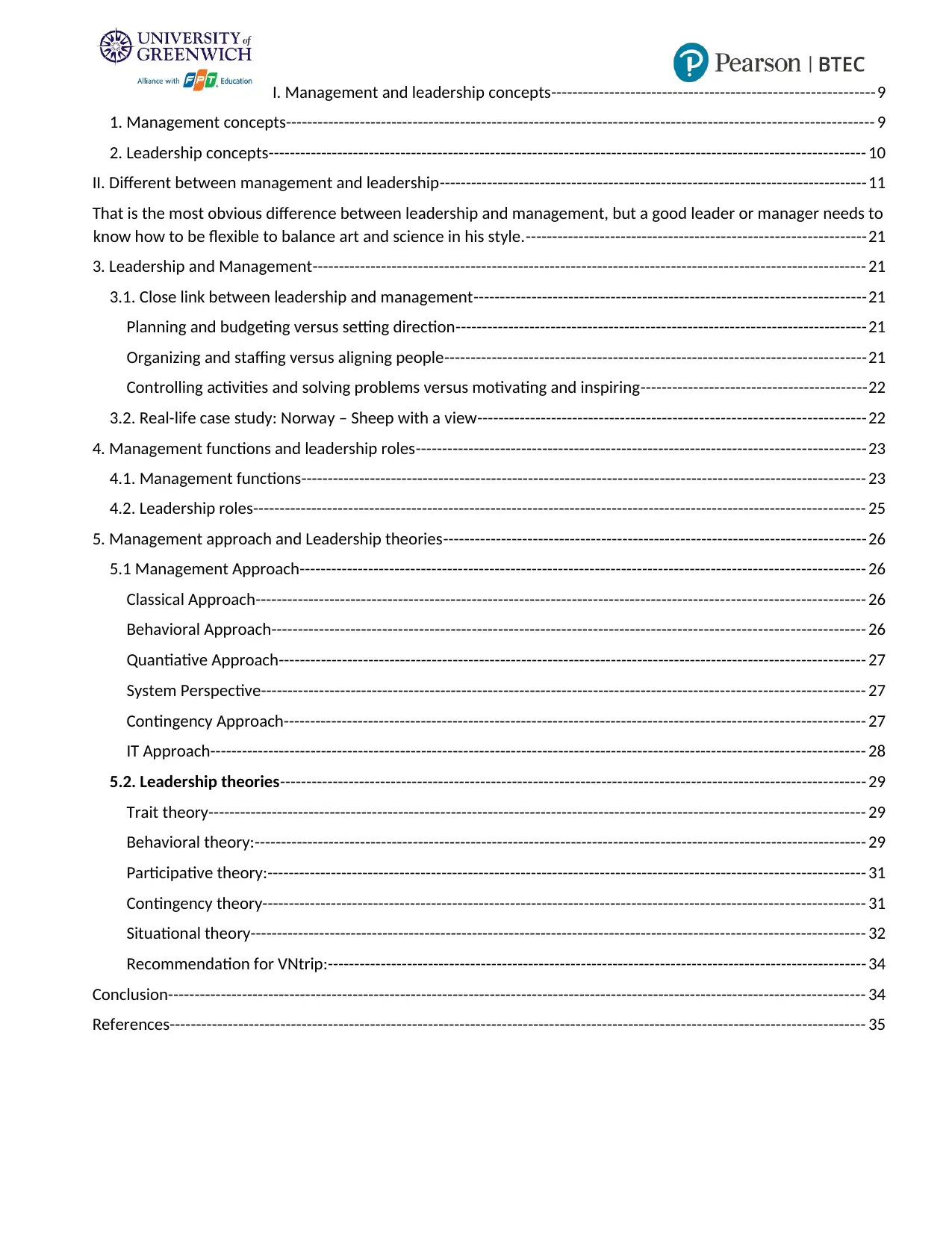
I. Management and leadership concepts-------------------------------------------------------------9
1. Management concepts--------------------------------------------------------------------------------------------------------------- 9
2. Leadership concepts----------------------------------------------------------------------------------------------------------------- 10
II. Different between management and leadership---------------------------------------------------------------------------------11
That is the most obvious difference between leadership and management, but a good leader or manager needs to
know how to be flexible to balance art and science in his style.----------------------------------------------------------------21
3. Leadership and Management--------------------------------------------------------------------------------------------------------- 21
3.1. Close link between leadership and management--------------------------------------------------------------------------21
Planning and budgeting versus setting direction------------------------------------------------------------------------------21
Organizing and staffing versus aligning people--------------------------------------------------------------------------------21
Controlling activities and solving problems versus motivating and inspiring-------------------------------------------22
3.2. Real-life case study: Norway – Sheep with a view-------------------------------------------------------------------------22
4. Management functions and leadership roles-------------------------------------------------------------------------------------23
4.1. Management functions----------------------------------------------------------------------------------------------------------- 23
4.2. Leadership roles-------------------------------------------------------------------------------------------------------------------- 25
5. Management approach and Leadership theories--------------------------------------------------------------------------------26
5.1 Management Approach----------------------------------------------------------------------------------------------------------- 26
Classical Approach------------------------------------------------------------------------------------------------------------------- 26
Behavioral Approach---------------------------------------------------------------------------------------------------------------- 26
Quantiative Approach--------------------------------------------------------------------------------------------------------------- 27
System Perspective------------------------------------------------------------------------------------------------------------------ 27
Contingency Approach-------------------------------------------------------------------------------------------------------------- 27
IT Approach---------------------------------------------------------------------------------------------------------------------------- 28
5.2. Leadership theories--------------------------------------------------------------------------------------------------------------- 29
Trait theory---------------------------------------------------------------------------------------------------------------------------- 29
Behavioral theory:-------------------------------------------------------------------------------------------------------------------- 29
Participative theory:----------------------------------------------------------------------------------------------------------------- 31
Contingency theory------------------------------------------------------------------------------------------------------------------ 31
Situational theory-------------------------------------------------------------------------------------------------------------------- 32
Recommendation for VNtrip:------------------------------------------------------------------------------------------------------ 34
Conclusion------------------------------------------------------------------------------------------------------------------------------------ 34
References------------------------------------------------------------------------------------------------------------------------------------ 35
1. Management concepts--------------------------------------------------------------------------------------------------------------- 9
2. Leadership concepts----------------------------------------------------------------------------------------------------------------- 10
II. Different between management and leadership---------------------------------------------------------------------------------11
That is the most obvious difference between leadership and management, but a good leader or manager needs to
know how to be flexible to balance art and science in his style.----------------------------------------------------------------21
3. Leadership and Management--------------------------------------------------------------------------------------------------------- 21
3.1. Close link between leadership and management--------------------------------------------------------------------------21
Planning and budgeting versus setting direction------------------------------------------------------------------------------21
Organizing and staffing versus aligning people--------------------------------------------------------------------------------21
Controlling activities and solving problems versus motivating and inspiring-------------------------------------------22
3.2. Real-life case study: Norway – Sheep with a view-------------------------------------------------------------------------22
4. Management functions and leadership roles-------------------------------------------------------------------------------------23
4.1. Management functions----------------------------------------------------------------------------------------------------------- 23
4.2. Leadership roles-------------------------------------------------------------------------------------------------------------------- 25
5. Management approach and Leadership theories--------------------------------------------------------------------------------26
5.1 Management Approach----------------------------------------------------------------------------------------------------------- 26
Classical Approach------------------------------------------------------------------------------------------------------------------- 26
Behavioral Approach---------------------------------------------------------------------------------------------------------------- 26
Quantiative Approach--------------------------------------------------------------------------------------------------------------- 27
System Perspective------------------------------------------------------------------------------------------------------------------ 27
Contingency Approach-------------------------------------------------------------------------------------------------------------- 27
IT Approach---------------------------------------------------------------------------------------------------------------------------- 28
5.2. Leadership theories--------------------------------------------------------------------------------------------------------------- 29
Trait theory---------------------------------------------------------------------------------------------------------------------------- 29
Behavioral theory:-------------------------------------------------------------------------------------------------------------------- 29
Participative theory:----------------------------------------------------------------------------------------------------------------- 31
Contingency theory------------------------------------------------------------------------------------------------------------------ 31
Situational theory-------------------------------------------------------------------------------------------------------------------- 32
Recommendation for VNtrip:------------------------------------------------------------------------------------------------------ 34
Conclusion------------------------------------------------------------------------------------------------------------------------------------ 34
References------------------------------------------------------------------------------------------------------------------------------------ 35
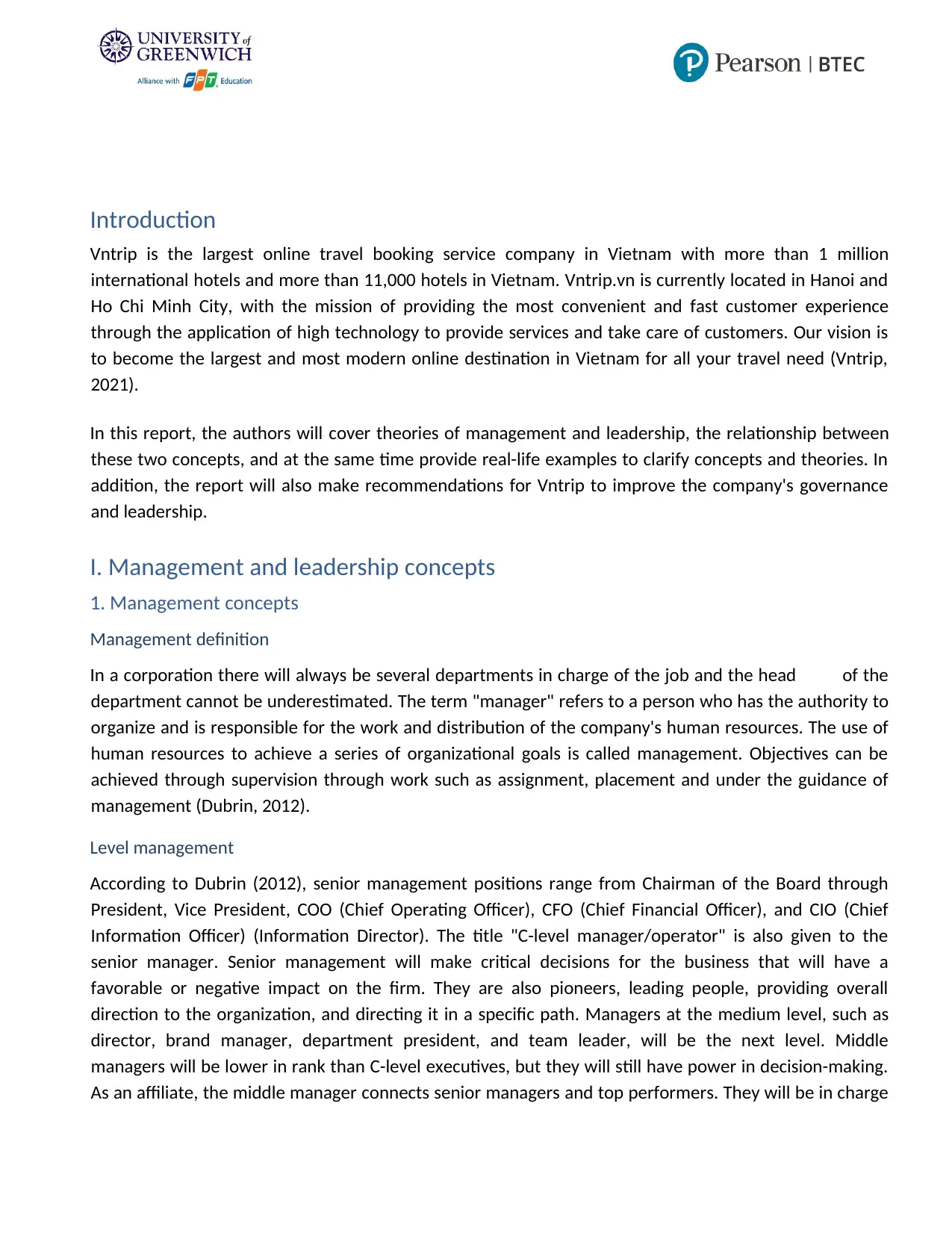
Introduction
Vntrip is the largest online travel booking service company in Vietnam with more than 1 million
international hotels and more than 11,000 hotels in Vietnam. Vntrip.vn is currently located in Hanoi and
Ho Chi Minh City, with the mission of providing the most convenient and fast customer experience
through the application of high technology to provide services and take care of customers. Our vision is
to become the largest and most modern online destination in Vietnam for all your travel need (Vntrip,
2021).
In this report, the authors will cover theories of management and leadership, the relationship between
these two concepts, and at the same time provide real-life examples to clarify concepts and theories. In
addition, the report will also make recommendations for Vntrip to improve the company's governance
and leadership.
I. Management and leadership concepts
1. Management concepts
Management definition
In a corporation there will always be several departments in charge of the job and the head of the
department cannot be underestimated. The term "manager" refers to a person who has the authority to
organize and is responsible for the work and distribution of the company's human resources. The use of
human resources to achieve a series of organizational goals is called management. Objectives can be
achieved through supervision through work such as assignment, placement and under the guidance of
management (Dubrin, 2012).
Level management
According to Dubrin (2012), senior management positions range from Chairman of the Board through
President, Vice President, COO (Chief Operating Officer), CFO (Chief Financial Officer), and CIO (Chief
Information Officer) (Information Director). The title "C-level manager/operator" is also given to the
senior manager. Senior management will make critical decisions for the business that will have a
favorable or negative impact on the firm. They are also pioneers, leading people, providing overall
direction to the organization, and directing it in a specific path. Managers at the medium level, such as
director, brand manager, department president, and team leader, will be the next level. Middle
managers will be lower in rank than C-level executives, but they will still have power in decision-making.
As an affiliate, the middle manager connects senior managers and top performers. They will be in charge
Vntrip is the largest online travel booking service company in Vietnam with more than 1 million
international hotels and more than 11,000 hotels in Vietnam. Vntrip.vn is currently located in Hanoi and
Ho Chi Minh City, with the mission of providing the most convenient and fast customer experience
through the application of high technology to provide services and take care of customers. Our vision is
to become the largest and most modern online destination in Vietnam for all your travel need (Vntrip,
2021).
In this report, the authors will cover theories of management and leadership, the relationship between
these two concepts, and at the same time provide real-life examples to clarify concepts and theories. In
addition, the report will also make recommendations for Vntrip to improve the company's governance
and leadership.
I. Management and leadership concepts
1. Management concepts
Management definition
In a corporation there will always be several departments in charge of the job and the head of the
department cannot be underestimated. The term "manager" refers to a person who has the authority to
organize and is responsible for the work and distribution of the company's human resources. The use of
human resources to achieve a series of organizational goals is called management. Objectives can be
achieved through supervision through work such as assignment, placement and under the guidance of
management (Dubrin, 2012).
Level management
According to Dubrin (2012), senior management positions range from Chairman of the Board through
President, Vice President, COO (Chief Operating Officer), CFO (Chief Financial Officer), and CIO (Chief
Information Officer) (Information Director). The title "C-level manager/operator" is also given to the
senior manager. Senior management will make critical decisions for the business that will have a
favorable or negative impact on the firm. They are also pioneers, leading people, providing overall
direction to the organization, and directing it in a specific path. Managers at the medium level, such as
director, brand manager, department president, and team leader, will be the next level. Middle
managers will be lower in rank than C-level executives, but they will still have power in decision-making.
As an affiliate, the middle manager connects senior managers and top performers. They will be in charge
Secure Best Marks with AI Grader
Need help grading? Try our AI Grader for instant feedback on your assignments.
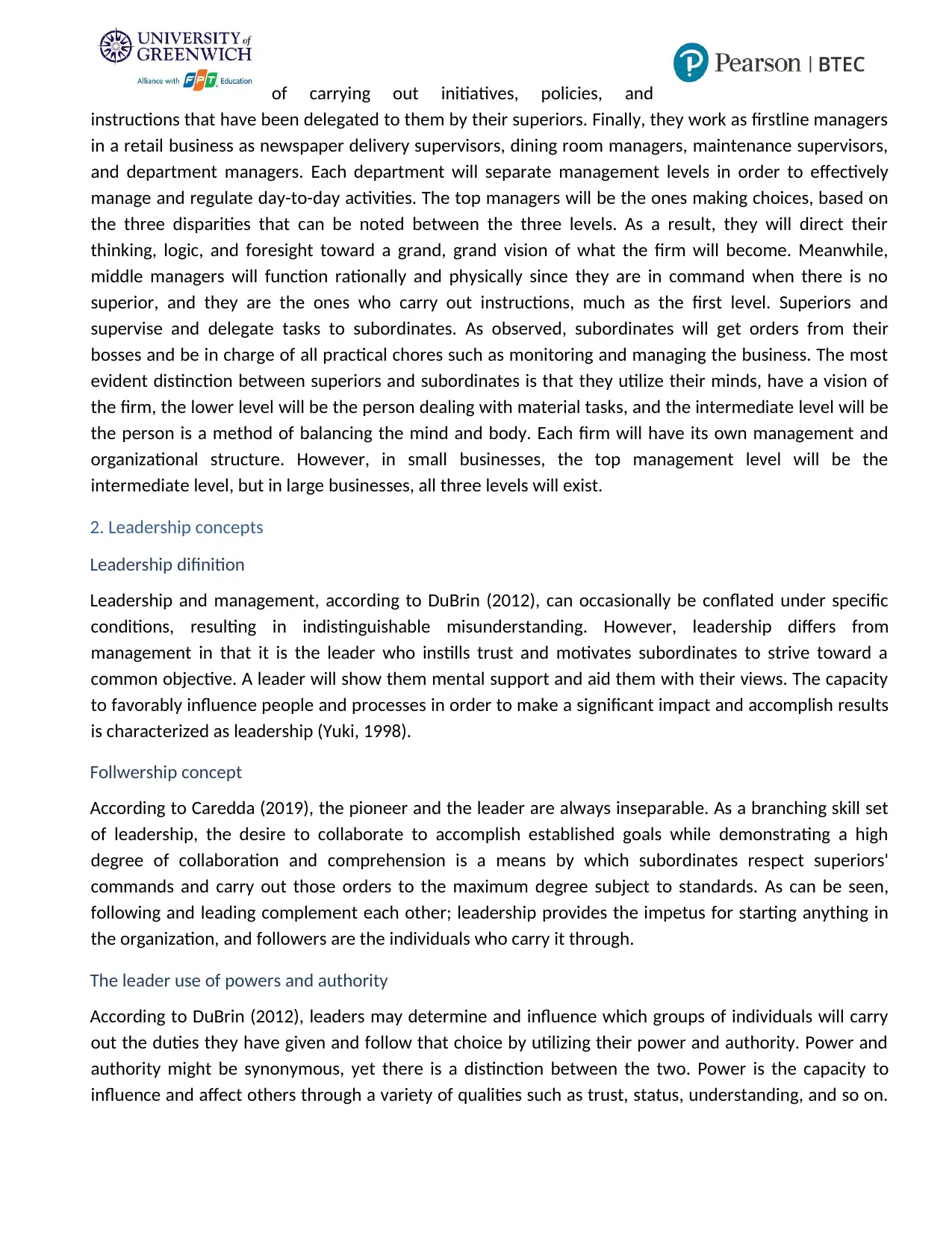
of carrying out initiatives, policies, and
instructions that have been delegated to them by their superiors. Finally, they work as firstline managers
in a retail business as newspaper delivery supervisors, dining room managers, maintenance supervisors,
and department managers. Each department will separate management levels in order to effectively
manage and regulate day-to-day activities. The top managers will be the ones making choices, based on
the three disparities that can be noted between the three levels. As a result, they will direct their
thinking, logic, and foresight toward a grand, grand vision of what the firm will become. Meanwhile,
middle managers will function rationally and physically since they are in command when there is no
superior, and they are the ones who carry out instructions, much as the first level. Superiors and
supervise and delegate tasks to subordinates. As observed, subordinates will get orders from their
bosses and be in charge of all practical chores such as monitoring and managing the business. The most
evident distinction between superiors and subordinates is that they utilize their minds, have a vision of
the firm, the lower level will be the person dealing with material tasks, and the intermediate level will be
the person is a method of balancing the mind and body. Each firm will have its own management and
organizational structure. However, in small businesses, the top management level will be the
intermediate level, but in large businesses, all three levels will exist.
2. Leadership concepts
Leadership difinition
Leadership and management, according to DuBrin (2012), can occasionally be conflated under specific
conditions, resulting in indistinguishable misunderstanding. However, leadership differs from
management in that it is the leader who instills trust and motivates subordinates to strive toward a
common objective. A leader will show them mental support and aid them with their views. The capacity
to favorably influence people and processes in order to make a significant impact and accomplish results
is characterized as leadership (Yuki, 1998).
Follwership concept
According to Caredda (2019), the pioneer and the leader are always inseparable. As a branching skill set
of leadership, the desire to collaborate to accomplish established goals while demonstrating a high
degree of collaboration and comprehension is a means by which subordinates respect superiors'
commands and carry out those orders to the maximum degree subject to standards. As can be seen,
following and leading complement each other; leadership provides the impetus for starting anything in
the organization, and followers are the individuals who carry it through.
The leader use of powers and authority
According to DuBrin (2012), leaders may determine and influence which groups of individuals will carry
out the duties they have given and follow that choice by utilizing their power and authority. Power and
authority might be synonymous, yet there is a distinction between the two. Power is the capacity to
influence and affect others through a variety of qualities such as trust, status, understanding, and so on.
instructions that have been delegated to them by their superiors. Finally, they work as firstline managers
in a retail business as newspaper delivery supervisors, dining room managers, maintenance supervisors,
and department managers. Each department will separate management levels in order to effectively
manage and regulate day-to-day activities. The top managers will be the ones making choices, based on
the three disparities that can be noted between the three levels. As a result, they will direct their
thinking, logic, and foresight toward a grand, grand vision of what the firm will become. Meanwhile,
middle managers will function rationally and physically since they are in command when there is no
superior, and they are the ones who carry out instructions, much as the first level. Superiors and
supervise and delegate tasks to subordinates. As observed, subordinates will get orders from their
bosses and be in charge of all practical chores such as monitoring and managing the business. The most
evident distinction between superiors and subordinates is that they utilize their minds, have a vision of
the firm, the lower level will be the person dealing with material tasks, and the intermediate level will be
the person is a method of balancing the mind and body. Each firm will have its own management and
organizational structure. However, in small businesses, the top management level will be the
intermediate level, but in large businesses, all three levels will exist.
2. Leadership concepts
Leadership difinition
Leadership and management, according to DuBrin (2012), can occasionally be conflated under specific
conditions, resulting in indistinguishable misunderstanding. However, leadership differs from
management in that it is the leader who instills trust and motivates subordinates to strive toward a
common objective. A leader will show them mental support and aid them with their views. The capacity
to favorably influence people and processes in order to make a significant impact and accomplish results
is characterized as leadership (Yuki, 1998).
Follwership concept
According to Caredda (2019), the pioneer and the leader are always inseparable. As a branching skill set
of leadership, the desire to collaborate to accomplish established goals while demonstrating a high
degree of collaboration and comprehension is a means by which subordinates respect superiors'
commands and carry out those orders to the maximum degree subject to standards. As can be seen,
following and leading complement each other; leadership provides the impetus for starting anything in
the organization, and followers are the individuals who carry it through.
The leader use of powers and authority
According to DuBrin (2012), leaders may determine and influence which groups of individuals will carry
out the duties they have given and follow that choice by utilizing their power and authority. Power and
authority might be synonymous, yet there is a distinction between the two. Power is the capacity to
influence and affect others through a variety of qualities such as trust, status, understanding, and so on.
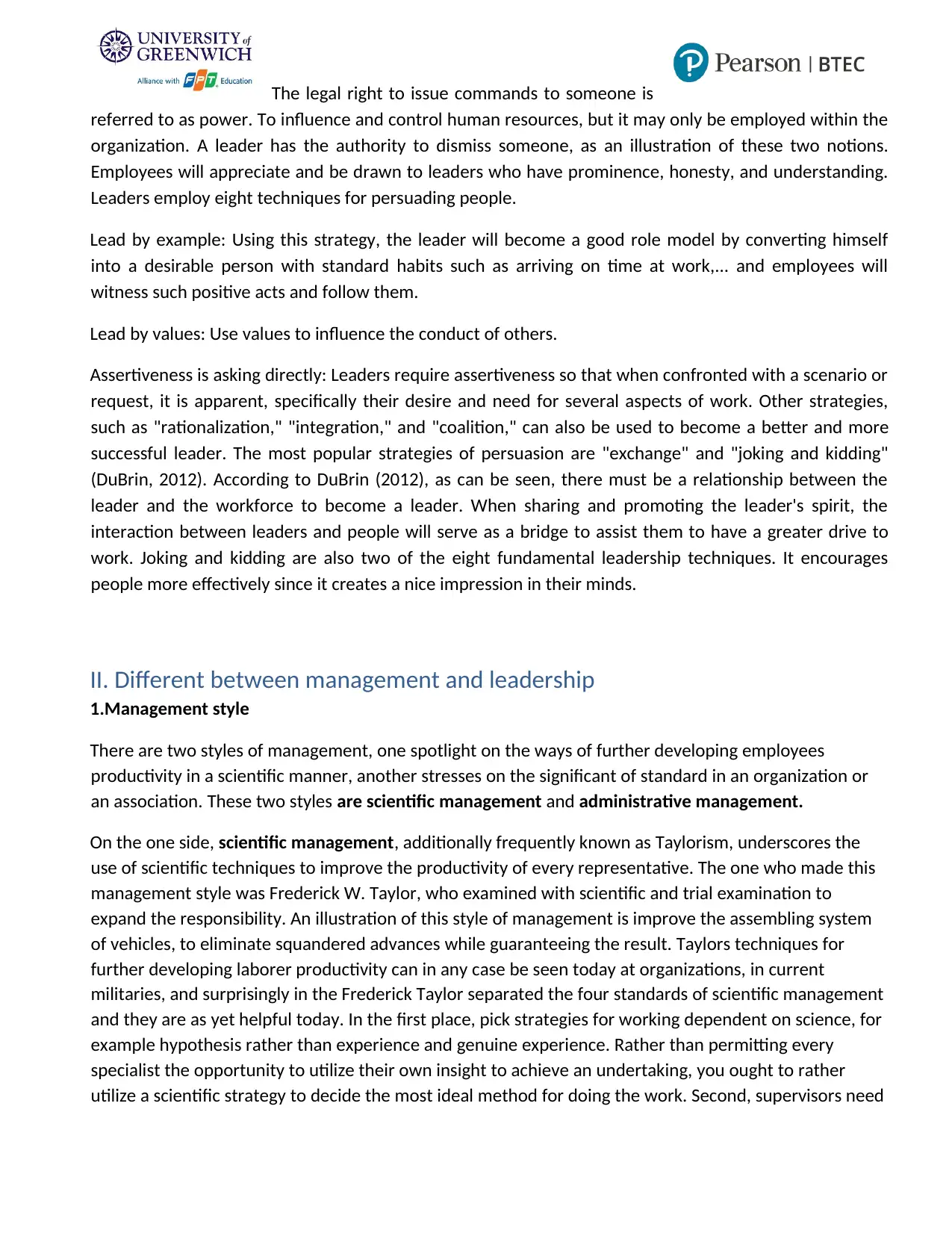
The legal right to issue commands to someone is
referred to as power. To influence and control human resources, but it may only be employed within the
organization. A leader has the authority to dismiss someone, as an illustration of these two notions.
Employees will appreciate and be drawn to leaders who have prominence, honesty, and understanding.
Leaders employ eight techniques for persuading people.
Lead by example: Using this strategy, the leader will become a good role model by converting himself
into a desirable person with standard habits such as arriving on time at work,... and employees will
witness such positive acts and follow them.
Lead by values: Use values to influence the conduct of others.
Assertiveness is asking directly: Leaders require assertiveness so that when confronted with a scenario or
request, it is apparent, specifically their desire and need for several aspects of work. Other strategies,
such as "rationalization," "integration," and "coalition," can also be used to become a better and more
successful leader. The most popular strategies of persuasion are "exchange" and "joking and kidding"
(DuBrin, 2012). According to DuBrin (2012), as can be seen, there must be a relationship between the
leader and the workforce to become a leader. When sharing and promoting the leader's spirit, the
interaction between leaders and people will serve as a bridge to assist them to have a greater drive to
work. Joking and kidding are also two of the eight fundamental leadership techniques. It encourages
people more effectively since it creates a nice impression in their minds.
II. Different between management and leadership
1.Management style
There are two styles of management, one spotlight on the ways of further developing employees
productivity in a scientific manner, another stresses on the significant of standard in an organization or
an association. These two styles are scientific management and administrative management.
On the one side, scientific management, additionally frequently known as Taylorism, underscores the
use of scientific techniques to improve the productivity of every representative. The one who made this
management style was Frederick W. Taylor, who examined with scientific and trial examination to
expand the responsibility. An illustration of this style of management is improve the assembling system
of vehicles, to eliminate squandered advances while guaranteeing the result. Taylors techniques for
further developing laborer productivity can in any case be seen today at organizations, in current
militaries, and surprisingly in the Frederick Taylor separated the four standards of scientific management
and they are as yet helpful today. In the first place, pick strategies for working dependent on science, for
example hypothesis rather than experience and genuine experience. Rather than permitting every
specialist the opportunity to utilize their own insight to achieve an undertaking, you ought to rather
utilize a scientific strategy to decide the most ideal method for doing the work. Second, supervisors need
referred to as power. To influence and control human resources, but it may only be employed within the
organization. A leader has the authority to dismiss someone, as an illustration of these two notions.
Employees will appreciate and be drawn to leaders who have prominence, honesty, and understanding.
Leaders employ eight techniques for persuading people.
Lead by example: Using this strategy, the leader will become a good role model by converting himself
into a desirable person with standard habits such as arriving on time at work,... and employees will
witness such positive acts and follow them.
Lead by values: Use values to influence the conduct of others.
Assertiveness is asking directly: Leaders require assertiveness so that when confronted with a scenario or
request, it is apparent, specifically their desire and need for several aspects of work. Other strategies,
such as "rationalization," "integration," and "coalition," can also be used to become a better and more
successful leader. The most popular strategies of persuasion are "exchange" and "joking and kidding"
(DuBrin, 2012). According to DuBrin (2012), as can be seen, there must be a relationship between the
leader and the workforce to become a leader. When sharing and promoting the leader's spirit, the
interaction between leaders and people will serve as a bridge to assist them to have a greater drive to
work. Joking and kidding are also two of the eight fundamental leadership techniques. It encourages
people more effectively since it creates a nice impression in their minds.
II. Different between management and leadership
1.Management style
There are two styles of management, one spotlight on the ways of further developing employees
productivity in a scientific manner, another stresses on the significant of standard in an organization or
an association. These two styles are scientific management and administrative management.
On the one side, scientific management, additionally frequently known as Taylorism, underscores the
use of scientific techniques to improve the productivity of every representative. The one who made this
management style was Frederick W. Taylor, who examined with scientific and trial examination to
expand the responsibility. An illustration of this style of management is improve the assembling system
of vehicles, to eliminate squandered advances while guaranteeing the result. Taylors techniques for
further developing laborer productivity can in any case be seen today at organizations, in current
militaries, and surprisingly in the Frederick Taylor separated the four standards of scientific management
and they are as yet helpful today. In the first place, pick strategies for working dependent on science, for
example hypothesis rather than experience and genuine experience. Rather than permitting every
specialist the opportunity to utilize their own insight to achieve an undertaking, you ought to rather
utilize a scientific strategy to decide the most ideal method for doing the work. Second, supervisors need
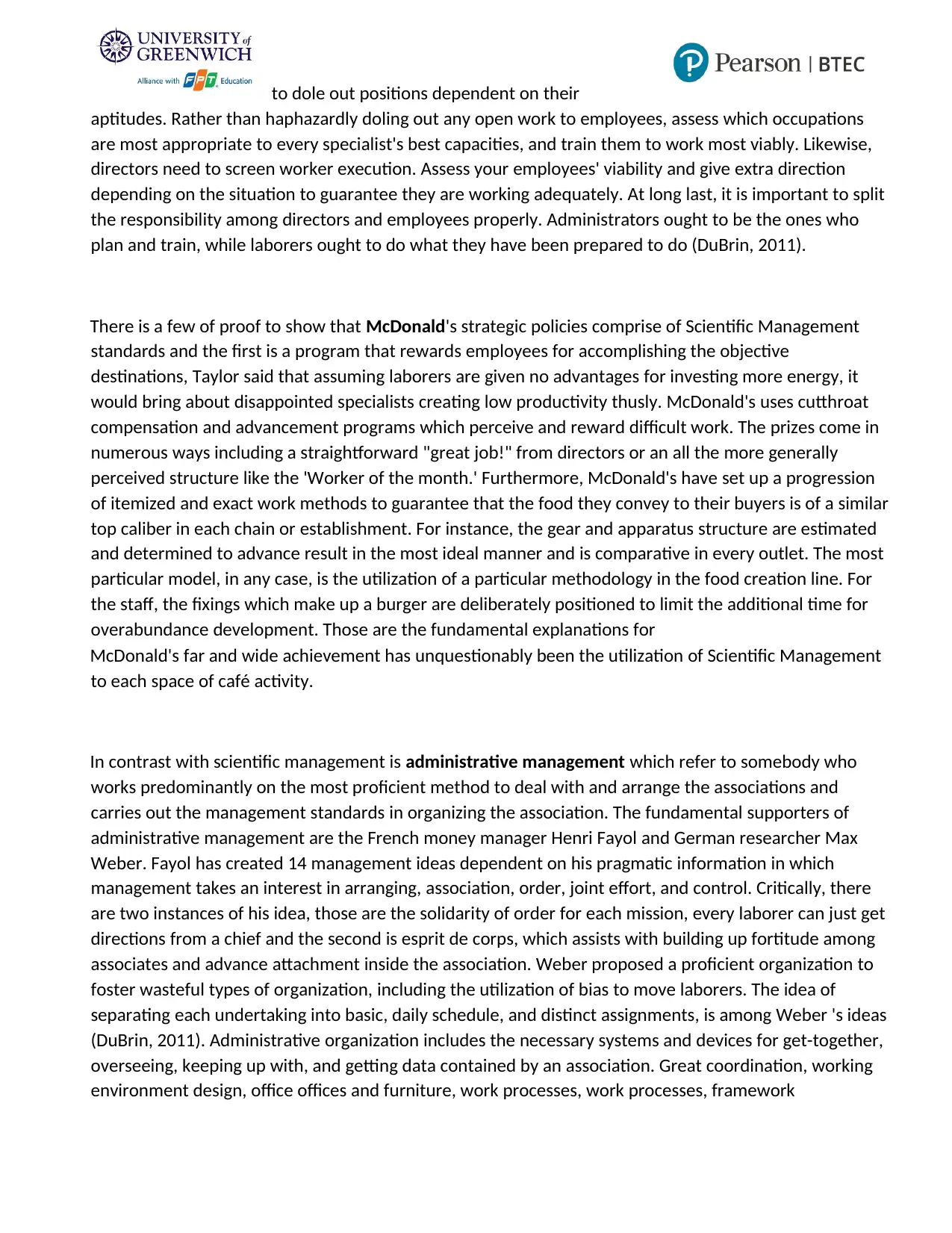
to dole out positions dependent on their
aptitudes. Rather than haphazardly doling out any open work to employees, assess which occupations
are most appropriate to every specialist's best capacities, and train them to work most viably. Likewise,
directors need to screen worker execution. Assess your employees' viability and give extra direction
depending on the situation to guarantee they are working adequately. At long last, it is important to split
the responsibility among directors and employees properly. Administrators ought to be the ones who
plan and train, while laborers ought to do what they have been prepared to do (DuBrin, 2011).
There is a few of proof to show that McDonald's strategic policies comprise of Scientific Management
standards and the first is a program that rewards employees for accomplishing the objective
destinations, Taylor said that assuming laborers are given no advantages for investing more energy, it
would bring about disappointed specialists creating low productivity thusly. McDonald's uses cutthroat
compensation and advancement programs which perceive and reward difficult work. The prizes come in
numerous ways including a straightforward "great job!" from directors or an all the more generally
perceived structure like the 'Worker of the month.' Furthermore, McDonald's have set up a progression
of itemized and exact work methods to guarantee that the food they convey to their buyers is of a similar
top caliber in each chain or establishment. For instance, the gear and apparatus structure are estimated
and determined to advance result in the most ideal manner and is comparative in every outlet. The most
particular model, in any case, is the utilization of a particular methodology in the food creation line. For
the staff, the fixings which make up a burger are deliberately positioned to limit the additional time for
overabundance development. Those are the fundamental explanations for
McDonald's far and wide achievement has unquestionably been the utilization of Scientific Management
to each space of café activity.
In contrast with scientific management is administrative management which refer to somebody who
works predominantly on the most proficient method to deal with and arrange the associations and
carries out the management standards in organizing the association. The fundamental supporters of
administrative management are the French money manager Henri Fayol and German researcher Max
Weber. Fayol has created 14 management ideas dependent on his pragmatic information in which
management takes an interest in arranging, association, order, joint effort, and control. Critically, there
are two instances of his idea, those are the solidarity of order for each mission, every laborer can just get
directions from a chief and the second is esprit de corps, which assists with building up fortitude among
associates and advance attachment inside the association. Weber proposed a proficient organization to
foster wasteful types of organization, including the utilization of bias to move laborers. The idea of
separating each undertaking into basic, daily schedule, and distinct assignments, is among Weber 's ideas
(DuBrin, 2011). Administrative organization includes the necessary systems and devices for get-together,
overseeing, keeping up with, and getting data contained by an association. Great coordination, working
environment design, office offices and furniture, work processes, work processes, framework
aptitudes. Rather than haphazardly doling out any open work to employees, assess which occupations
are most appropriate to every specialist's best capacities, and train them to work most viably. Likewise,
directors need to screen worker execution. Assess your employees' viability and give extra direction
depending on the situation to guarantee they are working adequately. At long last, it is important to split
the responsibility among directors and employees properly. Administrators ought to be the ones who
plan and train, while laborers ought to do what they have been prepared to do (DuBrin, 2011).
There is a few of proof to show that McDonald's strategic policies comprise of Scientific Management
standards and the first is a program that rewards employees for accomplishing the objective
destinations, Taylor said that assuming laborers are given no advantages for investing more energy, it
would bring about disappointed specialists creating low productivity thusly. McDonald's uses cutthroat
compensation and advancement programs which perceive and reward difficult work. The prizes come in
numerous ways including a straightforward "great job!" from directors or an all the more generally
perceived structure like the 'Worker of the month.' Furthermore, McDonald's have set up a progression
of itemized and exact work methods to guarantee that the food they convey to their buyers is of a similar
top caliber in each chain or establishment. For instance, the gear and apparatus structure are estimated
and determined to advance result in the most ideal manner and is comparative in every outlet. The most
particular model, in any case, is the utilization of a particular methodology in the food creation line. For
the staff, the fixings which make up a burger are deliberately positioned to limit the additional time for
overabundance development. Those are the fundamental explanations for
McDonald's far and wide achievement has unquestionably been the utilization of Scientific Management
to each space of café activity.
In contrast with scientific management is administrative management which refer to somebody who
works predominantly on the most proficient method to deal with and arrange the associations and
carries out the management standards in organizing the association. The fundamental supporters of
administrative management are the French money manager Henri Fayol and German researcher Max
Weber. Fayol has created 14 management ideas dependent on his pragmatic information in which
management takes an interest in arranging, association, order, joint effort, and control. Critically, there
are two instances of his idea, those are the solidarity of order for each mission, every laborer can just get
directions from a chief and the second is esprit de corps, which assists with building up fortitude among
associates and advance attachment inside the association. Weber proposed a proficient organization to
foster wasteful types of organization, including the utilization of bias to move laborers. The idea of
separating each undertaking into basic, daily schedule, and distinct assignments, is among Weber 's ideas
(DuBrin, 2011). Administrative organization includes the necessary systems and devices for get-together,
overseeing, keeping up with, and getting data contained by an association. Great coordination, working
environment design, office offices and furniture, work processes, work processes, framework
Paraphrase This Document
Need a fresh take? Get an instant paraphrase of this document with our AI Paraphraser
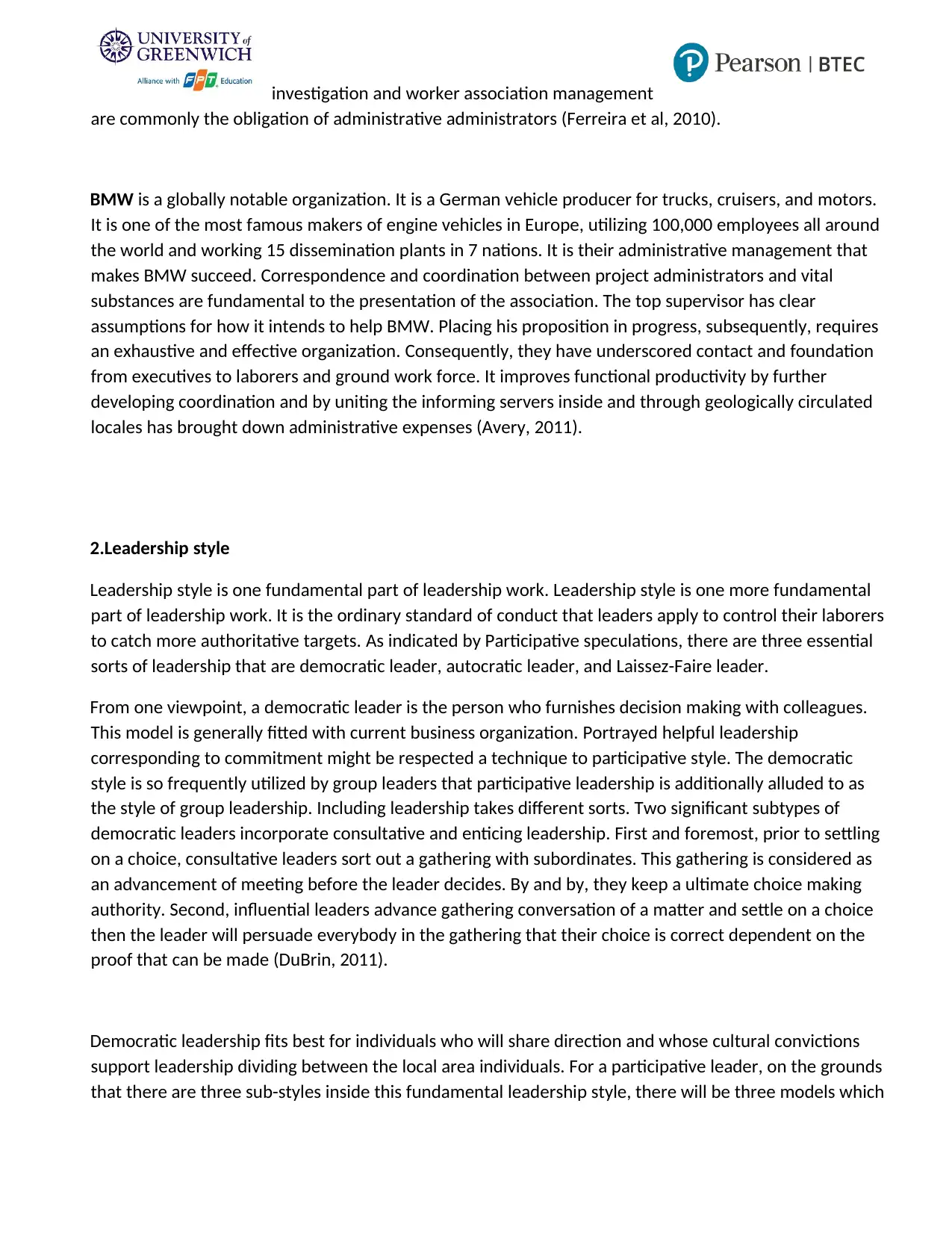
investigation and worker association management
are commonly the obligation of administrative administrators (Ferreira et al, 2010).
BMW is a globally notable organization. It is a German vehicle producer for trucks, cruisers, and motors.
It is one of the most famous makers of engine vehicles in Europe, utilizing 100,000 employees all around
the world and working 15 dissemination plants in 7 nations. It is their administrative management that
makes BMW succeed. Correspondence and coordination between project administrators and vital
substances are fundamental to the presentation of the association. The top supervisor has clear
assumptions for how it intends to help BMW. Placing his proposition in progress, subsequently, requires
an exhaustive and effective organization. Consequently, they have underscored contact and foundation
from executives to laborers and ground work force. It improves functional productivity by further
developing coordination and by uniting the informing servers inside and through geologically circulated
locales has brought down administrative expenses (Avery, 2011).
2.Leadership style
Leadership style is one fundamental part of leadership work. Leadership style is one more fundamental
part of leadership work. It is the ordinary standard of conduct that leaders apply to control their laborers
to catch more authoritative targets. As indicated by Participative speculations, there are three essential
sorts of leadership that are democratic leader, autocratic leader, and Laissez-Faire leader.
From one viewpoint, a democratic leader is the person who furnishes decision making with colleagues.
This model is generally fitted with current business organization. Portrayed helpful leadership
corresponding to commitment might be respected a technique to participative style. The democratic
style is so frequently utilized by group leaders that participative leadership is additionally alluded to as
the style of group leadership. Including leadership takes different sorts. Two significant subtypes of
democratic leaders incorporate consultative and enticing leadership. First and foremost, prior to settling
on a choice, consultative leaders sort out a gathering with subordinates. This gathering is considered as
an advancement of meeting before the leader decides. By and by, they keep a ultimate choice making
authority. Second, influential leaders advance gathering conversation of a matter and settle on a choice
then the leader will persuade everybody in the gathering that their choice is correct dependent on the
proof that can be made (DuBrin, 2011).
Democratic leadership fits best for individuals who will share direction and whose cultural convictions
support leadership dividing between the local area individuals. For a participative leader, on the grounds
that there are three sub-styles inside this fundamental leadership style, there will be three models which
are commonly the obligation of administrative administrators (Ferreira et al, 2010).
BMW is a globally notable organization. It is a German vehicle producer for trucks, cruisers, and motors.
It is one of the most famous makers of engine vehicles in Europe, utilizing 100,000 employees all around
the world and working 15 dissemination plants in 7 nations. It is their administrative management that
makes BMW succeed. Correspondence and coordination between project administrators and vital
substances are fundamental to the presentation of the association. The top supervisor has clear
assumptions for how it intends to help BMW. Placing his proposition in progress, subsequently, requires
an exhaustive and effective organization. Consequently, they have underscored contact and foundation
from executives to laborers and ground work force. It improves functional productivity by further
developing coordination and by uniting the informing servers inside and through geologically circulated
locales has brought down administrative expenses (Avery, 2011).
2.Leadership style
Leadership style is one fundamental part of leadership work. Leadership style is one more fundamental
part of leadership work. It is the ordinary standard of conduct that leaders apply to control their laborers
to catch more authoritative targets. As indicated by Participative speculations, there are three essential
sorts of leadership that are democratic leader, autocratic leader, and Laissez-Faire leader.
From one viewpoint, a democratic leader is the person who furnishes decision making with colleagues.
This model is generally fitted with current business organization. Portrayed helpful leadership
corresponding to commitment might be respected a technique to participative style. The democratic
style is so frequently utilized by group leaders that participative leadership is additionally alluded to as
the style of group leadership. Including leadership takes different sorts. Two significant subtypes of
democratic leaders incorporate consultative and enticing leadership. First and foremost, prior to settling
on a choice, consultative leaders sort out a gathering with subordinates. This gathering is considered as
an advancement of meeting before the leader decides. By and by, they keep a ultimate choice making
authority. Second, influential leaders advance gathering conversation of a matter and settle on a choice
then the leader will persuade everybody in the gathering that their choice is correct dependent on the
proof that can be made (DuBrin, 2011).
Democratic leadership fits best for individuals who will share direction and whose cultural convictions
support leadership dividing between the local area individuals. For a participative leader, on the grounds
that there are three sub-styles inside this fundamental leadership style, there will be three models which
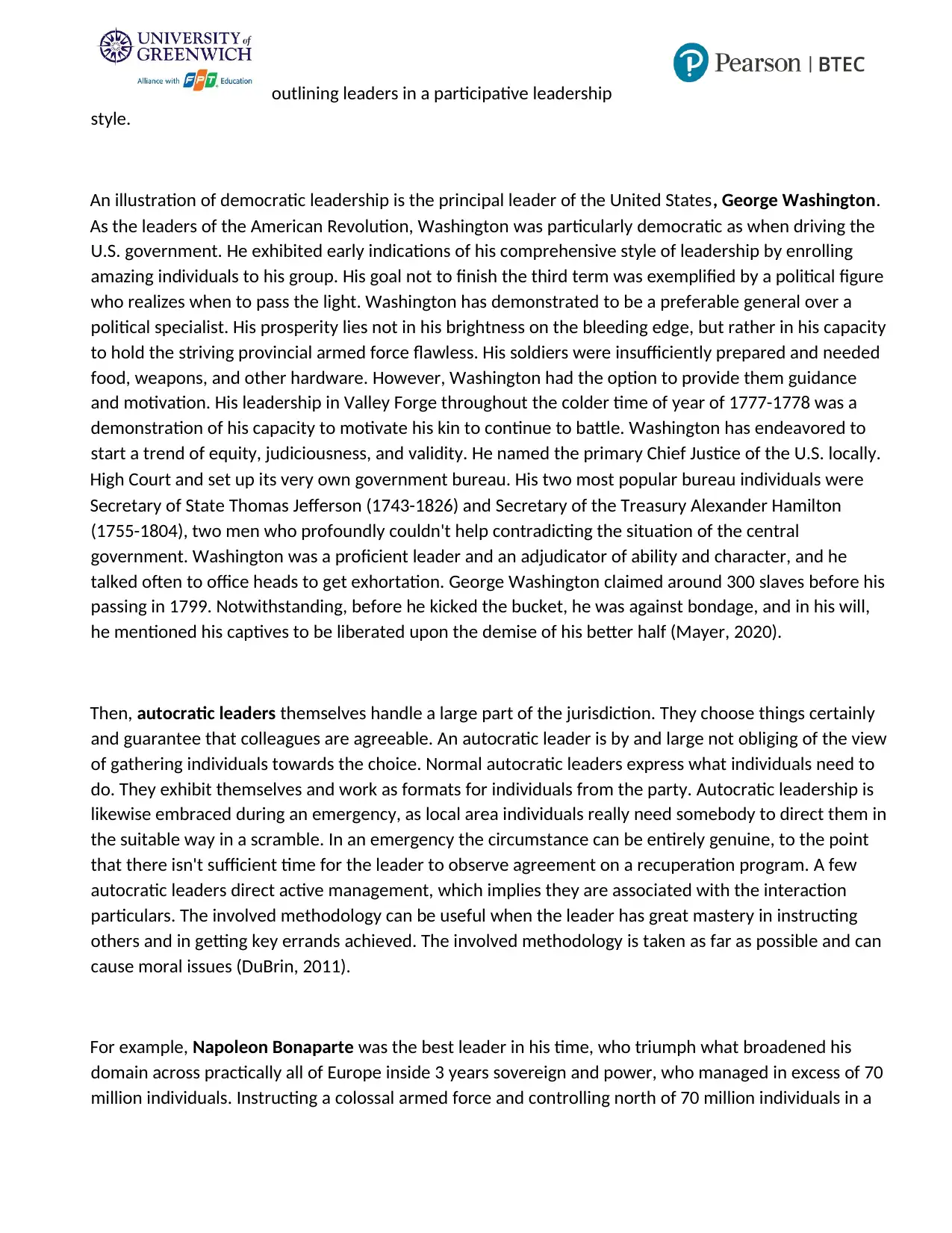
outlining leaders in a participative leadership
style.
An illustration of democratic leadership is the principal leader of the United States, George Washington.
As the leaders of the American Revolution, Washington was particularly democratic as when driving the
U.S. government. He exhibited early indications of his comprehensive style of leadership by enrolling
amazing individuals to his group. His goal not to finish the third term was exemplified by a political figure
who realizes when to pass the light. Washington has demonstrated to be a preferable general over a
political specialist. His prosperity lies not in his brightness on the bleeding edge, but rather in his capacity
to hold the striving provincial armed force flawless. His soldiers were insufficiently prepared and needed
food, weapons, and other hardware. However, Washington had the option to provide them guidance
and motivation. His leadership in Valley Forge throughout the colder time of year of 1777-1778 was a
demonstration of his capacity to motivate his kin to continue to battle. Washington has endeavored to
start a trend of equity, judiciousness, and validity. He named the primary Chief Justice of the U.S. locally.
High Court and set up its very own government bureau. His two most popular bureau individuals were
Secretary of State Thomas Jefferson (1743-1826) and Secretary of the Treasury Alexander Hamilton
(1755-1804), two men who profoundly couldn't help contradicting the situation of the central
government. Washington was a proficient leader and an adjudicator of ability and character, and he
talked often to office heads to get exhortation. George Washington claimed around 300 slaves before his
passing in 1799. Notwithstanding, before he kicked the bucket, he was against bondage, and in his will,
he mentioned his captives to be liberated upon the demise of his better half (Mayer, 2020).
Then, autocratic leaders themselves handle a large part of the jurisdiction. They choose things certainly
and guarantee that colleagues are agreeable. An autocratic leader is by and large not obliging of the view
of gathering individuals towards the choice. Normal autocratic leaders express what individuals need to
do. They exhibit themselves and work as formats for individuals from the party. Autocratic leadership is
likewise embraced during an emergency, as local area individuals really need somebody to direct them in
the suitable way in a scramble. In an emergency the circumstance can be entirely genuine, to the point
that there isn't sufficient time for the leader to observe agreement on a recuperation program. A few
autocratic leaders direct active management, which implies they are associated with the interaction
particulars. The involved methodology can be useful when the leader has great mastery in instructing
others and in getting key errands achieved. The involved methodology is taken as far as possible and can
cause moral issues (DuBrin, 2011).
For example, Napoleon Bonaparte was the best leader in his time, who triumph what broadened his
domain across practically all of Europe inside 3 years sovereign and power, who managed in excess of 70
million individuals. Instructing a colossal armed force and controlling north of 70 million individuals in a
style.
An illustration of democratic leadership is the principal leader of the United States, George Washington.
As the leaders of the American Revolution, Washington was particularly democratic as when driving the
U.S. government. He exhibited early indications of his comprehensive style of leadership by enrolling
amazing individuals to his group. His goal not to finish the third term was exemplified by a political figure
who realizes when to pass the light. Washington has demonstrated to be a preferable general over a
political specialist. His prosperity lies not in his brightness on the bleeding edge, but rather in his capacity
to hold the striving provincial armed force flawless. His soldiers were insufficiently prepared and needed
food, weapons, and other hardware. However, Washington had the option to provide them guidance
and motivation. His leadership in Valley Forge throughout the colder time of year of 1777-1778 was a
demonstration of his capacity to motivate his kin to continue to battle. Washington has endeavored to
start a trend of equity, judiciousness, and validity. He named the primary Chief Justice of the U.S. locally.
High Court and set up its very own government bureau. His two most popular bureau individuals were
Secretary of State Thomas Jefferson (1743-1826) and Secretary of the Treasury Alexander Hamilton
(1755-1804), two men who profoundly couldn't help contradicting the situation of the central
government. Washington was a proficient leader and an adjudicator of ability and character, and he
talked often to office heads to get exhortation. George Washington claimed around 300 slaves before his
passing in 1799. Notwithstanding, before he kicked the bucket, he was against bondage, and in his will,
he mentioned his captives to be liberated upon the demise of his better half (Mayer, 2020).
Then, autocratic leaders themselves handle a large part of the jurisdiction. They choose things certainly
and guarantee that colleagues are agreeable. An autocratic leader is by and large not obliging of the view
of gathering individuals towards the choice. Normal autocratic leaders express what individuals need to
do. They exhibit themselves and work as formats for individuals from the party. Autocratic leadership is
likewise embraced during an emergency, as local area individuals really need somebody to direct them in
the suitable way in a scramble. In an emergency the circumstance can be entirely genuine, to the point
that there isn't sufficient time for the leader to observe agreement on a recuperation program. A few
autocratic leaders direct active management, which implies they are associated with the interaction
particulars. The involved methodology can be useful when the leader has great mastery in instructing
others and in getting key errands achieved. The involved methodology is taken as far as possible and can
cause moral issues (DuBrin, 2011).
For example, Napoleon Bonaparte was the best leader in his time, who triumph what broadened his
domain across practically all of Europe inside 3 years sovereign and power, who managed in excess of 70
million individuals. Instructing a colossal armed force and controlling north of 70 million individuals in a
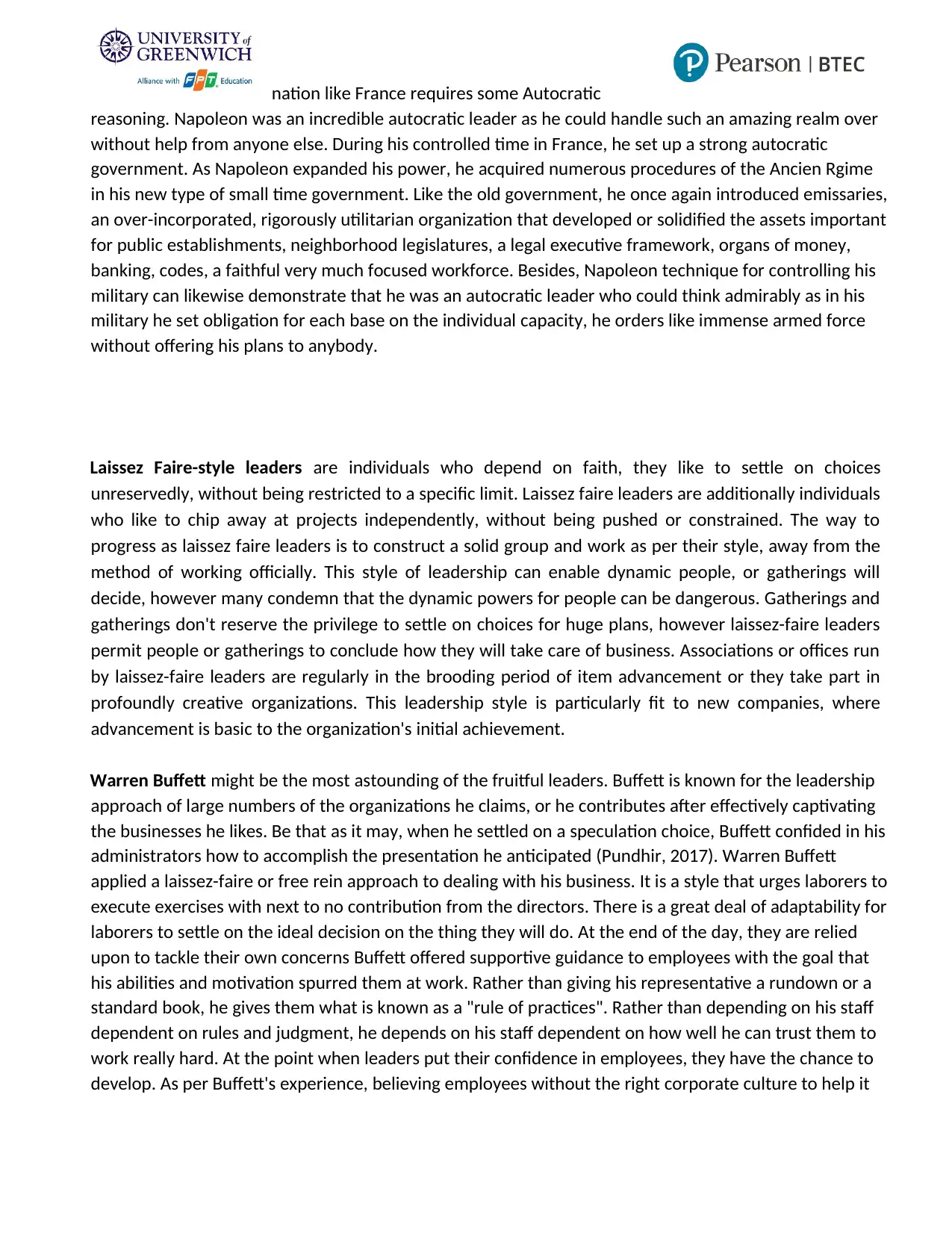
nation like France requires some Autocratic
reasoning. Napoleon was an incredible autocratic leader as he could handle such an amazing realm over
without help from anyone else. During his controlled time in France, he set up a strong autocratic
government. As Napoleon expanded his power, he acquired numerous procedures of the Ancien Rgime
in his new type of small time government. Like the old government, he once again introduced emissaries,
an over-incorporated, rigorously utilitarian organization that developed or solidified the assets important
for public establishments, neighborhood legislatures, a legal executive framework, organs of money,
banking, codes, a faithful very much focused workforce. Besides, Napoleon technique for controlling his
military can likewise demonstrate that he was an autocratic leader who could think admirably as in his
military he set obligation for each base on the individual capacity, he orders like immense armed force
without offering his plans to anybody.
Laissez Faire-style leaders are individuals who depend on faith, they like to settle on choices
unreservedly, without being restricted to a specific limit. Laissez faire leaders are additionally individuals
who like to chip away at projects independently, without being pushed or constrained. The way to
progress as laissez faire leaders is to construct a solid group and work as per their style, away from the
method of working officially. This style of leadership can enable dynamic people, or gatherings will
decide, however many condemn that the dynamic powers for people can be dangerous. Gatherings and
gatherings don't reserve the privilege to settle on choices for huge plans, however laissez-faire leaders
permit people or gatherings to conclude how they will take care of business. Associations or offices run
by laissez-faire leaders are regularly in the brooding period of item advancement or they take part in
profoundly creative organizations. This leadership style is particularly fit to new companies, where
advancement is basic to the organization's initial achievement.
Warren Buffett might be the most astounding of the fruitful leaders. Buffett is known for the leadership
approach of large numbers of the organizations he claims, or he contributes after effectively captivating
the businesses he likes. Be that as it may, when he settled on a speculation choice, Buffett confided in his
administrators how to accomplish the presentation he anticipated (Pundhir, 2017). Warren Buffett
applied a laissez-faire or free rein approach to dealing with his business. It is a style that urges laborers to
execute exercises with next to no contribution from the directors. There is a great deal of adaptability for
laborers to settle on the ideal decision on the thing they will do. At the end of the day, they are relied
upon to tackle their own concerns Buffett offered supportive guidance to employees with the goal that
his abilities and motivation spurred them at work. Rather than giving his representative a rundown or a
standard book, he gives them what is known as a "rule of practices". Rather than depending on his staff
dependent on rules and judgment, he depends on his staff dependent on how well he can trust them to
work really hard. At the point when leaders put their confidence in employees, they have the chance to
develop. As per Buffett's experience, believing employees without the right corporate culture to help it
reasoning. Napoleon was an incredible autocratic leader as he could handle such an amazing realm over
without help from anyone else. During his controlled time in France, he set up a strong autocratic
government. As Napoleon expanded his power, he acquired numerous procedures of the Ancien Rgime
in his new type of small time government. Like the old government, he once again introduced emissaries,
an over-incorporated, rigorously utilitarian organization that developed or solidified the assets important
for public establishments, neighborhood legislatures, a legal executive framework, organs of money,
banking, codes, a faithful very much focused workforce. Besides, Napoleon technique for controlling his
military can likewise demonstrate that he was an autocratic leader who could think admirably as in his
military he set obligation for each base on the individual capacity, he orders like immense armed force
without offering his plans to anybody.
Laissez Faire-style leaders are individuals who depend on faith, they like to settle on choices
unreservedly, without being restricted to a specific limit. Laissez faire leaders are additionally individuals
who like to chip away at projects independently, without being pushed or constrained. The way to
progress as laissez faire leaders is to construct a solid group and work as per their style, away from the
method of working officially. This style of leadership can enable dynamic people, or gatherings will
decide, however many condemn that the dynamic powers for people can be dangerous. Gatherings and
gatherings don't reserve the privilege to settle on choices for huge plans, however laissez-faire leaders
permit people or gatherings to conclude how they will take care of business. Associations or offices run
by laissez-faire leaders are regularly in the brooding period of item advancement or they take part in
profoundly creative organizations. This leadership style is particularly fit to new companies, where
advancement is basic to the organization's initial achievement.
Warren Buffett might be the most astounding of the fruitful leaders. Buffett is known for the leadership
approach of large numbers of the organizations he claims, or he contributes after effectively captivating
the businesses he likes. Be that as it may, when he settled on a speculation choice, Buffett confided in his
administrators how to accomplish the presentation he anticipated (Pundhir, 2017). Warren Buffett
applied a laissez-faire or free rein approach to dealing with his business. It is a style that urges laborers to
execute exercises with next to no contribution from the directors. There is a great deal of adaptability for
laborers to settle on the ideal decision on the thing they will do. At the end of the day, they are relied
upon to tackle their own concerns Buffett offered supportive guidance to employees with the goal that
his abilities and motivation spurred them at work. Rather than giving his representative a rundown or a
standard book, he gives them what is known as a "rule of practices". Rather than depending on his staff
dependent on rules and judgment, he depends on his staff dependent on how well he can trust them to
work really hard. At the point when leaders put their confidence in employees, they have the chance to
develop. As per Buffett's experience, believing employees without the right corporate culture to help it
Secure Best Marks with AI Grader
Need help grading? Try our AI Grader for instant feedback on your assignments.
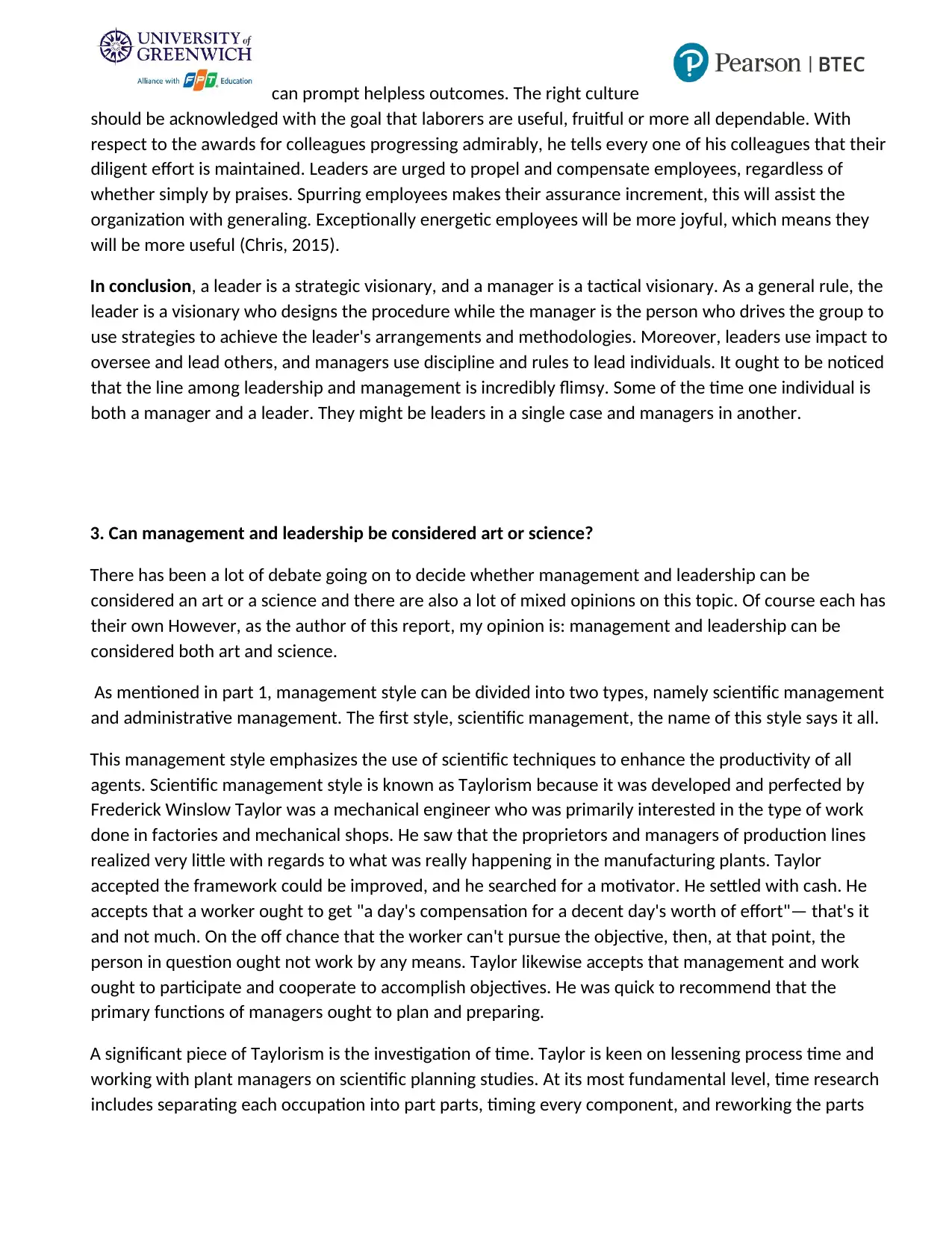
can prompt helpless outcomes. The right culture
should be acknowledged with the goal that laborers are useful, fruitful or more all dependable. With
respect to the awards for colleagues progressing admirably, he tells every one of his colleagues that their
diligent effort is maintained. Leaders are urged to propel and compensate employees, regardless of
whether simply by praises. Spurring employees makes their assurance increment, this will assist the
organization with generaling. Exceptionally energetic employees will be more joyful, which means they
will be more useful (Chris, 2015).
In conclusion, a leader is a strategic visionary, and a manager is a tactical visionary. As a general rule, the
leader is a visionary who designs the procedure while the manager is the person who drives the group to
use strategies to achieve the leader's arrangements and methodologies. Moreover, leaders use impact to
oversee and lead others, and managers use discipline and rules to lead individuals. It ought to be noticed
that the line among leadership and management is incredibly flimsy. Some of the time one individual is
both a manager and a leader. They might be leaders in a single case and managers in another.
3. Can management and leadership be considered art or science?
There has been a lot of debate going on to decide whether management and leadership can be
considered an art or a science and there are also a lot of mixed opinions on this topic. Of course each has
their own However, as the author of this report, my opinion is: management and leadership can be
considered both art and science.
As mentioned in part 1, management style can be divided into two types, namely scientific management
and administrative management. The first style, scientific management, the name of this style says it all.
This management style emphasizes the use of scientific techniques to enhance the productivity of all
agents. Scientific management style is known as Taylorism because it was developed and perfected by
Frederick Winslow Taylor was a mechanical engineer who was primarily interested in the type of work
done in factories and mechanical shops. He saw that the proprietors and managers of production lines
realized very little with regards to what was really happening in the manufacturing plants. Taylor
accepted the framework could be improved, and he searched for a motivator. He settled with cash. He
accepts that a worker ought to get "a day's compensation for a decent day's worth of effort"— that's it
and not much. On the off chance that the worker can't pursue the objective, then, at that point, the
person in question ought not work by any means. Taylor likewise accepts that management and work
ought to participate and cooperate to accomplish objectives. He was quick to recommend that the
primary functions of managers ought to plan and preparing.
A significant piece of Taylorism is the investigation of time. Taylor is keen on lessening process time and
working with plant managers on scientific planning studies. At its most fundamental level, time research
includes separating each occupation into part parts, timing every component, and reworking the parts
should be acknowledged with the goal that laborers are useful, fruitful or more all dependable. With
respect to the awards for colleagues progressing admirably, he tells every one of his colleagues that their
diligent effort is maintained. Leaders are urged to propel and compensate employees, regardless of
whether simply by praises. Spurring employees makes their assurance increment, this will assist the
organization with generaling. Exceptionally energetic employees will be more joyful, which means they
will be more useful (Chris, 2015).
In conclusion, a leader is a strategic visionary, and a manager is a tactical visionary. As a general rule, the
leader is a visionary who designs the procedure while the manager is the person who drives the group to
use strategies to achieve the leader's arrangements and methodologies. Moreover, leaders use impact to
oversee and lead others, and managers use discipline and rules to lead individuals. It ought to be noticed
that the line among leadership and management is incredibly flimsy. Some of the time one individual is
both a manager and a leader. They might be leaders in a single case and managers in another.
3. Can management and leadership be considered art or science?
There has been a lot of debate going on to decide whether management and leadership can be
considered an art or a science and there are also a lot of mixed opinions on this topic. Of course each has
their own However, as the author of this report, my opinion is: management and leadership can be
considered both art and science.
As mentioned in part 1, management style can be divided into two types, namely scientific management
and administrative management. The first style, scientific management, the name of this style says it all.
This management style emphasizes the use of scientific techniques to enhance the productivity of all
agents. Scientific management style is known as Taylorism because it was developed and perfected by
Frederick Winslow Taylor was a mechanical engineer who was primarily interested in the type of work
done in factories and mechanical shops. He saw that the proprietors and managers of production lines
realized very little with regards to what was really happening in the manufacturing plants. Taylor
accepted the framework could be improved, and he searched for a motivator. He settled with cash. He
accepts that a worker ought to get "a day's compensation for a decent day's worth of effort"— that's it
and not much. On the off chance that the worker can't pursue the objective, then, at that point, the
person in question ought not work by any means. Taylor likewise accepts that management and work
ought to participate and cooperate to accomplish objectives. He was quick to recommend that the
primary functions of managers ought to plan and preparing.
A significant piece of Taylorism is the investigation of time. Taylor is keen on lessening process time and
working with plant managers on scientific planning studies. At its most fundamental level, time research
includes separating each occupation into part parts, timing every component, and reworking the parts
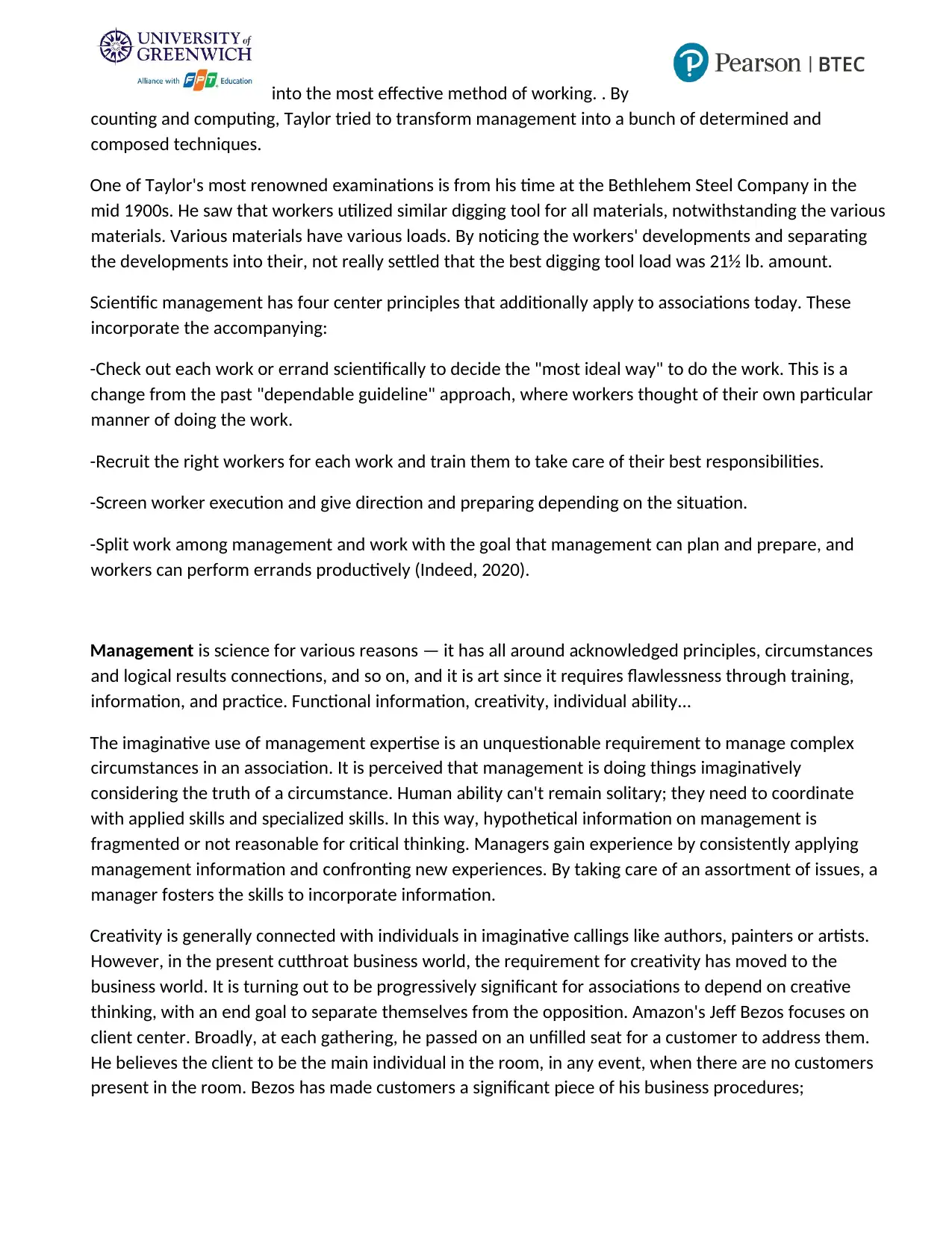
into the most effective method of working. . By
counting and computing, Taylor tried to transform management into a bunch of determined and
composed techniques.
One of Taylor's most renowned examinations is from his time at the Bethlehem Steel Company in the
mid 1900s. He saw that workers utilized similar digging tool for all materials, notwithstanding the various
materials. Various materials have various loads. By noticing the workers' developments and separating
the developments into their, not really settled that the best digging tool load was 21½ lb. amount.
Scientific management has four center principles that additionally apply to associations today. These
incorporate the accompanying:
-Check out each work or errand scientifically to decide the "most ideal way" to do the work. This is a
change from the past "dependable guideline" approach, where workers thought of their own particular
manner of doing the work.
-Recruit the right workers for each work and train them to take care of their best responsibilities.
-Screen worker execution and give direction and preparing depending on the situation.
-Split work among management and work with the goal that management can plan and prepare, and
workers can perform errands productively (Indeed, 2020).
Management is science for various reasons — it has all around acknowledged principles, circumstances
and logical results connections, and so on, and it is art since it requires flawlessness through training,
information, and practice. Functional information, creativity, individual ability...
The imaginative use of management expertise is an unquestionable requirement to manage complex
circumstances in an association. It is perceived that management is doing things imaginatively
considering the truth of a circumstance. Human ability can't remain solitary; they need to coordinate
with applied skills and specialized skills. In this way, hypothetical information on management is
fragmented or not reasonable for critical thinking. Managers gain experience by consistently applying
management information and confronting new experiences. By taking care of an assortment of issues, a
manager fosters the skills to incorporate information.
Creativity is generally connected with individuals in imaginative callings like authors, painters or artists.
However, in the present cutthroat business world, the requirement for creativity has moved to the
business world. It is turning out to be progressively significant for associations to depend on creative
thinking, with an end goal to separate themselves from the opposition. Amazon's Jeff Bezos focuses on
client center. Broadly, at each gathering, he passed on an unfilled seat for a customer to address them.
He believes the client to be the main individual in the room, in any event, when there are no customers
present in the room. Bezos has made customers a significant piece of his business procedures;
counting and computing, Taylor tried to transform management into a bunch of determined and
composed techniques.
One of Taylor's most renowned examinations is from his time at the Bethlehem Steel Company in the
mid 1900s. He saw that workers utilized similar digging tool for all materials, notwithstanding the various
materials. Various materials have various loads. By noticing the workers' developments and separating
the developments into their, not really settled that the best digging tool load was 21½ lb. amount.
Scientific management has four center principles that additionally apply to associations today. These
incorporate the accompanying:
-Check out each work or errand scientifically to decide the "most ideal way" to do the work. This is a
change from the past "dependable guideline" approach, where workers thought of their own particular
manner of doing the work.
-Recruit the right workers for each work and train them to take care of their best responsibilities.
-Screen worker execution and give direction and preparing depending on the situation.
-Split work among management and work with the goal that management can plan and prepare, and
workers can perform errands productively (Indeed, 2020).
Management is science for various reasons — it has all around acknowledged principles, circumstances
and logical results connections, and so on, and it is art since it requires flawlessness through training,
information, and practice. Functional information, creativity, individual ability...
The imaginative use of management expertise is an unquestionable requirement to manage complex
circumstances in an association. It is perceived that management is doing things imaginatively
considering the truth of a circumstance. Human ability can't remain solitary; they need to coordinate
with applied skills and specialized skills. In this way, hypothetical information on management is
fragmented or not reasonable for critical thinking. Managers gain experience by consistently applying
management information and confronting new experiences. By taking care of an assortment of issues, a
manager fosters the skills to incorporate information.
Creativity is generally connected with individuals in imaginative callings like authors, painters or artists.
However, in the present cutthroat business world, the requirement for creativity has moved to the
business world. It is turning out to be progressively significant for associations to depend on creative
thinking, with an end goal to separate themselves from the opposition. Amazon's Jeff Bezos focuses on
client center. Broadly, at each gathering, he passed on an unfilled seat for a customer to address them.
He believes the client to be the main individual in the room, in any event, when there are no customers
present in the room. Bezos has made customers a significant piece of his business procedures;
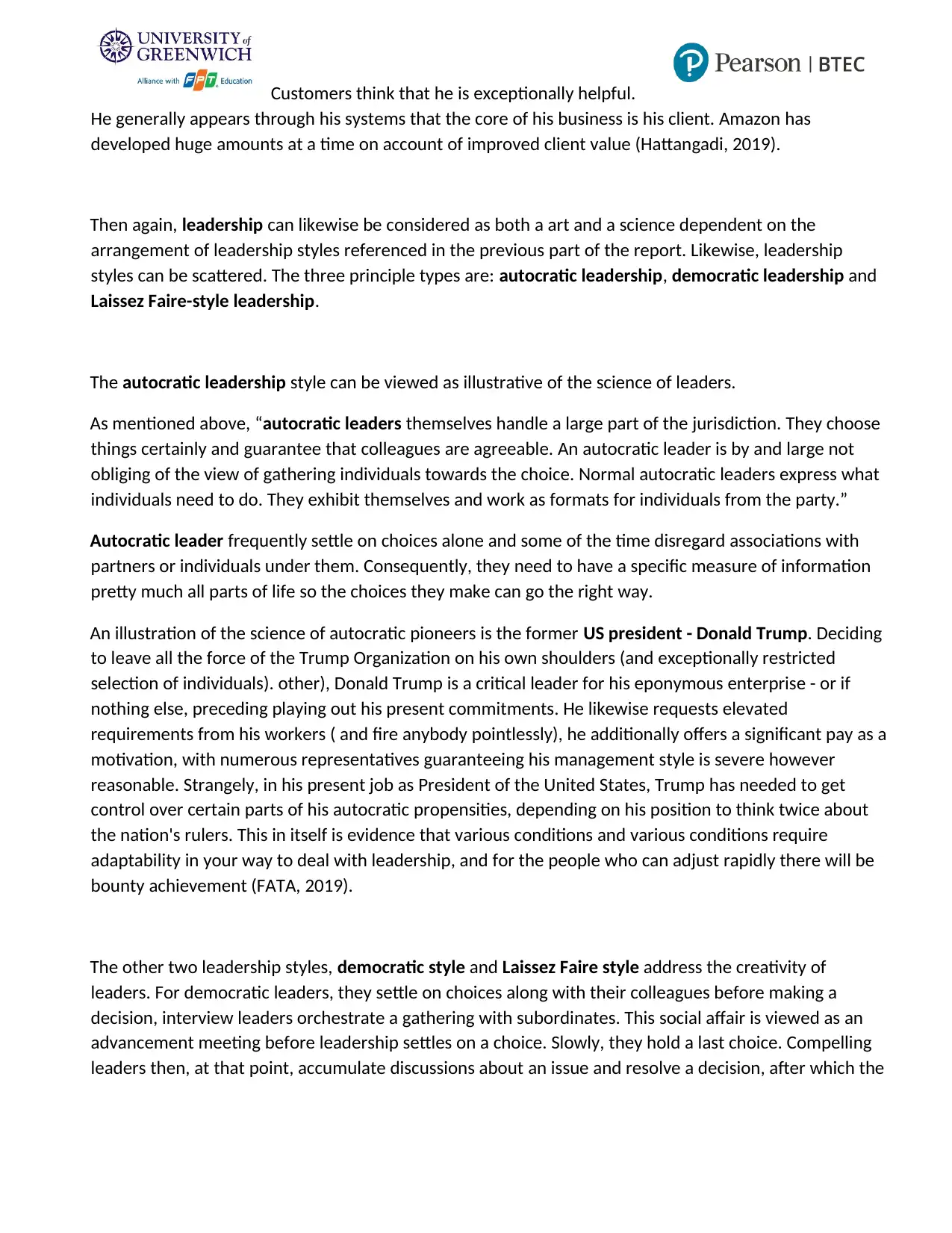
Customers think that he is exceptionally helpful.
He generally appears through his systems that the core of his business is his client. Amazon has
developed huge amounts at a time on account of improved client value (Hattangadi, 2019).
Then again, leadership can likewise be considered as both a art and a science dependent on the
arrangement of leadership styles referenced in the previous part of the report. Likewise, leadership
styles can be scattered. The three principle types are: autocratic leadership, democratic leadership and
Laissez Faire-style leadership.
The autocratic leadership style can be viewed as illustrative of the science of leaders.
As mentioned above, “autocratic leaders themselves handle a large part of the jurisdiction. They choose
things certainly and guarantee that colleagues are agreeable. An autocratic leader is by and large not
obliging of the view of gathering individuals towards the choice. Normal autocratic leaders express what
individuals need to do. They exhibit themselves and work as formats for individuals from the party.”
Autocratic leader frequently settle on choices alone and some of the time disregard associations with
partners or individuals under them. Consequently, they need to have a specific measure of information
pretty much all parts of life so the choices they make can go the right way.
An illustration of the science of autocratic pioneers is the former US president - Donald Trump. Deciding
to leave all the force of the Trump Organization on his own shoulders (and exceptionally restricted
selection of individuals). other), Donald Trump is a critical leader for his eponymous enterprise - or if
nothing else, preceding playing out his present commitments. He likewise requests elevated
requirements from his workers ( and fire anybody pointlessly), he additionally offers a significant pay as a
motivation, with numerous representatives guaranteeing his management style is severe however
reasonable. Strangely, in his present job as President of the United States, Trump has needed to get
control over certain parts of his autocratic propensities, depending on his position to think twice about
the nation's rulers. This in itself is evidence that various conditions and various conditions require
adaptability in your way to deal with leadership, and for the people who can adjust rapidly there will be
bounty achievement (FATA, 2019).
The other two leadership styles, democratic style and Laissez Faire style address the creativity of
leaders. For democratic leaders, they settle on choices along with their colleagues before making a
decision, interview leaders orchestrate a gathering with subordinates. This social affair is viewed as an
advancement meeting before leadership settles on a choice. Slowly, they hold a last choice. Compelling
leaders then, at that point, accumulate discussions about an issue and resolve a decision, after which the
He generally appears through his systems that the core of his business is his client. Amazon has
developed huge amounts at a time on account of improved client value (Hattangadi, 2019).
Then again, leadership can likewise be considered as both a art and a science dependent on the
arrangement of leadership styles referenced in the previous part of the report. Likewise, leadership
styles can be scattered. The three principle types are: autocratic leadership, democratic leadership and
Laissez Faire-style leadership.
The autocratic leadership style can be viewed as illustrative of the science of leaders.
As mentioned above, “autocratic leaders themselves handle a large part of the jurisdiction. They choose
things certainly and guarantee that colleagues are agreeable. An autocratic leader is by and large not
obliging of the view of gathering individuals towards the choice. Normal autocratic leaders express what
individuals need to do. They exhibit themselves and work as formats for individuals from the party.”
Autocratic leader frequently settle on choices alone and some of the time disregard associations with
partners or individuals under them. Consequently, they need to have a specific measure of information
pretty much all parts of life so the choices they make can go the right way.
An illustration of the science of autocratic pioneers is the former US president - Donald Trump. Deciding
to leave all the force of the Trump Organization on his own shoulders (and exceptionally restricted
selection of individuals). other), Donald Trump is a critical leader for his eponymous enterprise - or if
nothing else, preceding playing out his present commitments. He likewise requests elevated
requirements from his workers ( and fire anybody pointlessly), he additionally offers a significant pay as a
motivation, with numerous representatives guaranteeing his management style is severe however
reasonable. Strangely, in his present job as President of the United States, Trump has needed to get
control over certain parts of his autocratic propensities, depending on his position to think twice about
the nation's rulers. This in itself is evidence that various conditions and various conditions require
adaptability in your way to deal with leadership, and for the people who can adjust rapidly there will be
bounty achievement (FATA, 2019).
The other two leadership styles, democratic style and Laissez Faire style address the creativity of
leaders. For democratic leaders, they settle on choices along with their colleagues before making a
decision, interview leaders orchestrate a gathering with subordinates. This social affair is viewed as an
advancement meeting before leadership settles on a choice. Slowly, they hold a last choice. Compelling
leaders then, at that point, accumulate discussions about an issue and resolve a decision, after which the
Paraphrase This Document
Need a fresh take? Get an instant paraphrase of this document with our AI Paraphraser
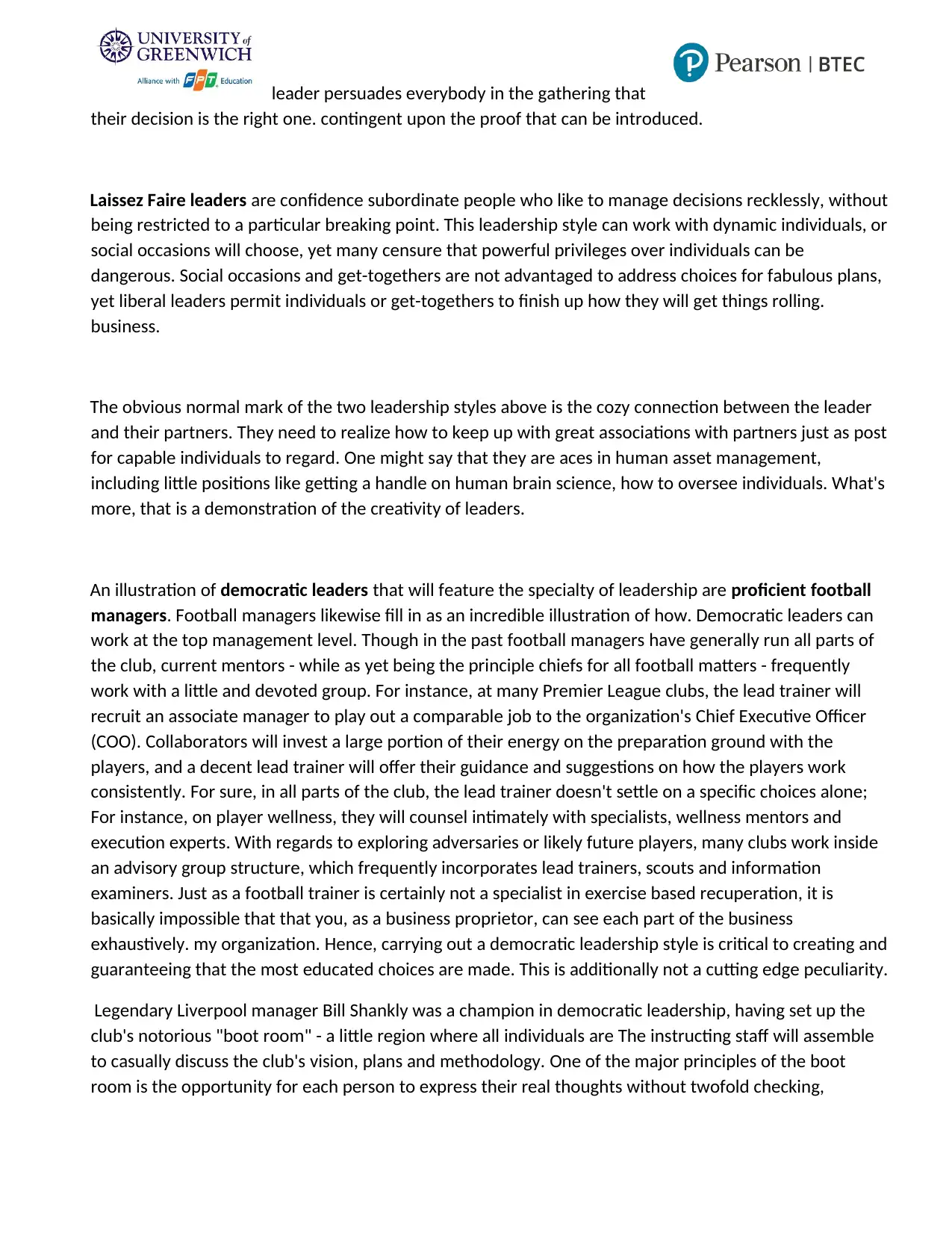
leader persuades everybody in the gathering that
their decision is the right one. contingent upon the proof that can be introduced.
Laissez Faire leaders are confidence subordinate people who like to manage decisions recklessly, without
being restricted to a particular breaking point. This leadership style can work with dynamic individuals, or
social occasions will choose, yet many censure that powerful privileges over individuals can be
dangerous. Social occasions and get-togethers are not advantaged to address choices for fabulous plans,
yet liberal leaders permit individuals or get-togethers to finish up how they will get things rolling.
business.
The obvious normal mark of the two leadership styles above is the cozy connection between the leader
and their partners. They need to realize how to keep up with great associations with partners just as post
for capable individuals to regard. One might say that they are aces in human asset management,
including little positions like getting a handle on human brain science, how to oversee individuals. What's
more, that is a demonstration of the creativity of leaders.
An illustration of democratic leaders that will feature the specialty of leadership are proficient football
managers. Football managers likewise fill in as an incredible illustration of how. Democratic leaders can
work at the top management level. Though in the past football managers have generally run all parts of
the club, current mentors - while as yet being the principle chiefs for all football matters - frequently
work with a little and devoted group. For instance, at many Premier League clubs, the lead trainer will
recruit an associate manager to play out a comparable job to the organization's Chief Executive Officer
(COO). Collaborators will invest a large portion of their energy on the preparation ground with the
players, and a decent lead trainer will offer their guidance and suggestions on how the players work
consistently. For sure, in all parts of the club, the lead trainer doesn't settle on a specific choices alone;
For instance, on player wellness, they will counsel intimately with specialists, wellness mentors and
execution experts. With regards to exploring adversaries or likely future players, many clubs work inside
an advisory group structure, which frequently incorporates lead trainers, scouts and information
examiners. Just as a football trainer is certainly not a specialist in exercise based recuperation, it is
basically impossible that that you, as a business proprietor, can see each part of the business
exhaustively. my organization. Hence, carrying out a democratic leadership style is critical to creating and
guaranteeing that the most educated choices are made. This is additionally not a cutting edge peculiarity.
Legendary Liverpool manager Bill Shankly was a champion in democratic leadership, having set up the
club's notorious "boot room" - a little region where all individuals are The instructing staff will assemble
to casually discuss the club's vision, plans and methodology. One of the major principles of the boot
room is the opportunity for each person to express their real thoughts without twofold checking,
their decision is the right one. contingent upon the proof that can be introduced.
Laissez Faire leaders are confidence subordinate people who like to manage decisions recklessly, without
being restricted to a particular breaking point. This leadership style can work with dynamic individuals, or
social occasions will choose, yet many censure that powerful privileges over individuals can be
dangerous. Social occasions and get-togethers are not advantaged to address choices for fabulous plans,
yet liberal leaders permit individuals or get-togethers to finish up how they will get things rolling.
business.
The obvious normal mark of the two leadership styles above is the cozy connection between the leader
and their partners. They need to realize how to keep up with great associations with partners just as post
for capable individuals to regard. One might say that they are aces in human asset management,
including little positions like getting a handle on human brain science, how to oversee individuals. What's
more, that is a demonstration of the creativity of leaders.
An illustration of democratic leaders that will feature the specialty of leadership are proficient football
managers. Football managers likewise fill in as an incredible illustration of how. Democratic leaders can
work at the top management level. Though in the past football managers have generally run all parts of
the club, current mentors - while as yet being the principle chiefs for all football matters - frequently
work with a little and devoted group. For instance, at many Premier League clubs, the lead trainer will
recruit an associate manager to play out a comparable job to the organization's Chief Executive Officer
(COO). Collaborators will invest a large portion of their energy on the preparation ground with the
players, and a decent lead trainer will offer their guidance and suggestions on how the players work
consistently. For sure, in all parts of the club, the lead trainer doesn't settle on a specific choices alone;
For instance, on player wellness, they will counsel intimately with specialists, wellness mentors and
execution experts. With regards to exploring adversaries or likely future players, many clubs work inside
an advisory group structure, which frequently incorporates lead trainers, scouts and information
examiners. Just as a football trainer is certainly not a specialist in exercise based recuperation, it is
basically impossible that that you, as a business proprietor, can see each part of the business
exhaustively. my organization. Hence, carrying out a democratic leadership style is critical to creating and
guaranteeing that the most educated choices are made. This is additionally not a cutting edge peculiarity.
Legendary Liverpool manager Bill Shankly was a champion in democratic leadership, having set up the
club's notorious "boot room" - a little region where all individuals are The instructing staff will assemble
to casually discuss the club's vision, plans and methodology. One of the major principles of the boot
room is the opportunity for each person to express their real thoughts without twofold checking,
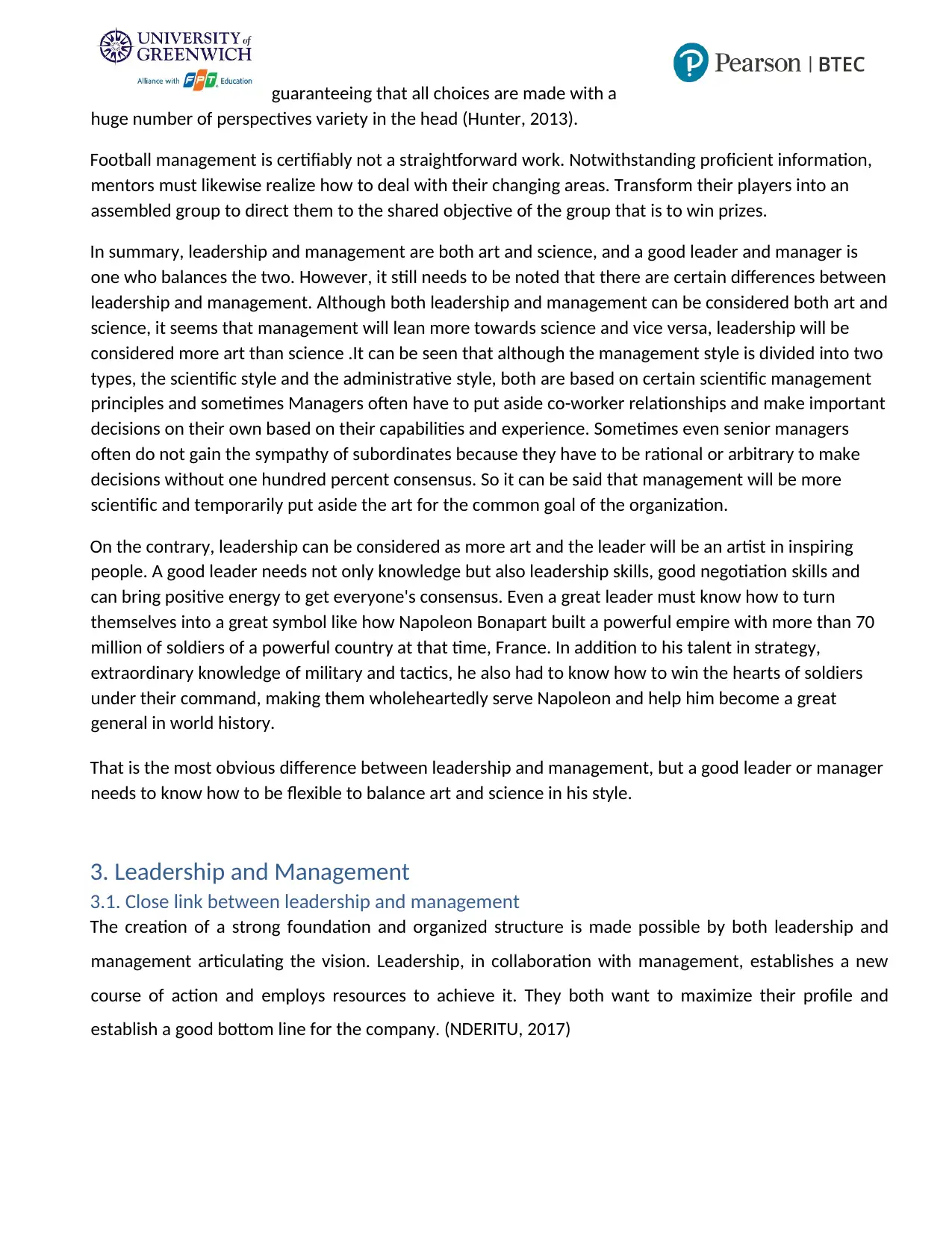
guaranteeing that all choices are made with a
huge number of perspectives variety in the head (Hunter, 2013).
Football management is certifiably not a straightforward work. Notwithstanding proficient information,
mentors must likewise realize how to deal with their changing areas. Transform their players into an
assembled group to direct them to the shared objective of the group that is to win prizes.
In summary, leadership and management are both art and science, and a good leader and manager is
one who balances the two. However, it still needs to be noted that there are certain differences between
leadership and management. Although both leadership and management can be considered both art and
science, it seems that management will lean more towards science and vice versa, leadership will be
considered more art than science .It can be seen that although the management style is divided into two
types, the scientific style and the administrative style, both are based on certain scientific management
principles and sometimes Managers often have to put aside co-worker relationships and make important
decisions on their own based on their capabilities and experience. Sometimes even senior managers
often do not gain the sympathy of subordinates because they have to be rational or arbitrary to make
decisions without one hundred percent consensus. So it can be said that management will be more
scientific and temporarily put aside the art for the common goal of the organization.
On the contrary, leadership can be considered as more art and the leader will be an artist in inspiring
people. A good leader needs not only knowledge but also leadership skills, good negotiation skills and
can bring positive energy to get everyone's consensus. Even a great leader must know how to turn
themselves into a great symbol like how Napoleon Bonapart built a powerful empire with more than 70
million of soldiers of a powerful country at that time, France. In addition to his talent in strategy,
extraordinary knowledge of military and tactics, he also had to know how to win the hearts of soldiers
under their command, making them wholeheartedly serve Napoleon and help him become a great
general in world history.
That is the most obvious difference between leadership and management, but a good leader or manager
needs to know how to be flexible to balance art and science in his style.
3. Leadership and Management
3.1. Close link between leadership and management
The creation of a strong foundation and organized structure is made possible by both leadership and
management articulating the vision. Leadership, in collaboration with management, establishes a new
course of action and employs resources to achieve it. They both want to maximize their profile and
establish a good bottom line for the company. (NDERITU, 2017)
huge number of perspectives variety in the head (Hunter, 2013).
Football management is certifiably not a straightforward work. Notwithstanding proficient information,
mentors must likewise realize how to deal with their changing areas. Transform their players into an
assembled group to direct them to the shared objective of the group that is to win prizes.
In summary, leadership and management are both art and science, and a good leader and manager is
one who balances the two. However, it still needs to be noted that there are certain differences between
leadership and management. Although both leadership and management can be considered both art and
science, it seems that management will lean more towards science and vice versa, leadership will be
considered more art than science .It can be seen that although the management style is divided into two
types, the scientific style and the administrative style, both are based on certain scientific management
principles and sometimes Managers often have to put aside co-worker relationships and make important
decisions on their own based on their capabilities and experience. Sometimes even senior managers
often do not gain the sympathy of subordinates because they have to be rational or arbitrary to make
decisions without one hundred percent consensus. So it can be said that management will be more
scientific and temporarily put aside the art for the common goal of the organization.
On the contrary, leadership can be considered as more art and the leader will be an artist in inspiring
people. A good leader needs not only knowledge but also leadership skills, good negotiation skills and
can bring positive energy to get everyone's consensus. Even a great leader must know how to turn
themselves into a great symbol like how Napoleon Bonapart built a powerful empire with more than 70
million of soldiers of a powerful country at that time, France. In addition to his talent in strategy,
extraordinary knowledge of military and tactics, he also had to know how to win the hearts of soldiers
under their command, making them wholeheartedly serve Napoleon and help him become a great
general in world history.
That is the most obvious difference between leadership and management, but a good leader or manager
needs to know how to be flexible to balance art and science in his style.
3. Leadership and Management
3.1. Close link between leadership and management
The creation of a strong foundation and organized structure is made possible by both leadership and
management articulating the vision. Leadership, in collaboration with management, establishes a new
course of action and employs resources to achieve it. They both want to maximize their profile and
establish a good bottom line for the company. (NDERITU, 2017)
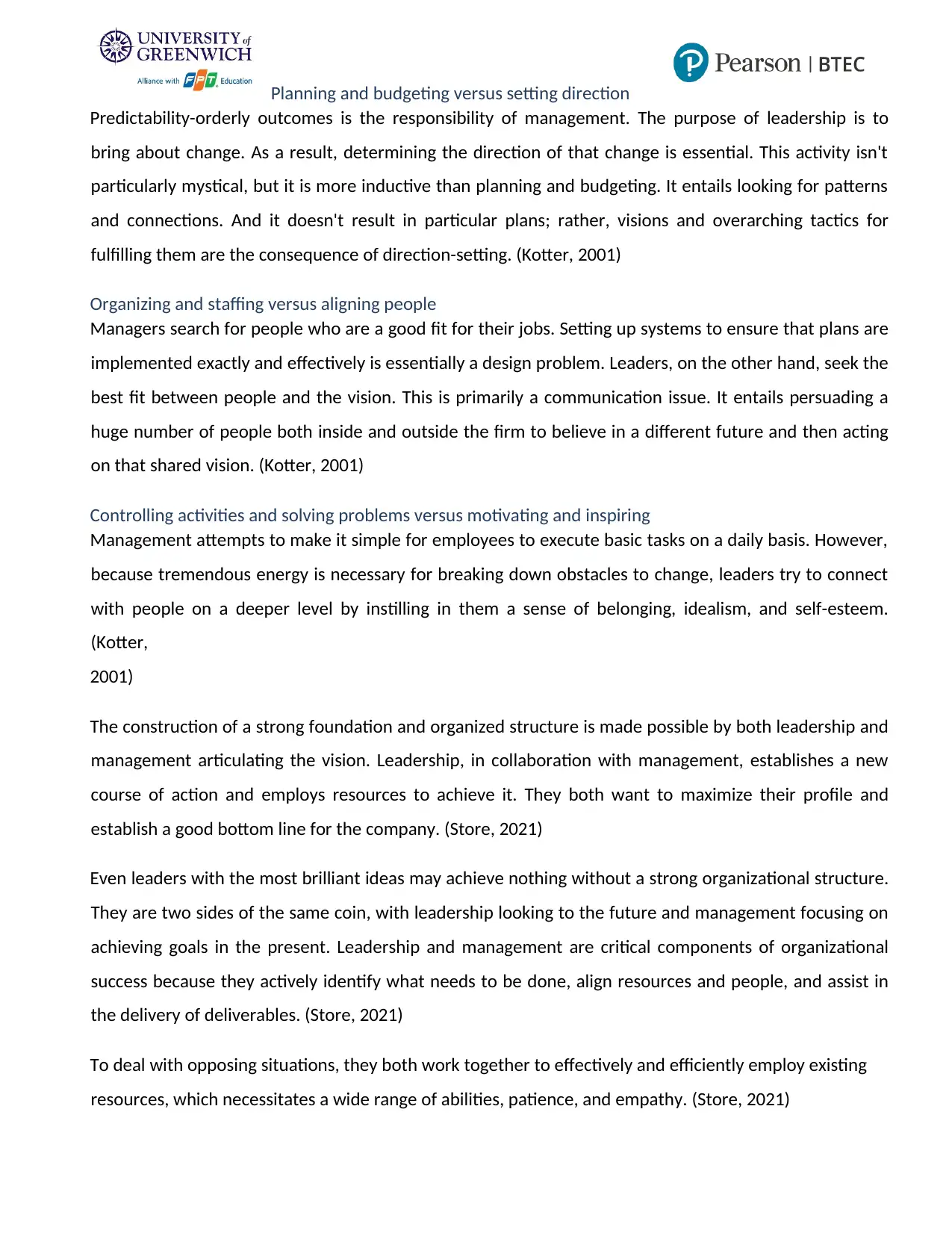
Planning and budgeting versus setting direction
Predictability-orderly outcomes is the responsibility of management. The purpose of leadership is to
bring about change. As a result, determining the direction of that change is essential. This activity isn't
particularly mystical, but it is more inductive than planning and budgeting. It entails looking for patterns
and connections. And it doesn't result in particular plans; rather, visions and overarching tactics for
fulfilling them are the consequence of direction-setting. (Kotter, 2001)
Organizing and staffing versus aligning people
Managers search for people who are a good fit for their jobs. Setting up systems to ensure that plans are
implemented exactly and effectively is essentially a design problem. Leaders, on the other hand, seek the
best fit between people and the vision. This is primarily a communication issue. It entails persuading a
huge number of people both inside and outside the firm to believe in a different future and then acting
on that shared vision. (Kotter, 2001)
Controlling activities and solving problems versus motivating and inspiring
Management attempts to make it simple for employees to execute basic tasks on a daily basis. However,
because tremendous energy is necessary for breaking down obstacles to change, leaders try to connect
with people on a deeper level by instilling in them a sense of belonging, idealism, and self-esteem.
(Kotter,
2001)
The construction of a strong foundation and organized structure is made possible by both leadership and
management articulating the vision. Leadership, in collaboration with management, establishes a new
course of action and employs resources to achieve it. They both want to maximize their profile and
establish a good bottom line for the company. (Store, 2021)
Even leaders with the most brilliant ideas may achieve nothing without a strong organizational structure.
They are two sides of the same coin, with leadership looking to the future and management focusing on
achieving goals in the present. Leadership and management are critical components of organizational
success because they actively identify what needs to be done, align resources and people, and assist in
the delivery of deliverables. (Store, 2021)
To deal with opposing situations, they both work together to effectively and efficiently employ existing
resources, which necessitates a wide range of abilities, patience, and empathy. (Store, 2021)
Predictability-orderly outcomes is the responsibility of management. The purpose of leadership is to
bring about change. As a result, determining the direction of that change is essential. This activity isn't
particularly mystical, but it is more inductive than planning and budgeting. It entails looking for patterns
and connections. And it doesn't result in particular plans; rather, visions and overarching tactics for
fulfilling them are the consequence of direction-setting. (Kotter, 2001)
Organizing and staffing versus aligning people
Managers search for people who are a good fit for their jobs. Setting up systems to ensure that plans are
implemented exactly and effectively is essentially a design problem. Leaders, on the other hand, seek the
best fit between people and the vision. This is primarily a communication issue. It entails persuading a
huge number of people both inside and outside the firm to believe in a different future and then acting
on that shared vision. (Kotter, 2001)
Controlling activities and solving problems versus motivating and inspiring
Management attempts to make it simple for employees to execute basic tasks on a daily basis. However,
because tremendous energy is necessary for breaking down obstacles to change, leaders try to connect
with people on a deeper level by instilling in them a sense of belonging, idealism, and self-esteem.
(Kotter,
2001)
The construction of a strong foundation and organized structure is made possible by both leadership and
management articulating the vision. Leadership, in collaboration with management, establishes a new
course of action and employs resources to achieve it. They both want to maximize their profile and
establish a good bottom line for the company. (Store, 2021)
Even leaders with the most brilliant ideas may achieve nothing without a strong organizational structure.
They are two sides of the same coin, with leadership looking to the future and management focusing on
achieving goals in the present. Leadership and management are critical components of organizational
success because they actively identify what needs to be done, align resources and people, and assist in
the delivery of deliverables. (Store, 2021)
To deal with opposing situations, they both work together to effectively and efficiently employ existing
resources, which necessitates a wide range of abilities, patience, and empathy. (Store, 2021)
Secure Best Marks with AI Grader
Need help grading? Try our AI Grader for instant feedback on your assignments.
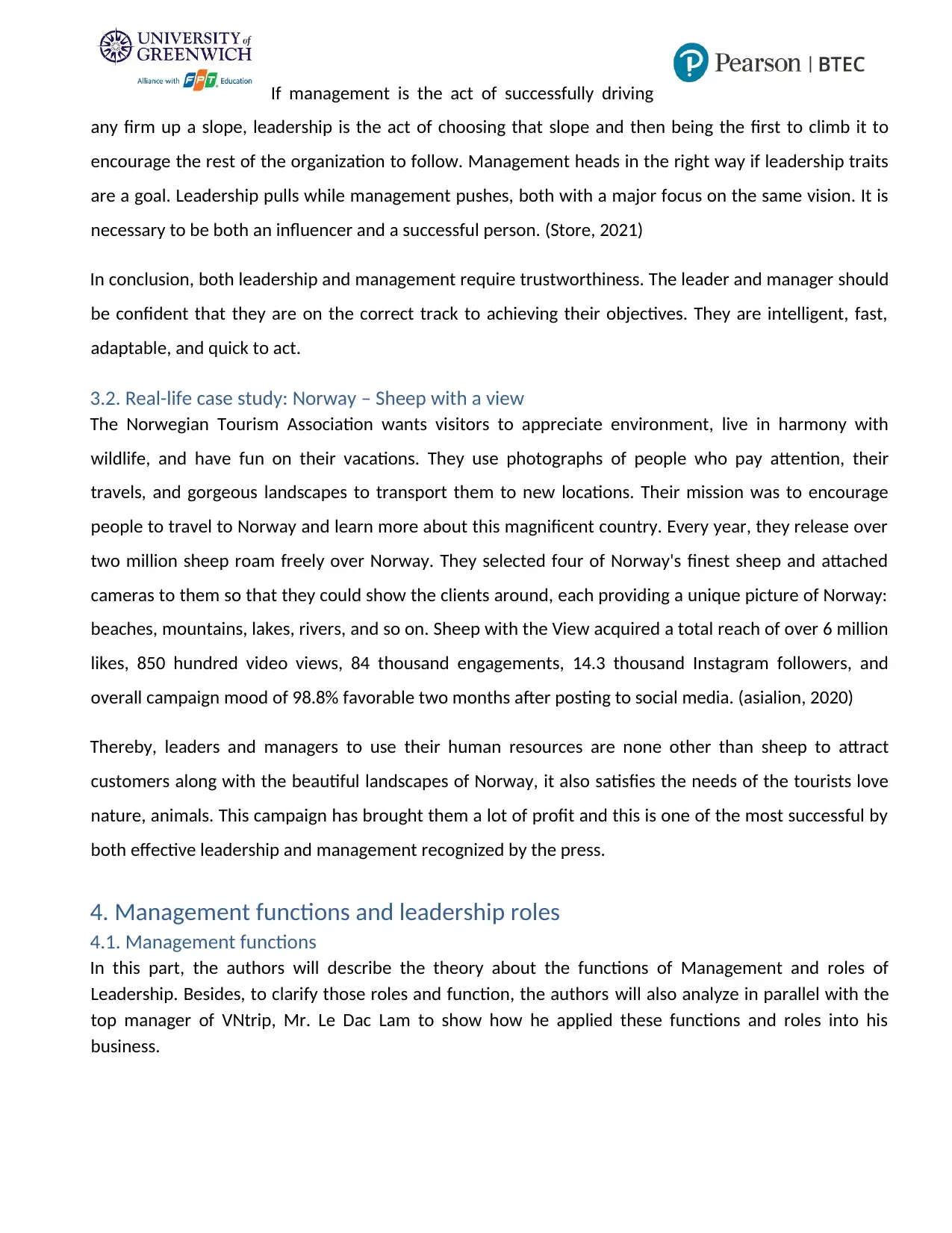
If management is the act of successfully driving
any firm up a slope, leadership is the act of choosing that slope and then being the first to climb it to
encourage the rest of the organization to follow. Management heads in the right way if leadership traits
are a goal. Leadership pulls while management pushes, both with a major focus on the same vision. It is
necessary to be both an influencer and a successful person. (Store, 2021)
In conclusion, both leadership and management require trustworthiness. The leader and manager should
be confident that they are on the correct track to achieving their objectives. They are intelligent, fast,
adaptable, and quick to act.
3.2. Real-life case study: Norway – Sheep with a view
The Norwegian Tourism Association wants visitors to appreciate environment, live in harmony with
wildlife, and have fun on their vacations. They use photographs of people who pay attention, their
travels, and gorgeous landscapes to transport them to new locations. Their mission was to encourage
people to travel to Norway and learn more about this magnificent country. Every year, they release over
two million sheep roam freely over Norway. They selected four of Norway's finest sheep and attached
cameras to them so that they could show the clients around, each providing a unique picture of Norway:
beaches, mountains, lakes, rivers, and so on. Sheep with the View acquired a total reach of over 6 million
likes, 850 hundred video views, 84 thousand engagements, 14.3 thousand Instagram followers, and
overall campaign mood of 98.8% favorable two months after posting to social media. (asialion, 2020)
Thereby, leaders and managers to use their human resources are none other than sheep to attract
customers along with the beautiful landscapes of Norway, it also satisfies the needs of the tourists love
nature, animals. This campaign has brought them a lot of profit and this is one of the most successful by
both effective leadership and management recognized by the press.
4. Management functions and leadership roles
4.1. Management functions
In this part, the authors will describe the theory about the functions of Management and roles of
Leadership. Besides, to clarify those roles and function, the authors will also analyze in parallel with the
top manager of VNtrip, Mr. Le Dac Lam to show how he applied these functions and roles into his
business.
any firm up a slope, leadership is the act of choosing that slope and then being the first to climb it to
encourage the rest of the organization to follow. Management heads in the right way if leadership traits
are a goal. Leadership pulls while management pushes, both with a major focus on the same vision. It is
necessary to be both an influencer and a successful person. (Store, 2021)
In conclusion, both leadership and management require trustworthiness. The leader and manager should
be confident that they are on the correct track to achieving their objectives. They are intelligent, fast,
adaptable, and quick to act.
3.2. Real-life case study: Norway – Sheep with a view
The Norwegian Tourism Association wants visitors to appreciate environment, live in harmony with
wildlife, and have fun on their vacations. They use photographs of people who pay attention, their
travels, and gorgeous landscapes to transport them to new locations. Their mission was to encourage
people to travel to Norway and learn more about this magnificent country. Every year, they release over
two million sheep roam freely over Norway. They selected four of Norway's finest sheep and attached
cameras to them so that they could show the clients around, each providing a unique picture of Norway:
beaches, mountains, lakes, rivers, and so on. Sheep with the View acquired a total reach of over 6 million
likes, 850 hundred video views, 84 thousand engagements, 14.3 thousand Instagram followers, and
overall campaign mood of 98.8% favorable two months after posting to social media. (asialion, 2020)
Thereby, leaders and managers to use their human resources are none other than sheep to attract
customers along with the beautiful landscapes of Norway, it also satisfies the needs of the tourists love
nature, animals. This campaign has brought them a lot of profit and this is one of the most successful by
both effective leadership and management recognized by the press.
4. Management functions and leadership roles
4.1. Management functions
In this part, the authors will describe the theory about the functions of Management and roles of
Leadership. Besides, to clarify those roles and function, the authors will also analyze in parallel with the
top manager of VNtrip, Mr. Le Dac Lam to show how he applied these functions and roles into his
business.
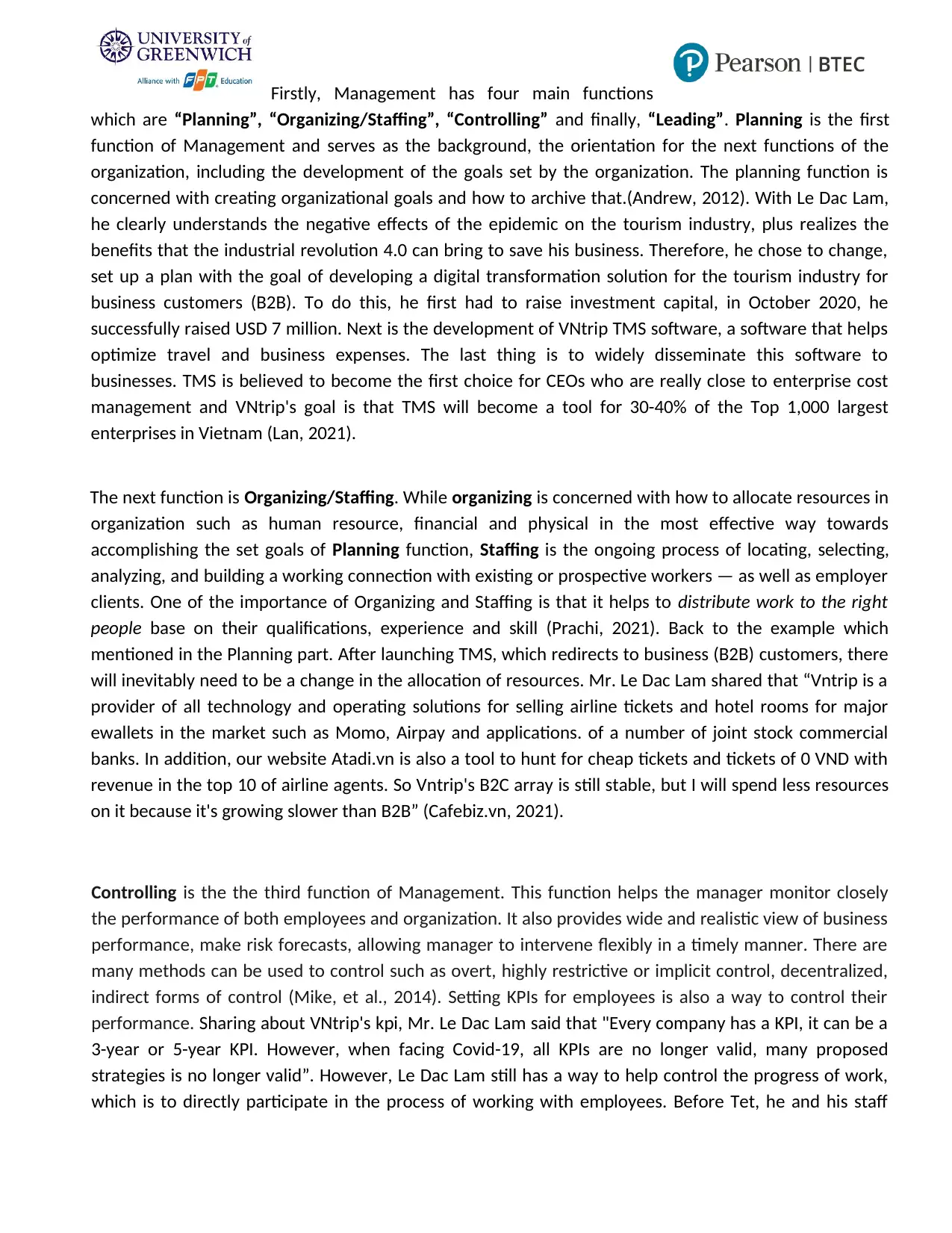
Firstly, Management has four main functions
which are “Planning”, “Organizing/Staffing”, “Controlling” and finally, “Leading”. Planning is the first
function of Management and serves as the background, the orientation for the next functions of the
organization, including the development of the goals set by the organization. The planning function is
concerned with creating organizational goals and how to archive that.(Andrew, 2012). With Le Dac Lam,
he clearly understands the negative effects of the epidemic on the tourism industry, plus realizes the
benefits that the industrial revolution 4.0 can bring to save his business. Therefore, he chose to change,
set up a plan with the goal of developing a digital transformation solution for the tourism industry for
business customers (B2B). To do this, he first had to raise investment capital, in October 2020, he
successfully raised USD 7 million. Next is the development of VNtrip TMS software, a software that helps
optimize travel and business expenses. The last thing is to widely disseminate this software to
businesses. TMS is believed to become the first choice for CEOs who are really close to enterprise cost
management and VNtrip's goal is that TMS will become a tool for 30-40% of the Top 1,000 largest
enterprises in Vietnam (Lan, 2021).
The next function is Organizing/Staffing. While organizing is concerned with how to allocate resources in
organization such as human resource, financial and physical in the most effective way towards
accomplishing the set goals of Planning function, Staffing is the ongoing process of locating, selecting,
analyzing, and building a working connection with existing or prospective workers — as well as employer
clients. One of the importance of Organizing and Staffing is that it helps to distribute work to the right
people base on their qualifications, experience and skill (Prachi, 2021). Back to the example which
mentioned in the Planning part. After launching TMS, which redirects to business (B2B) customers, there
will inevitably need to be a change in the allocation of resources. Mr. Le Dac Lam shared that “Vntrip is a
provider of all technology and operating solutions for selling airline tickets and hotel rooms for major
ewallets in the market such as Momo, Airpay and applications. of a number of joint stock commercial
banks. In addition, our website Atadi.vn is also a tool to hunt for cheap tickets and tickets of 0 VND with
revenue in the top 10 of airline agents. So Vntrip's B2C array is still stable, but I will spend less resources
on it because it's growing slower than B2B” (Cafebiz.vn, 2021).
Controlling is the the third function of Management. This function helps the manager monitor closely
the performance of both employees and organization. It also provides wide and realistic view of business
performance, make risk forecasts, allowing manager to intervene flexibly in a timely manner. There are
many methods can be used to control such as overt, highly restrictive or implicit control, decentralized,
indirect forms of control (Mike, et al., 2014). Setting KPIs for employees is also a way to control their
performance. Sharing about VNtrip's kpi, Mr. Le Dac Lam said that "Every company has a KPI, it can be a
3-year or 5-year KPI. However, when facing Covid-19, all KPIs are no longer valid, many proposed
strategies is no longer valid”. However, Le Dac Lam still has a way to help control the progress of work,
which is to directly participate in the process of working with employees. Before Tet, he and his staff
which are “Planning”, “Organizing/Staffing”, “Controlling” and finally, “Leading”. Planning is the first
function of Management and serves as the background, the orientation for the next functions of the
organization, including the development of the goals set by the organization. The planning function is
concerned with creating organizational goals and how to archive that.(Andrew, 2012). With Le Dac Lam,
he clearly understands the negative effects of the epidemic on the tourism industry, plus realizes the
benefits that the industrial revolution 4.0 can bring to save his business. Therefore, he chose to change,
set up a plan with the goal of developing a digital transformation solution for the tourism industry for
business customers (B2B). To do this, he first had to raise investment capital, in October 2020, he
successfully raised USD 7 million. Next is the development of VNtrip TMS software, a software that helps
optimize travel and business expenses. The last thing is to widely disseminate this software to
businesses. TMS is believed to become the first choice for CEOs who are really close to enterprise cost
management and VNtrip's goal is that TMS will become a tool for 30-40% of the Top 1,000 largest
enterprises in Vietnam (Lan, 2021).
The next function is Organizing/Staffing. While organizing is concerned with how to allocate resources in
organization such as human resource, financial and physical in the most effective way towards
accomplishing the set goals of Planning function, Staffing is the ongoing process of locating, selecting,
analyzing, and building a working connection with existing or prospective workers — as well as employer
clients. One of the importance of Organizing and Staffing is that it helps to distribute work to the right
people base on their qualifications, experience and skill (Prachi, 2021). Back to the example which
mentioned in the Planning part. After launching TMS, which redirects to business (B2B) customers, there
will inevitably need to be a change in the allocation of resources. Mr. Le Dac Lam shared that “Vntrip is a
provider of all technology and operating solutions for selling airline tickets and hotel rooms for major
ewallets in the market such as Momo, Airpay and applications. of a number of joint stock commercial
banks. In addition, our website Atadi.vn is also a tool to hunt for cheap tickets and tickets of 0 VND with
revenue in the top 10 of airline agents. So Vntrip's B2C array is still stable, but I will spend less resources
on it because it's growing slower than B2B” (Cafebiz.vn, 2021).
Controlling is the the third function of Management. This function helps the manager monitor closely
the performance of both employees and organization. It also provides wide and realistic view of business
performance, make risk forecasts, allowing manager to intervene flexibly in a timely manner. There are
many methods can be used to control such as overt, highly restrictive or implicit control, decentralized,
indirect forms of control (Mike, et al., 2014). Setting KPIs for employees is also a way to control their
performance. Sharing about VNtrip's kpi, Mr. Le Dac Lam said that "Every company has a KPI, it can be a
3-year or 5-year KPI. However, when facing Covid-19, all KPIs are no longer valid, many proposed
strategies is no longer valid”. However, Le Dac Lam still has a way to help control the progress of work,
which is to directly participate in the process of working with employees. Before Tet, he and his staff
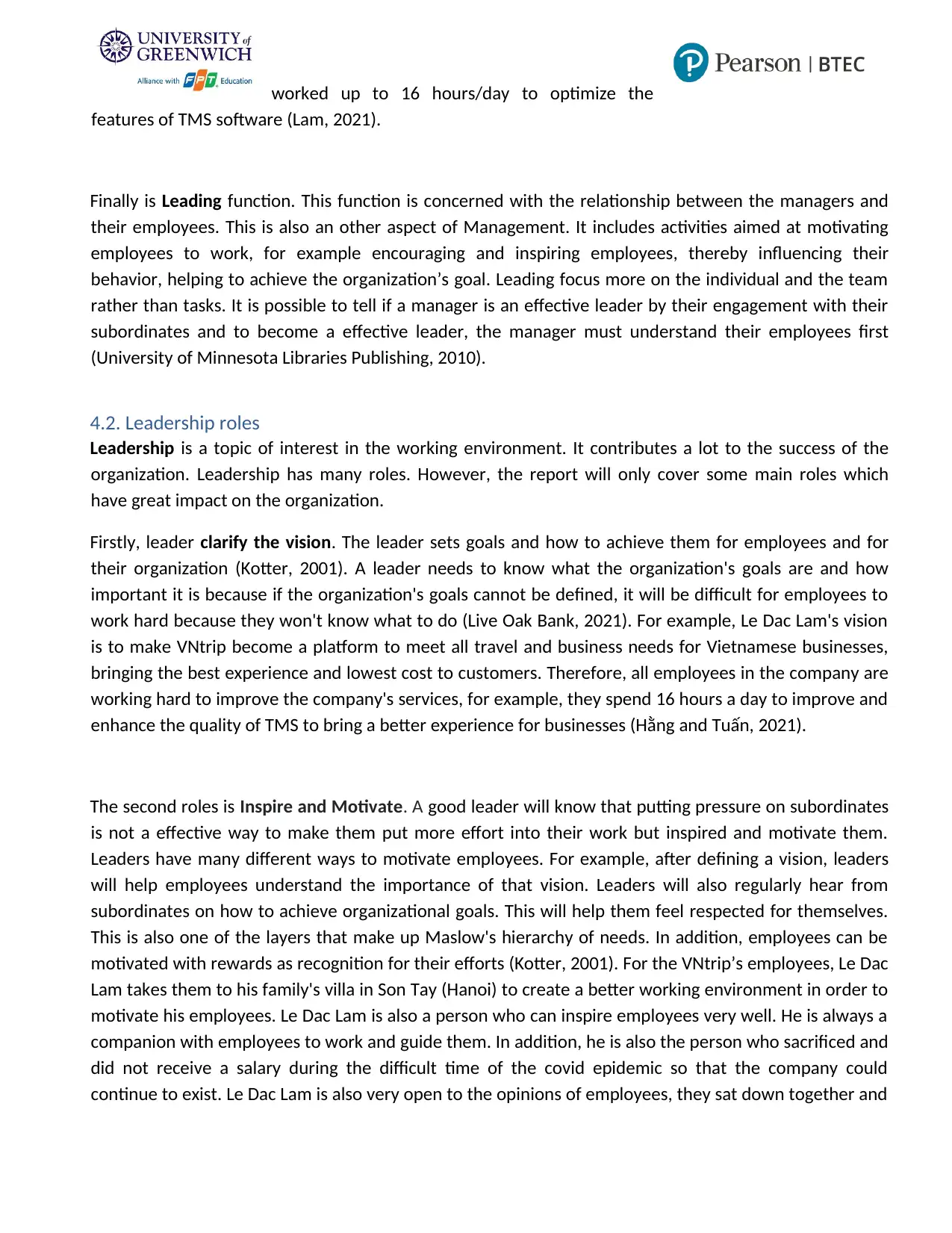
worked up to 16 hours/day to optimize the
features of TMS software (Lam, 2021).
Finally is Leading function. This function is concerned with the relationship between the managers and
their employees. This is also an other aspect of Management. It includes activities aimed at motivating
employees to work, for example encouraging and inspiring employees, thereby influencing their
behavior, helping to achieve the organization’s goal. Leading focus more on the individual and the team
rather than tasks. It is possible to tell if a manager is an effective leader by their engagement with their
subordinates and to become a effective leader, the manager must understand their employees first
(University of Minnesota Libraries Publishing, 2010).
4.2. Leadership roles
Leadership is a topic of interest in the working environment. It contributes a lot to the success of the
organization. Leadership has many roles. However, the report will only cover some main roles which
have great impact on the organization.
Firstly, leader clarify the vision. The leader sets goals and how to achieve them for employees and for
their organization (Kotter, 2001). A leader needs to know what the organization's goals are and how
important it is because if the organization's goals cannot be defined, it will be difficult for employees to
work hard because they won't know what to do (Live Oak Bank, 2021). For example, Le Dac Lam's vision
is to make VNtrip become a platform to meet all travel and business needs for Vietnamese businesses,
bringing the best experience and lowest cost to customers. Therefore, all employees in the company are
working hard to improve the company's services, for example, they spend 16 hours a day to improve and
enhance the quality of TMS to bring a better experience for businesses (Hằng and Tuấn, 2021).
The second roles is Inspire and Motivate. A good leader will know that putting pressure on subordinates
is not a effective way to make them put more effort into their work but inspired and motivate them.
Leaders have many different ways to motivate employees. For example, after defining a vision, leaders
will help employees understand the importance of that vision. Leaders will also regularly hear from
subordinates on how to achieve organizational goals. This will help them feel respected for themselves.
This is also one of the layers that make up Maslow's hierarchy of needs. In addition, employees can be
motivated with rewards as recognition for their efforts (Kotter, 2001). For the VNtrip’s employees, Le Dac
Lam takes them to his family's villa in Son Tay (Hanoi) to create a better working environment in order to
motivate his employees. Le Dac Lam is also a person who can inspire employees very well. He is always a
companion with employees to work and guide them. In addition, he is also the person who sacrificed and
did not receive a salary during the difficult time of the covid epidemic so that the company could
continue to exist. Le Dac Lam is also very open to the opinions of employees, they sat down together and
features of TMS software (Lam, 2021).
Finally is Leading function. This function is concerned with the relationship between the managers and
their employees. This is also an other aspect of Management. It includes activities aimed at motivating
employees to work, for example encouraging and inspiring employees, thereby influencing their
behavior, helping to achieve the organization’s goal. Leading focus more on the individual and the team
rather than tasks. It is possible to tell if a manager is an effective leader by their engagement with their
subordinates and to become a effective leader, the manager must understand their employees first
(University of Minnesota Libraries Publishing, 2010).
4.2. Leadership roles
Leadership is a topic of interest in the working environment. It contributes a lot to the success of the
organization. Leadership has many roles. However, the report will only cover some main roles which
have great impact on the organization.
Firstly, leader clarify the vision. The leader sets goals and how to achieve them for employees and for
their organization (Kotter, 2001). A leader needs to know what the organization's goals are and how
important it is because if the organization's goals cannot be defined, it will be difficult for employees to
work hard because they won't know what to do (Live Oak Bank, 2021). For example, Le Dac Lam's vision
is to make VNtrip become a platform to meet all travel and business needs for Vietnamese businesses,
bringing the best experience and lowest cost to customers. Therefore, all employees in the company are
working hard to improve the company's services, for example, they spend 16 hours a day to improve and
enhance the quality of TMS to bring a better experience for businesses (Hằng and Tuấn, 2021).
The second roles is Inspire and Motivate. A good leader will know that putting pressure on subordinates
is not a effective way to make them put more effort into their work but inspired and motivate them.
Leaders have many different ways to motivate employees. For example, after defining a vision, leaders
will help employees understand the importance of that vision. Leaders will also regularly hear from
subordinates on how to achieve organizational goals. This will help them feel respected for themselves.
This is also one of the layers that make up Maslow's hierarchy of needs. In addition, employees can be
motivated with rewards as recognition for their efforts (Kotter, 2001). For the VNtrip’s employees, Le Dac
Lam takes them to his family's villa in Son Tay (Hanoi) to create a better working environment in order to
motivate his employees. Le Dac Lam is also a person who can inspire employees very well. He is always a
companion with employees to work and guide them. In addition, he is also the person who sacrificed and
did not receive a salary during the difficult time of the covid epidemic so that the company could
continue to exist. Le Dac Lam is also very open to the opinions of employees, they sat down together and
Paraphrase This Document
Need a fresh take? Get an instant paraphrase of this document with our AI Paraphraser
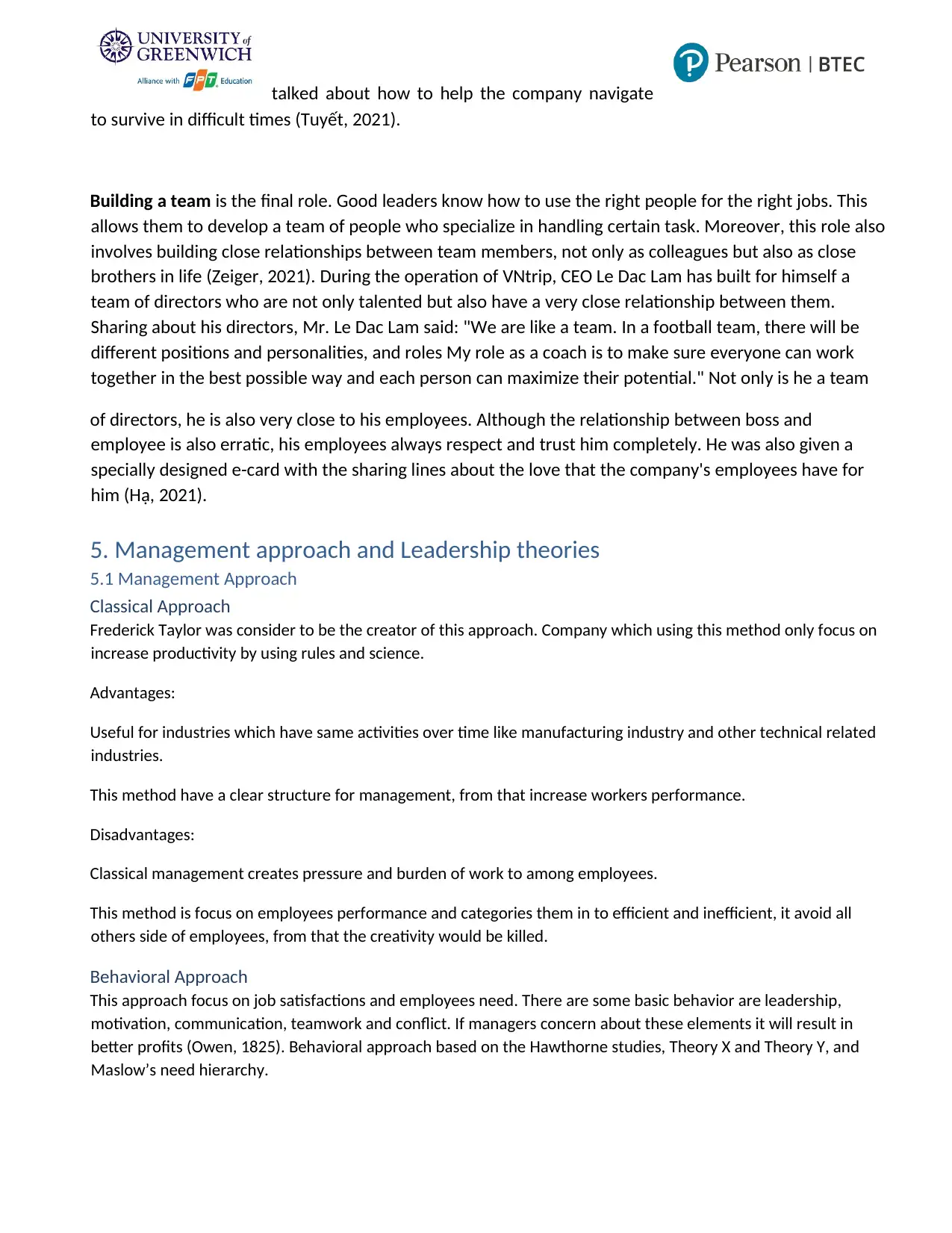
talked about how to help the company navigate
to survive in difficult times (Tuyết, 2021).
Building a team is the final role. Good leaders know how to use the right people for the right jobs. This
allows them to develop a team of people who specialize in handling certain task. Moreover, this role also
involves building close relationships between team members, not only as colleagues but also as close
brothers in life (Zeiger, 2021). During the operation of VNtrip, CEO Le Dac Lam has built for himself a
team of directors who are not only talented but also have a very close relationship between them.
Sharing about his directors, Mr. Le Dac Lam said: "We are like a team. In a football team, there will be
different positions and personalities, and roles My role as a coach is to make sure everyone can work
together in the best possible way and each person can maximize their potential." Not only is he a team
of directors, he is also very close to his employees. Although the relationship between boss and
employee is also erratic, his employees always respect and trust him completely. He was also given a
specially designed e-card with the sharing lines about the love that the company's employees have for
him (Hạ, 2021).
5. Management approach and Leadership theories
5.1 Management Approach
Classical Approach
Frederick Taylor was consider to be the creator of this approach. Company which using this method only focus on
increase productivity by using rules and science.
Advantages:
Useful for industries which have same activities over time like manufacturing industry and other technical related
industries.
This method have a clear structure for management, from that increase workers performance.
Disadvantages:
Classical management creates pressure and burden of work to among employees.
This method is focus on employees performance and categories them in to efficient and inefficient, it avoid all
others side of employees, from that the creativity would be killed.
Behavioral Approach
This approach focus on job satisfactions and employees need. There are some basic behavior are leadership,
motivation, communication, teamwork and conflict. If managers concern about these elements it will result in
better profits (Owen, 1825). Behavioral approach based on the Hawthorne studies, Theory X and Theory Y, and
Maslow’s need hierarchy.
to survive in difficult times (Tuyết, 2021).
Building a team is the final role. Good leaders know how to use the right people for the right jobs. This
allows them to develop a team of people who specialize in handling certain task. Moreover, this role also
involves building close relationships between team members, not only as colleagues but also as close
brothers in life (Zeiger, 2021). During the operation of VNtrip, CEO Le Dac Lam has built for himself a
team of directors who are not only talented but also have a very close relationship between them.
Sharing about his directors, Mr. Le Dac Lam said: "We are like a team. In a football team, there will be
different positions and personalities, and roles My role as a coach is to make sure everyone can work
together in the best possible way and each person can maximize their potential." Not only is he a team
of directors, he is also very close to his employees. Although the relationship between boss and
employee is also erratic, his employees always respect and trust him completely. He was also given a
specially designed e-card with the sharing lines about the love that the company's employees have for
him (Hạ, 2021).
5. Management approach and Leadership theories
5.1 Management Approach
Classical Approach
Frederick Taylor was consider to be the creator of this approach. Company which using this method only focus on
increase productivity by using rules and science.
Advantages:
Useful for industries which have same activities over time like manufacturing industry and other technical related
industries.
This method have a clear structure for management, from that increase workers performance.
Disadvantages:
Classical management creates pressure and burden of work to among employees.
This method is focus on employees performance and categories them in to efficient and inefficient, it avoid all
others side of employees, from that the creativity would be killed.
Behavioral Approach
This approach focus on job satisfactions and employees need. There are some basic behavior are leadership,
motivation, communication, teamwork and conflict. If managers concern about these elements it will result in
better profits (Owen, 1825). Behavioral approach based on the Hawthorne studies, Theory X and Theory Y, and
Maslow’s need hierarchy.
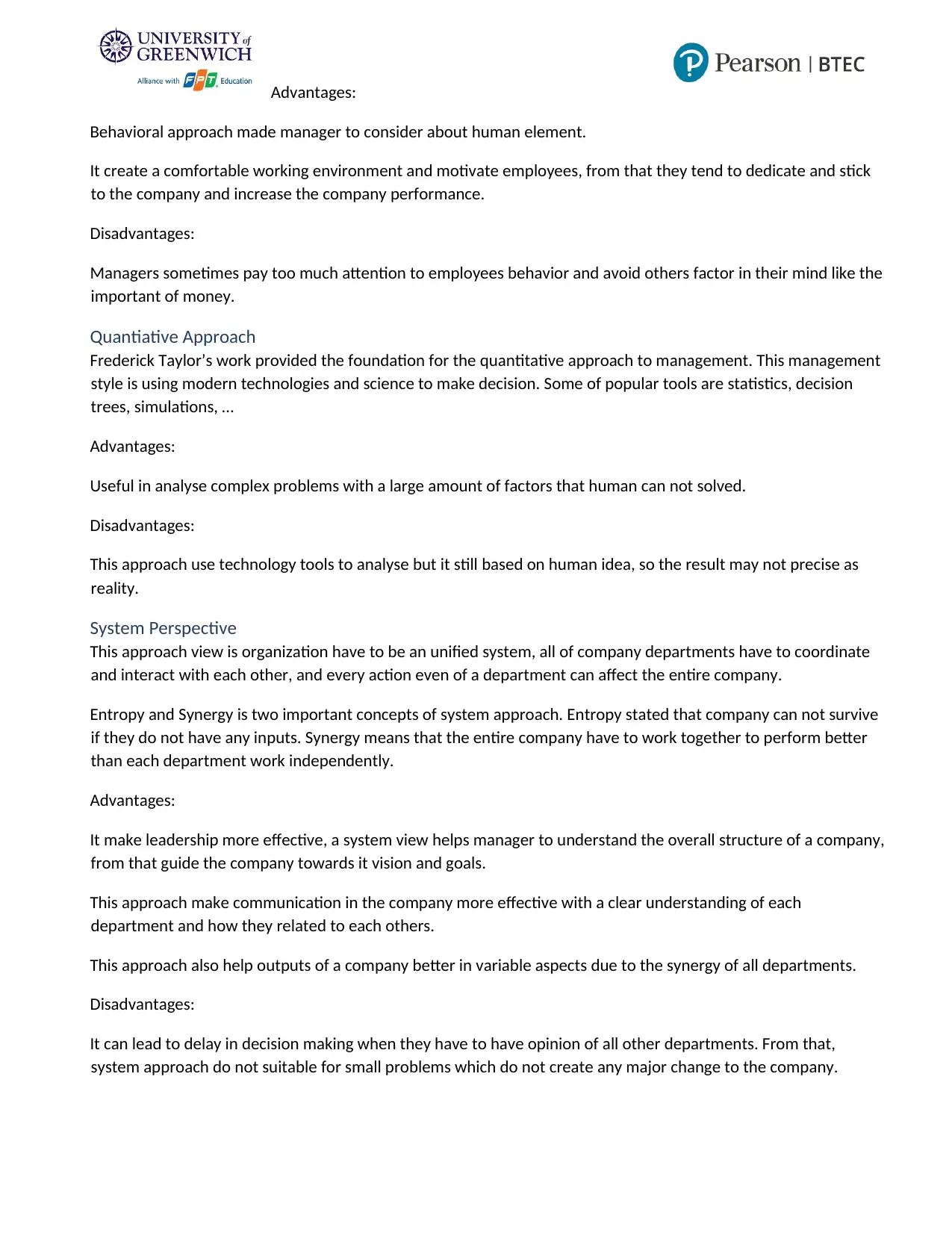
Advantages:
Behavioral approach made manager to consider about human element.
It create a comfortable working environment and motivate employees, from that they tend to dedicate and stick
to the company and increase the company performance.
Disadvantages:
Managers sometimes pay too much attention to employees behavior and avoid others factor in their mind like the
important of money.
Quantiative Approach
Frederick Taylor’s work provided the foundation for the quantitative approach to management. This management
style is using modern technologies and science to make decision. Some of popular tools are statistics, decision
trees, simulations, …
Advantages:
Useful in analyse complex problems with a large amount of factors that human can not solved.
Disadvantages:
This approach use technology tools to analyse but it still based on human idea, so the result may not precise as
reality.
System Perspective
This approach view is organization have to be an unified system, all of company departments have to coordinate
and interact with each other, and every action even of a department can affect the entire company.
Entropy and Synergy is two important concepts of system approach. Entropy stated that company can not survive
if they do not have any inputs. Synergy means that the entire company have to work together to perform better
than each department work independently.
Advantages:
It make leadership more effective, a system view helps manager to understand the overall structure of a company,
from that guide the company towards it vision and goals.
This approach make communication in the company more effective with a clear understanding of each
department and how they related to each others.
This approach also help outputs of a company better in variable aspects due to the synergy of all departments.
Disadvantages:
It can lead to delay in decision making when they have to have opinion of all other departments. From that,
system approach do not suitable for small problems which do not create any major change to the company.
Behavioral approach made manager to consider about human element.
It create a comfortable working environment and motivate employees, from that they tend to dedicate and stick
to the company and increase the company performance.
Disadvantages:
Managers sometimes pay too much attention to employees behavior and avoid others factor in their mind like the
important of money.
Quantiative Approach
Frederick Taylor’s work provided the foundation for the quantitative approach to management. This management
style is using modern technologies and science to make decision. Some of popular tools are statistics, decision
trees, simulations, …
Advantages:
Useful in analyse complex problems with a large amount of factors that human can not solved.
Disadvantages:
This approach use technology tools to analyse but it still based on human idea, so the result may not precise as
reality.
System Perspective
This approach view is organization have to be an unified system, all of company departments have to coordinate
and interact with each other, and every action even of a department can affect the entire company.
Entropy and Synergy is two important concepts of system approach. Entropy stated that company can not survive
if they do not have any inputs. Synergy means that the entire company have to work together to perform better
than each department work independently.
Advantages:
It make leadership more effective, a system view helps manager to understand the overall structure of a company,
from that guide the company towards it vision and goals.
This approach make communication in the company more effective with a clear understanding of each
department and how they related to each others.
This approach also help outputs of a company better in variable aspects due to the synergy of all departments.
Disadvantages:
It can lead to delay in decision making when they have to have opinion of all other departments. From that,
system approach do not suitable for small problems which do not create any major change to the company.
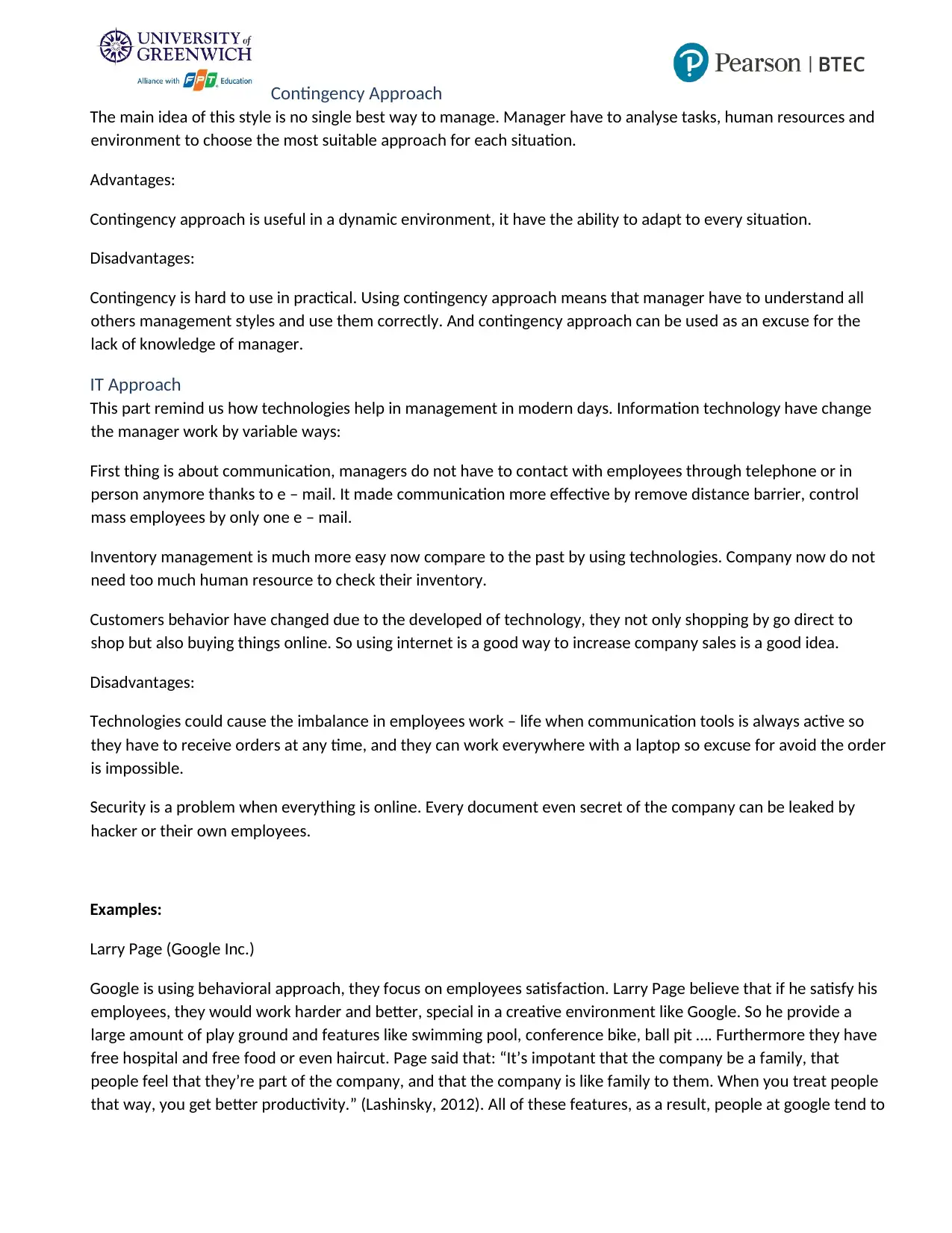
Contingency Approach
The main idea of this style is no single best way to manage. Manager have to analyse tasks, human resources and
environment to choose the most suitable approach for each situation.
Advantages:
Contingency approach is useful in a dynamic environment, it have the ability to adapt to every situation.
Disadvantages:
Contingency is hard to use in practical. Using contingency approach means that manager have to understand all
others management styles and use them correctly. And contingency approach can be used as an excuse for the
lack of knowledge of manager.
IT Approach
This part remind us how technologies help in management in modern days. Information technology have change
the manager work by variable ways:
First thing is about communication, managers do not have to contact with employees through telephone or in
person anymore thanks to e – mail. It made communication more effective by remove distance barrier, control
mass employees by only one e – mail.
Inventory management is much more easy now compare to the past by using technologies. Company now do not
need too much human resource to check their inventory.
Customers behavior have changed due to the developed of technology, they not only shopping by go direct to
shop but also buying things online. So using internet is a good way to increase company sales is a good idea.
Disadvantages:
Technologies could cause the imbalance in employees work – life when communication tools is always active so
they have to receive orders at any time, and they can work everywhere with a laptop so excuse for avoid the order
is impossible.
Security is a problem when everything is online. Every document even secret of the company can be leaked by
hacker or their own employees.
Examples:
Larry Page (Google Inc.)
Google is using behavioral approach, they focus on employees satisfaction. Larry Page believe that if he satisfy his
employees, they would work harder and better, special in a creative environment like Google. So he provide a
large amount of play ground and features like swimming pool, conference bike, ball pit …. Furthermore they have
free hospital and free food or even haircut. Page said that: “It’s impotant that the company be a family, that
people feel that they’re part of the company, and that the company is like family to them. When you treat people
that way, you get better productivity.” (Lashinsky, 2012). All of these features, as a result, people at google tend to
The main idea of this style is no single best way to manage. Manager have to analyse tasks, human resources and
environment to choose the most suitable approach for each situation.
Advantages:
Contingency approach is useful in a dynamic environment, it have the ability to adapt to every situation.
Disadvantages:
Contingency is hard to use in practical. Using contingency approach means that manager have to understand all
others management styles and use them correctly. And contingency approach can be used as an excuse for the
lack of knowledge of manager.
IT Approach
This part remind us how technologies help in management in modern days. Information technology have change
the manager work by variable ways:
First thing is about communication, managers do not have to contact with employees through telephone or in
person anymore thanks to e – mail. It made communication more effective by remove distance barrier, control
mass employees by only one e – mail.
Inventory management is much more easy now compare to the past by using technologies. Company now do not
need too much human resource to check their inventory.
Customers behavior have changed due to the developed of technology, they not only shopping by go direct to
shop but also buying things online. So using internet is a good way to increase company sales is a good idea.
Disadvantages:
Technologies could cause the imbalance in employees work – life when communication tools is always active so
they have to receive orders at any time, and they can work everywhere with a laptop so excuse for avoid the order
is impossible.
Security is a problem when everything is online. Every document even secret of the company can be leaked by
hacker or their own employees.
Examples:
Larry Page (Google Inc.)
Google is using behavioral approach, they focus on employees satisfaction. Larry Page believe that if he satisfy his
employees, they would work harder and better, special in a creative environment like Google. So he provide a
large amount of play ground and features like swimming pool, conference bike, ball pit …. Furthermore they have
free hospital and free food or even haircut. Page said that: “It’s impotant that the company be a family, that
people feel that they’re part of the company, and that the company is like family to them. When you treat people
that way, you get better productivity.” (Lashinsky, 2012). All of these features, as a result, people at google tend to
Secure Best Marks with AI Grader
Need help grading? Try our AI Grader for instant feedback on your assignments.
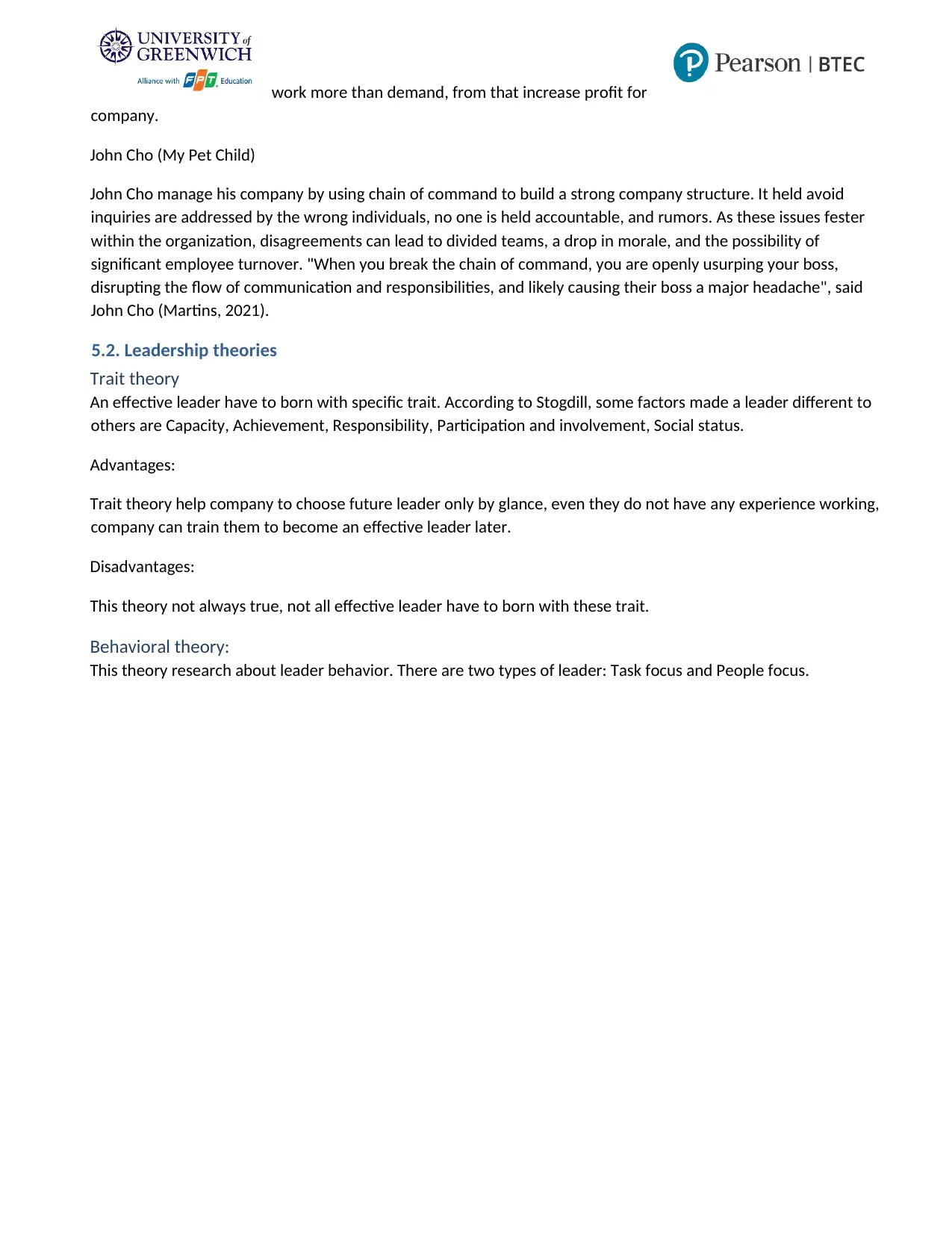
work more than demand, from that increase profit for
company.
John Cho (My Pet Child)
John Cho manage his company by using chain of command to build a strong company structure. It held avoid
inquiries are addressed by the wrong individuals, no one is held accountable, and rumors. As these issues fester
within the organization, disagreements can lead to divided teams, a drop in morale, and the possibility of
significant employee turnover. "When you break the chain of command, you are openly usurping your boss,
disrupting the flow of communication and responsibilities, and likely causing their boss a major headache", said
John Cho (Martins, 2021).
5.2. Leadership theories
Trait theory
An effective leader have to born with specific trait. According to Stogdill, some factors made a leader different to
others are Capacity, Achievement, Responsibility, Participation and involvement, Social status.
Advantages:
Trait theory help company to choose future leader only by glance, even they do not have any experience working,
company can train them to become an effective leader later.
Disadvantages:
This theory not always true, not all effective leader have to born with these trait.
Behavioral theory:
This theory research about leader behavior. There are two types of leader: Task focus and People focus.
company.
John Cho (My Pet Child)
John Cho manage his company by using chain of command to build a strong company structure. It held avoid
inquiries are addressed by the wrong individuals, no one is held accountable, and rumors. As these issues fester
within the organization, disagreements can lead to divided teams, a drop in morale, and the possibility of
significant employee turnover. "When you break the chain of command, you are openly usurping your boss,
disrupting the flow of communication and responsibilities, and likely causing their boss a major headache", said
John Cho (Martins, 2021).
5.2. Leadership theories
Trait theory
An effective leader have to born with specific trait. According to Stogdill, some factors made a leader different to
others are Capacity, Achievement, Responsibility, Participation and involvement, Social status.
Advantages:
Trait theory help company to choose future leader only by glance, even they do not have any experience working,
company can train them to become an effective leader later.
Disadvantages:
This theory not always true, not all effective leader have to born with these trait.
Behavioral theory:
This theory research about leader behavior. There are two types of leader: Task focus and People focus.
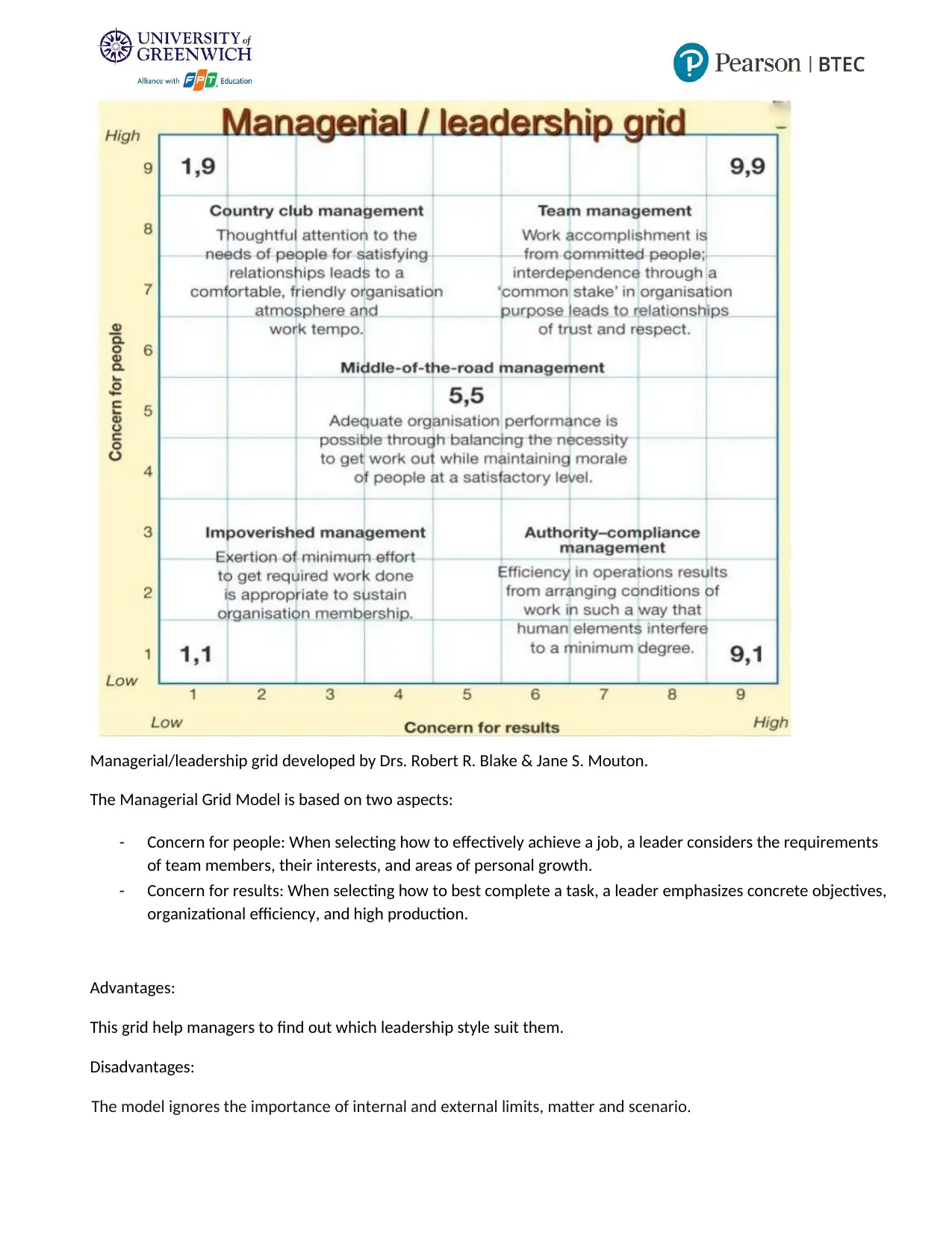
Managerial/leadership grid developed by Drs. Robert R. Blake & Jane S. Mouton.
The Managerial Grid Model is based on two aspects:
- Concern for people: When selecting how to effectively achieve a job, a leader considers the requirements
of team members, their interests, and areas of personal growth.
- Concern for results: When selecting how to best complete a task, a leader emphasizes concrete objectives,
organizational efficiency, and high production.
Advantages:
This grid help managers to find out which leadership style suit them.
Disadvantages:
The model ignores the importance of internal and external limits, matter and scenario.
The Managerial Grid Model is based on two aspects:
- Concern for people: When selecting how to effectively achieve a job, a leader considers the requirements
of team members, their interests, and areas of personal growth.
- Concern for results: When selecting how to best complete a task, a leader emphasizes concrete objectives,
organizational efficiency, and high production.
Advantages:
This grid help managers to find out which leadership style suit them.
Disadvantages:
The model ignores the importance of internal and external limits, matter and scenario.
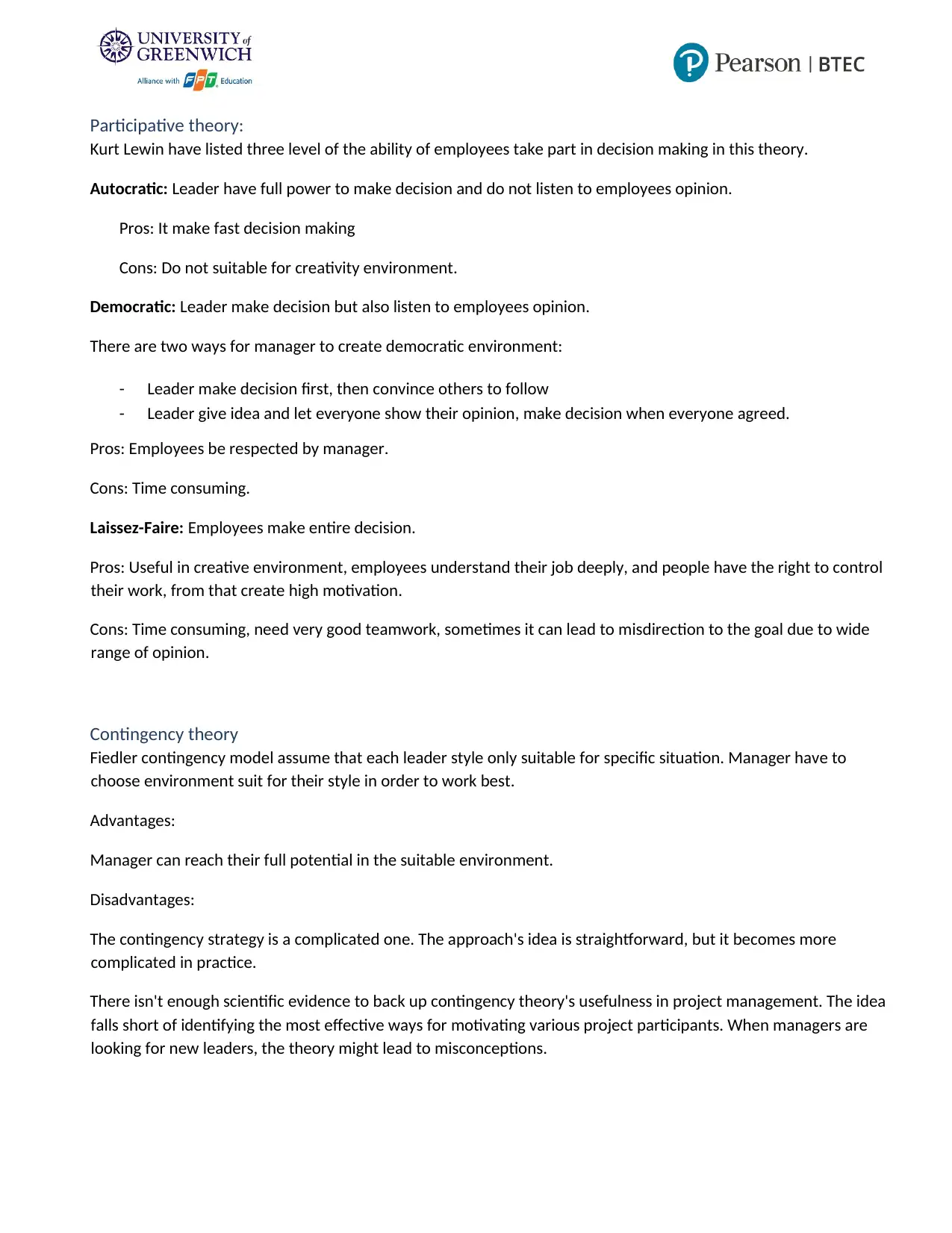
Participative theory:
Kurt Lewin have listed three level of the ability of employees take part in decision making in this theory.
Autocratic: Leader have full power to make decision and do not listen to employees opinion.
Pros: It make fast decision making
Cons: Do not suitable for creativity environment.
Democratic: Leader make decision but also listen to employees opinion.
There are two ways for manager to create democratic environment:
- Leader make decision first, then convince others to follow
- Leader give idea and let everyone show their opinion, make decision when everyone agreed.
Pros: Employees be respected by manager.
Cons: Time consuming.
Laissez-Faire: Employees make entire decision.
Pros: Useful in creative environment, employees understand their job deeply, and people have the right to control
their work, from that create high motivation.
Cons: Time consuming, need very good teamwork, sometimes it can lead to misdirection to the goal due to wide
range of opinion.
Contingency theory
Fiedler contingency model assume that each leader style only suitable for specific situation. Manager have to
choose environment suit for their style in order to work best.
Advantages:
Manager can reach their full potential in the suitable environment.
Disadvantages:
The contingency strategy is a complicated one. The approach's idea is straightforward, but it becomes more
complicated in practice.
There isn't enough scientific evidence to back up contingency theory's usefulness in project management. The idea
falls short of identifying the most effective ways for motivating various project participants. When managers are
looking for new leaders, the theory might lead to misconceptions.
Kurt Lewin have listed three level of the ability of employees take part in decision making in this theory.
Autocratic: Leader have full power to make decision and do not listen to employees opinion.
Pros: It make fast decision making
Cons: Do not suitable for creativity environment.
Democratic: Leader make decision but also listen to employees opinion.
There are two ways for manager to create democratic environment:
- Leader make decision first, then convince others to follow
- Leader give idea and let everyone show their opinion, make decision when everyone agreed.
Pros: Employees be respected by manager.
Cons: Time consuming.
Laissez-Faire: Employees make entire decision.
Pros: Useful in creative environment, employees understand their job deeply, and people have the right to control
their work, from that create high motivation.
Cons: Time consuming, need very good teamwork, sometimes it can lead to misdirection to the goal due to wide
range of opinion.
Contingency theory
Fiedler contingency model assume that each leader style only suitable for specific situation. Manager have to
choose environment suit for their style in order to work best.
Advantages:
Manager can reach their full potential in the suitable environment.
Disadvantages:
The contingency strategy is a complicated one. The approach's idea is straightforward, but it becomes more
complicated in practice.
There isn't enough scientific evidence to back up contingency theory's usefulness in project management. The idea
falls short of identifying the most effective ways for motivating various project participants. When managers are
looking for new leaders, the theory might lead to misconceptions.
Paraphrase This Document
Need a fresh take? Get an instant paraphrase of this document with our AI Paraphraser
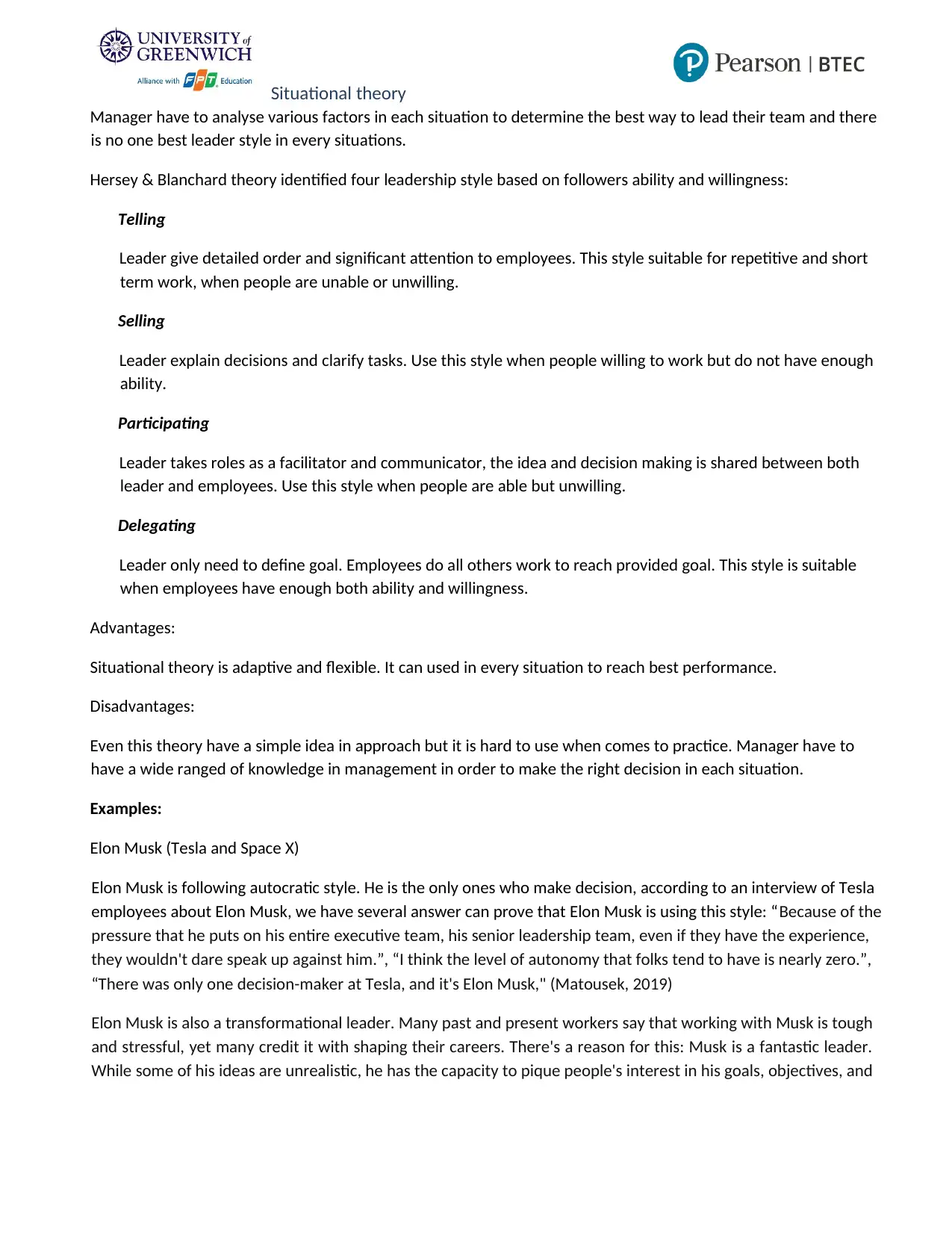
Situational theory
Manager have to analyse various factors in each situation to determine the best way to lead their team and there
is no one best leader style in every situations.
Hersey & Blanchard theory identified four leadership style based on followers ability and willingness:
Telling
Leader give detailed order and significant attention to employees. This style suitable for repetitive and short
term work, when people are unable or unwilling.
Selling
Leader explain decisions and clarify tasks. Use this style when people willing to work but do not have enough
ability.
Participating
Leader takes roles as a facilitator and communicator, the idea and decision making is shared between both
leader and employees. Use this style when people are able but unwilling.
Delegating
Leader only need to define goal. Employees do all others work to reach provided goal. This style is suitable
when employees have enough both ability and willingness.
Advantages:
Situational theory is adaptive and flexible. It can used in every situation to reach best performance.
Disadvantages:
Even this theory have a simple idea in approach but it is hard to use when comes to practice. Manager have to
have a wide ranged of knowledge in management in order to make the right decision in each situation.
Examples:
Elon Musk (Tesla and Space X)
Elon Musk is following autocratic style. He is the only ones who make decision, according to an interview of Tesla
employees about Elon Musk, we have several answer can prove that Elon Musk is using this style: “Because of the
pressure that he puts on his entire executive team, his senior leadership team, even if they have the experience,
they wouldn't dare speak up against him.”, “I think the level of autonomy that folks tend to have is nearly zero.”,
“There was only one decision-maker at Tesla, and it's Elon Musk," (Matousek, 2019)
Elon Musk is also a transformational leader. Many past and present workers say that working with Musk is tough
and stressful, yet many credit it with shaping their careers. There's a reason for this: Musk is a fantastic leader.
While some of his ideas are unrealistic, he has the capacity to pique people's interest in his goals, objectives, and
Manager have to analyse various factors in each situation to determine the best way to lead their team and there
is no one best leader style in every situations.
Hersey & Blanchard theory identified four leadership style based on followers ability and willingness:
Telling
Leader give detailed order and significant attention to employees. This style suitable for repetitive and short
term work, when people are unable or unwilling.
Selling
Leader explain decisions and clarify tasks. Use this style when people willing to work but do not have enough
ability.
Participating
Leader takes roles as a facilitator and communicator, the idea and decision making is shared between both
leader and employees. Use this style when people are able but unwilling.
Delegating
Leader only need to define goal. Employees do all others work to reach provided goal. This style is suitable
when employees have enough both ability and willingness.
Advantages:
Situational theory is adaptive and flexible. It can used in every situation to reach best performance.
Disadvantages:
Even this theory have a simple idea in approach but it is hard to use when comes to practice. Manager have to
have a wide ranged of knowledge in management in order to make the right decision in each situation.
Examples:
Elon Musk (Tesla and Space X)
Elon Musk is following autocratic style. He is the only ones who make decision, according to an interview of Tesla
employees about Elon Musk, we have several answer can prove that Elon Musk is using this style: “Because of the
pressure that he puts on his entire executive team, his senior leadership team, even if they have the experience,
they wouldn't dare speak up against him.”, “I think the level of autonomy that folks tend to have is nearly zero.”,
“There was only one decision-maker at Tesla, and it's Elon Musk," (Matousek, 2019)
Elon Musk is also a transformational leader. Many past and present workers say that working with Musk is tough
and stressful, yet many credit it with shaping their careers. There's a reason for this: Musk is a fantastic leader.
While some of his ideas are unrealistic, he has the capacity to pique people's interest in his goals, objectives, and
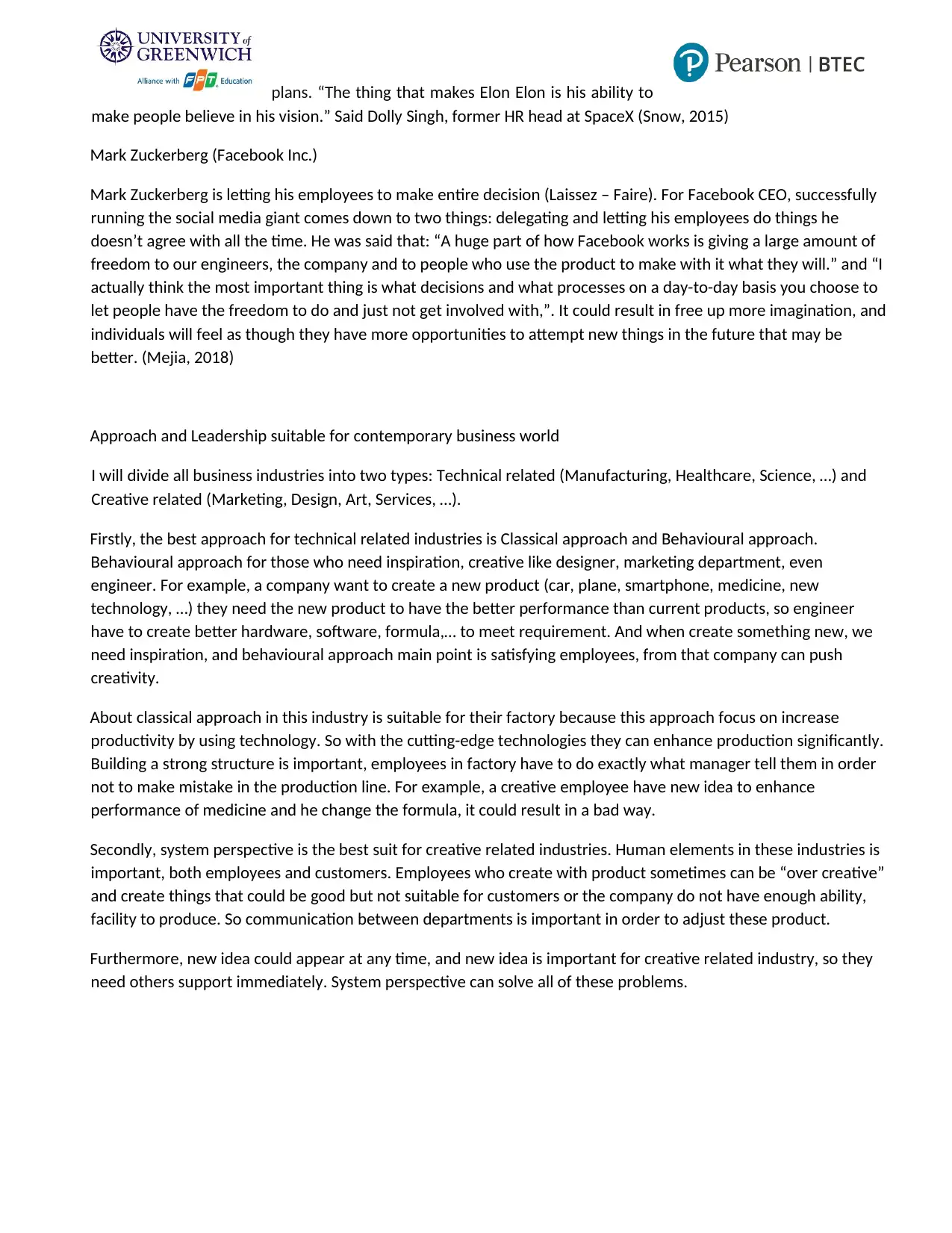
plans. “The thing that makes Elon Elon is his ability to
make people believe in his vision.” Said Dolly Singh, former HR head at SpaceX (Snow, 2015)
Mark Zuckerberg (Facebook Inc.)
Mark Zuckerberg is letting his employees to make entire decision (Laissez – Faire). For Facebook CEO, successfully
running the social media giant comes down to two things: delegating and letting his employees do things he
doesn’t agree with all the time. He was said that: “A huge part of how Facebook works is giving a large amount of
freedom to our engineers, the company and to people who use the product to make with it what they will.” and “I
actually think the most important thing is what decisions and what processes on a day-to-day basis you choose to
let people have the freedom to do and just not get involved with,”. It could result in free up more imagination, and
individuals will feel as though they have more opportunities to attempt new things in the future that may be
better. (Mejia, 2018)
Approach and Leadership suitable for contemporary business world
I will divide all business industries into two types: Technical related (Manufacturing, Healthcare, Science, …) and
Creative related (Marketing, Design, Art, Services, …).
Firstly, the best approach for technical related industries is Classical approach and Behavioural approach.
Behavioural approach for those who need inspiration, creative like designer, marketing department, even
engineer. For example, a company want to create a new product (car, plane, smartphone, medicine, new
technology, …) they need the new product to have the better performance than current products, so engineer
have to create better hardware, software, formula,… to meet requirement. And when create something new, we
need inspiration, and behavioural approach main point is satisfying employees, from that company can push
creativity.
About classical approach in this industry is suitable for their factory because this approach focus on increase
productivity by using technology. So with the cutting-edge technologies they can enhance production significantly.
Building a strong structure is important, employees in factory have to do exactly what manager tell them in order
not to make mistake in the production line. For example, a creative employee have new idea to enhance
performance of medicine and he change the formula, it could result in a bad way.
Secondly, system perspective is the best suit for creative related industries. Human elements in these industries is
important, both employees and customers. Employees who create with product sometimes can be “over creative”
and create things that could be good but not suitable for customers or the company do not have enough ability,
facility to produce. So communication between departments is important in order to adjust these product.
Furthermore, new idea could appear at any time, and new idea is important for creative related industry, so they
need others support immediately. System perspective can solve all of these problems.
make people believe in his vision.” Said Dolly Singh, former HR head at SpaceX (Snow, 2015)
Mark Zuckerberg (Facebook Inc.)
Mark Zuckerberg is letting his employees to make entire decision (Laissez – Faire). For Facebook CEO, successfully
running the social media giant comes down to two things: delegating and letting his employees do things he
doesn’t agree with all the time. He was said that: “A huge part of how Facebook works is giving a large amount of
freedom to our engineers, the company and to people who use the product to make with it what they will.” and “I
actually think the most important thing is what decisions and what processes on a day-to-day basis you choose to
let people have the freedom to do and just not get involved with,”. It could result in free up more imagination, and
individuals will feel as though they have more opportunities to attempt new things in the future that may be
better. (Mejia, 2018)
Approach and Leadership suitable for contemporary business world
I will divide all business industries into two types: Technical related (Manufacturing, Healthcare, Science, …) and
Creative related (Marketing, Design, Art, Services, …).
Firstly, the best approach for technical related industries is Classical approach and Behavioural approach.
Behavioural approach for those who need inspiration, creative like designer, marketing department, even
engineer. For example, a company want to create a new product (car, plane, smartphone, medicine, new
technology, …) they need the new product to have the better performance than current products, so engineer
have to create better hardware, software, formula,… to meet requirement. And when create something new, we
need inspiration, and behavioural approach main point is satisfying employees, from that company can push
creativity.
About classical approach in this industry is suitable for their factory because this approach focus on increase
productivity by using technology. So with the cutting-edge technologies they can enhance production significantly.
Building a strong structure is important, employees in factory have to do exactly what manager tell them in order
not to make mistake in the production line. For example, a creative employee have new idea to enhance
performance of medicine and he change the formula, it could result in a bad way.
Secondly, system perspective is the best suit for creative related industries. Human elements in these industries is
important, both employees and customers. Employees who create with product sometimes can be “over creative”
and create things that could be good but not suitable for customers or the company do not have enough ability,
facility to produce. So communication between departments is important in order to adjust these product.
Furthermore, new idea could appear at any time, and new idea is important for creative related industry, so they
need others support immediately. System perspective can solve all of these problems.
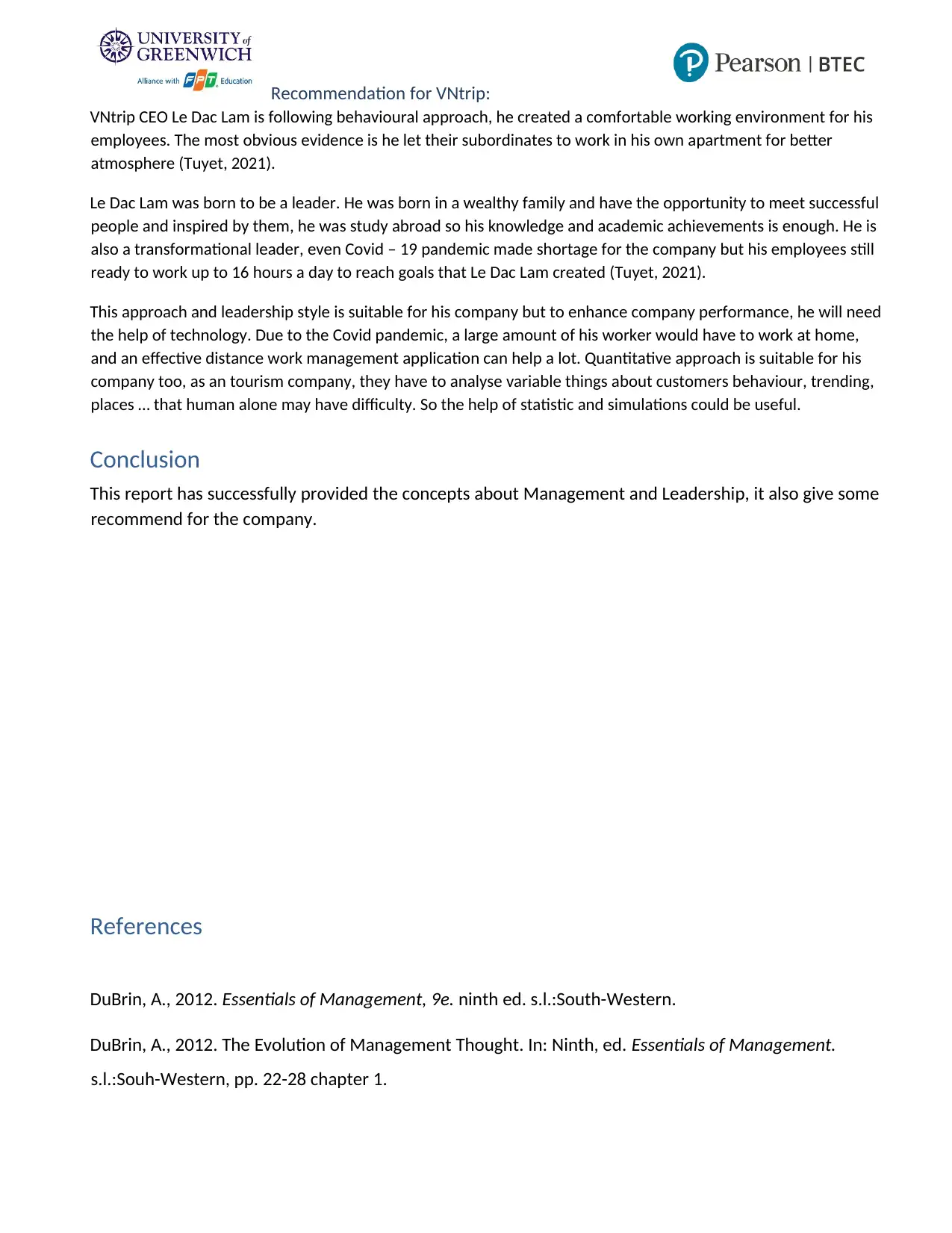
Recommendation for VNtrip:
VNtrip CEO Le Dac Lam is following behavioural approach, he created a comfortable working environment for his
employees. The most obvious evidence is he let their subordinates to work in his own apartment for better
atmosphere (Tuyet, 2021).
Le Dac Lam was born to be a leader. He was born in a wealthy family and have the opportunity to meet successful
people and inspired by them, he was study abroad so his knowledge and academic achievements is enough. He is
also a transformational leader, even Covid – 19 pandemic made shortage for the company but his employees still
ready to work up to 16 hours a day to reach goals that Le Dac Lam created (Tuyet, 2021).
This approach and leadership style is suitable for his company but to enhance company performance, he will need
the help of technology. Due to the Covid pandemic, a large amount of his worker would have to work at home,
and an effective distance work management application can help a lot. Quantitative approach is suitable for his
company too, as an tourism company, they have to analyse variable things about customers behaviour, trending,
places … that human alone may have difficulty. So the help of statistic and simulations could be useful.
Conclusion
This report has successfully provided the concepts about Management and Leadership, it also give some
recommend for the company.
References
DuBrin, A., 2012. Essentials of Management, 9e. ninth ed. s.l.:South-Western.
DuBrin, A., 2012. The Evolution of Management Thought. In: Ninth, ed. Essentials of Management.
s.l.:Souh-Western, pp. 22-28 chapter 1.
VNtrip CEO Le Dac Lam is following behavioural approach, he created a comfortable working environment for his
employees. The most obvious evidence is he let their subordinates to work in his own apartment for better
atmosphere (Tuyet, 2021).
Le Dac Lam was born to be a leader. He was born in a wealthy family and have the opportunity to meet successful
people and inspired by them, he was study abroad so his knowledge and academic achievements is enough. He is
also a transformational leader, even Covid – 19 pandemic made shortage for the company but his employees still
ready to work up to 16 hours a day to reach goals that Le Dac Lam created (Tuyet, 2021).
This approach and leadership style is suitable for his company but to enhance company performance, he will need
the help of technology. Due to the Covid pandemic, a large amount of his worker would have to work at home,
and an effective distance work management application can help a lot. Quantitative approach is suitable for his
company too, as an tourism company, they have to analyse variable things about customers behaviour, trending,
places … that human alone may have difficulty. So the help of statistic and simulations could be useful.
Conclusion
This report has successfully provided the concepts about Management and Leadership, it also give some
recommend for the company.
References
DuBrin, A., 2012. Essentials of Management, 9e. ninth ed. s.l.:South-Western.
DuBrin, A., 2012. The Evolution of Management Thought. In: Ninth, ed. Essentials of Management.
s.l.:Souh-Western, pp. 22-28 chapter 1.
Secure Best Marks with AI Grader
Need help grading? Try our AI Grader for instant feedback on your assignments.
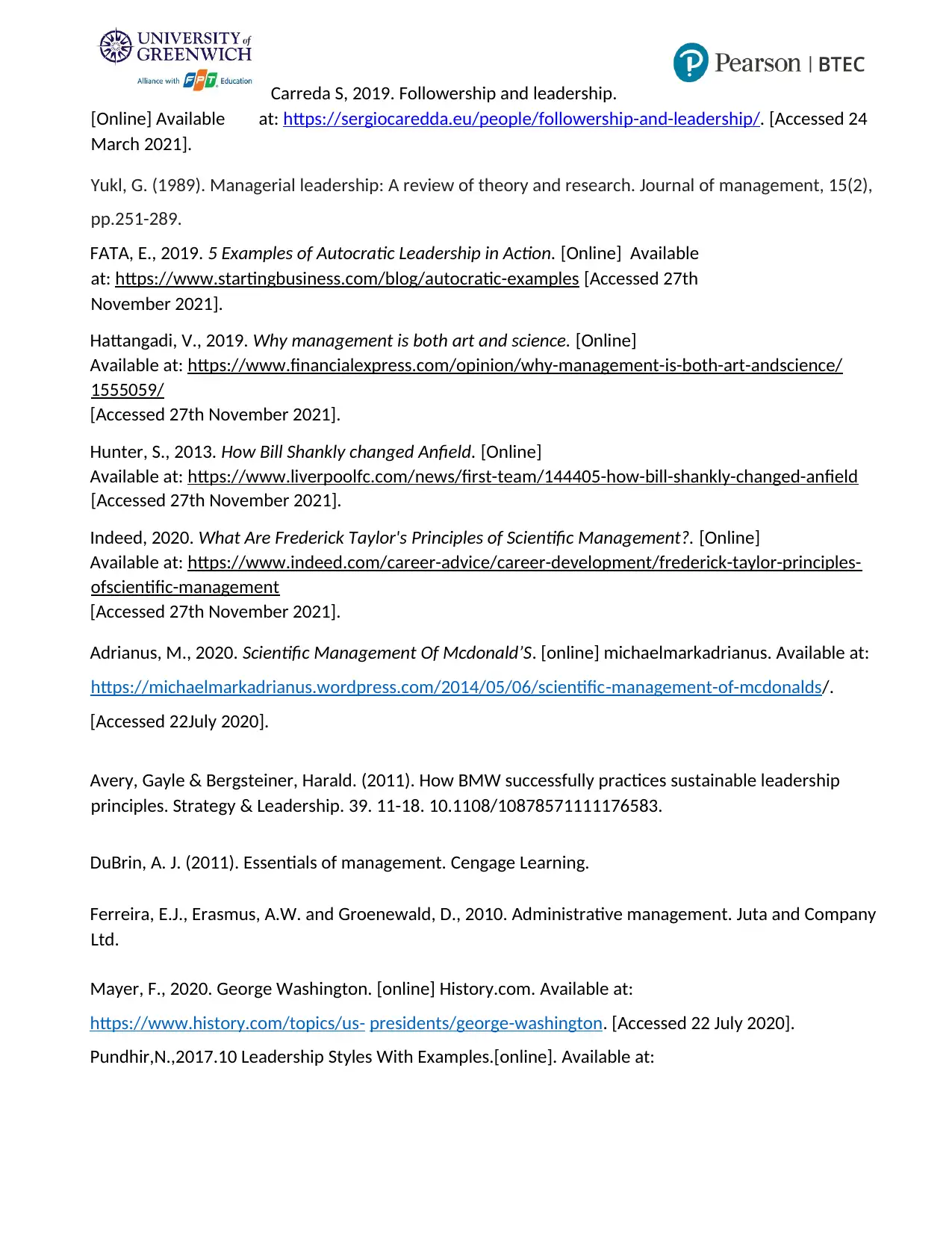
Carreda S, 2019. Followership and leadership.
[Online] Available at: https://sergiocaredda.eu/people/followership-and-leadership/. [Accessed 24
March 2021].
Yukl, G. (1989). Managerial leadership: A review of theory and research. Journal of management, 15(2),
pp.251-289.
FATA, E., 2019. 5 Examples of Autocratic Leadership in Action. [Online] Available
at: https://www.startingbusiness.com/blog/autocratic-examples [Accessed 27th
November 2021].
Hattangadi, V., 2019. Why management is both art and science. [Online]
Available at: https://www.financialexpress.com/opinion/why-management-is-both-art-andscience/
1555059/
[Accessed 27th November 2021].
Hunter, S., 2013. How Bill Shankly changed Anfield. [Online]
Available at: https://www.liverpoolfc.com/news/first-team/144405-how-bill-shankly-changed-anfield
[Accessed 27th November 2021].
Indeed, 2020. What Are Frederick Taylor's Principles of Scientific Management?. [Online]
Available at: https://www.indeed.com/career-advice/career-development/frederick-taylor-principles-
ofscientific-management
[Accessed 27th November 2021].
Adrianus, M., 2020. Scientific Management Of Mcdonald’S. [online] michaelmarkadrianus. Available at:
https://michaelmarkadrianus.wordpress.com/2014/05/06/scientific-management-of-mcdonalds/.
[Accessed 22July 2020].
Avery, Gayle & Bergsteiner, Harald. (2011). How BMW successfully practices sustainable leadership
principles. Strategy & Leadership. 39. 11-18. 10.1108/10878571111176583.
DuBrin, A. J. (2011). Essentials of management. Cengage Learning.
Ferreira, E.J., Erasmus, A.W. and Groenewald, D., 2010. Administrative management. Juta and Company
Ltd.
Mayer, F., 2020. George Washington. [online] History.com. Available at:
https://www.history.com/topics/us- presidents/george-washington. [Accessed 22 July 2020].
Pundhir,N.,2017.10 Leadership Styles With Examples.[online]. Available at:
[Online] Available at: https://sergiocaredda.eu/people/followership-and-leadership/. [Accessed 24
March 2021].
Yukl, G. (1989). Managerial leadership: A review of theory and research. Journal of management, 15(2),
pp.251-289.
FATA, E., 2019. 5 Examples of Autocratic Leadership in Action. [Online] Available
at: https://www.startingbusiness.com/blog/autocratic-examples [Accessed 27th
November 2021].
Hattangadi, V., 2019. Why management is both art and science. [Online]
Available at: https://www.financialexpress.com/opinion/why-management-is-both-art-andscience/
1555059/
[Accessed 27th November 2021].
Hunter, S., 2013. How Bill Shankly changed Anfield. [Online]
Available at: https://www.liverpoolfc.com/news/first-team/144405-how-bill-shankly-changed-anfield
[Accessed 27th November 2021].
Indeed, 2020. What Are Frederick Taylor's Principles of Scientific Management?. [Online]
Available at: https://www.indeed.com/career-advice/career-development/frederick-taylor-principles-
ofscientific-management
[Accessed 27th November 2021].
Adrianus, M., 2020. Scientific Management Of Mcdonald’S. [online] michaelmarkadrianus. Available at:
https://michaelmarkadrianus.wordpress.com/2014/05/06/scientific-management-of-mcdonalds/.
[Accessed 22July 2020].
Avery, Gayle & Bergsteiner, Harald. (2011). How BMW successfully practices sustainable leadership
principles. Strategy & Leadership. 39. 11-18. 10.1108/10878571111176583.
DuBrin, A. J. (2011). Essentials of management. Cengage Learning.
Ferreira, E.J., Erasmus, A.W. and Groenewald, D., 2010. Administrative management. Juta and Company
Ltd.
Mayer, F., 2020. George Washington. [online] History.com. Available at:
https://www.history.com/topics/us- presidents/george-washington. [Accessed 22 July 2020].
Pundhir,N.,2017.10 Leadership Styles With Examples.[online]. Available at:
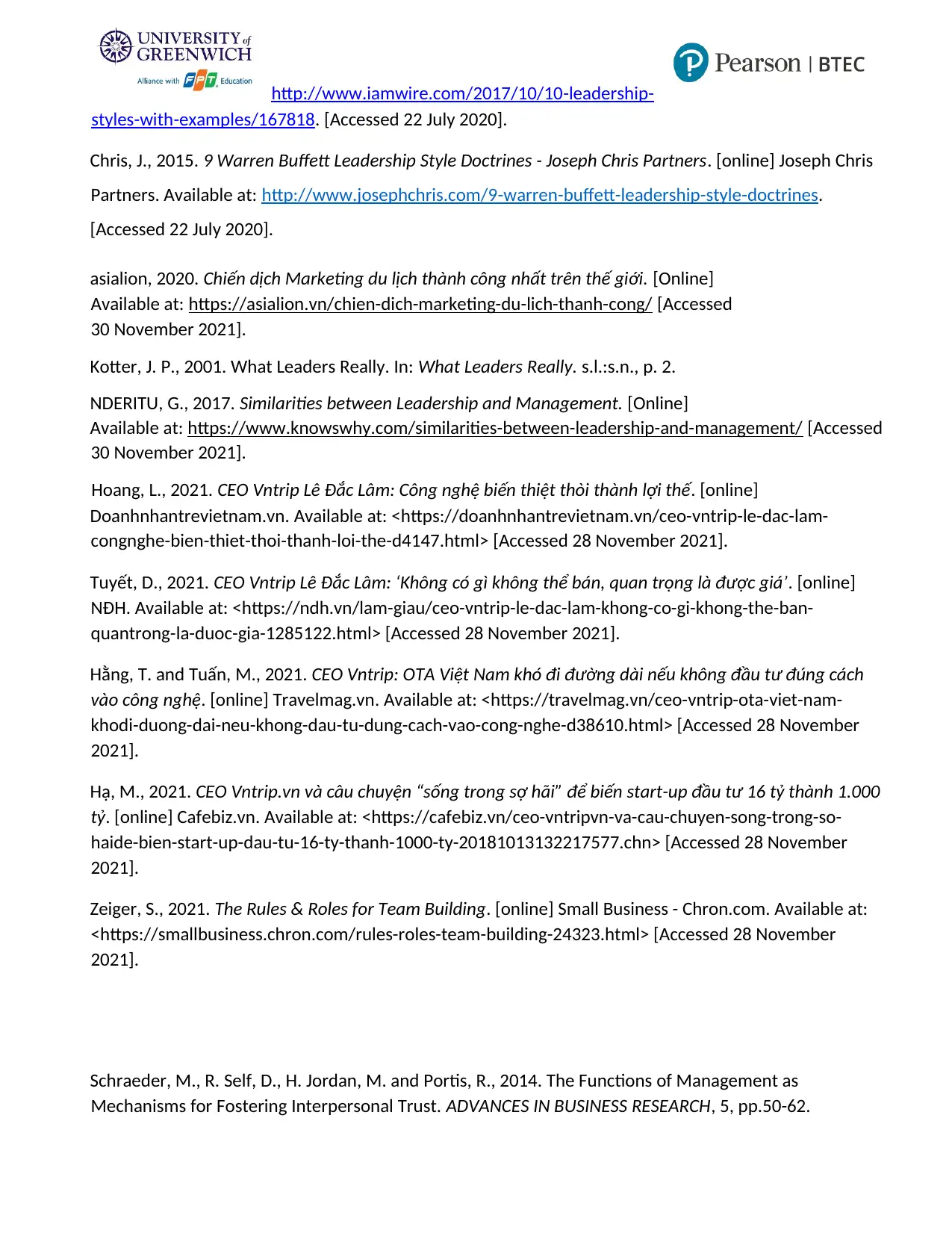
http://www.iamwire.com/2017/10/10-leadership-
styles-with-examples/167818. [Accessed 22 July 2020].
Chris, J., 2015. 9 Warren Buffett Leadership Style Doctrines - Joseph Chris Partners. [online] Joseph Chris
Partners. Available at: http://www.josephchris.com/9-warren-buffett-leadership-style-doctrines.
[Accessed 22 July 2020].
asialion, 2020. Chiến dịch Marketing du lịch thành công nhất trên thế giới. [Online]
Available at: https://asialion.vn/chien-dich-marketing-du-lich-thanh-cong/ [Accessed
30 November 2021].
Kotter, J. P., 2001. What Leaders Really. In: What Leaders Really. s.l.:s.n., p. 2.
NDERITU, G., 2017. Similarities between Leadership and Management. [Online]
Available at: https://www.knowswhy.com/similarities-between-leadership-and-management/ [Accessed
30 November 2021].
Hoang, L., 2021. CEO Vntrip Lê Đắc Lâm: Công nghệ biến thiệt thòi thành lợi thế. [online]
Doanhnhantrevietnam.vn. Available at: <https://doanhnhantrevietnam.vn/ceo-vntrip-le-dac-lam-
congnghe-bien-thiet-thoi-thanh-loi-the-d4147.html> [Accessed 28 November 2021].
Tuyết, D., 2021. CEO Vntrip Lê Đắc Lâm: ‘Không có gì không thể bán, quan trọng là được giá’. [online]
NĐH. Available at: <https://ndh.vn/lam-giau/ceo-vntrip-le-dac-lam-khong-co-gi-khong-the-ban-
quantrong-la-duoc-gia-1285122.html> [Accessed 28 November 2021].
Hằng, T. and Tuấn, M., 2021. CEO Vntrip: OTA Việt Nam khó đi đường dài nếu không đầu tư đúng cách
vào công nghệ. [online] Travelmag.vn. Available at: <https://travelmag.vn/ceo-vntrip-ota-viet-nam-
khodi-duong-dai-neu-khong-dau-tu-dung-cach-vao-cong-nghe-d38610.html> [Accessed 28 November
2021].
Hạ, M., 2021. CEO Vntrip.vn và câu chuyện “sống trong sợ hãi” để biến start-up đầu tư 16 tỷ thành 1.000
tỷ. [online] Cafebiz.vn. Available at: <https://cafebiz.vn/ceo-vntripvn-va-cau-chuyen-song-trong-so-
haide-bien-start-up-dau-tu-16-ty-thanh-1000-ty-20181013132217577.chn> [Accessed 28 November
2021].
Zeiger, S., 2021. The Rules & Roles for Team Building. [online] Small Business - Chron.com. Available at:
<https://smallbusiness.chron.com/rules-roles-team-building-24323.html> [Accessed 28 November
2021].
Schraeder, M., R. Self, D., H. Jordan, M. and Portis, R., 2014. The Functions of Management as
Mechanisms for Fostering Interpersonal Trust. ADVANCES IN BUSINESS RESEARCH, 5, pp.50-62.
styles-with-examples/167818. [Accessed 22 July 2020].
Chris, J., 2015. 9 Warren Buffett Leadership Style Doctrines - Joseph Chris Partners. [online] Joseph Chris
Partners. Available at: http://www.josephchris.com/9-warren-buffett-leadership-style-doctrines.
[Accessed 22 July 2020].
asialion, 2020. Chiến dịch Marketing du lịch thành công nhất trên thế giới. [Online]
Available at: https://asialion.vn/chien-dich-marketing-du-lich-thanh-cong/ [Accessed
30 November 2021].
Kotter, J. P., 2001. What Leaders Really. In: What Leaders Really. s.l.:s.n., p. 2.
NDERITU, G., 2017. Similarities between Leadership and Management. [Online]
Available at: https://www.knowswhy.com/similarities-between-leadership-and-management/ [Accessed
30 November 2021].
Hoang, L., 2021. CEO Vntrip Lê Đắc Lâm: Công nghệ biến thiệt thòi thành lợi thế. [online]
Doanhnhantrevietnam.vn. Available at: <https://doanhnhantrevietnam.vn/ceo-vntrip-le-dac-lam-
congnghe-bien-thiet-thoi-thanh-loi-the-d4147.html> [Accessed 28 November 2021].
Tuyết, D., 2021. CEO Vntrip Lê Đắc Lâm: ‘Không có gì không thể bán, quan trọng là được giá’. [online]
NĐH. Available at: <https://ndh.vn/lam-giau/ceo-vntrip-le-dac-lam-khong-co-gi-khong-the-ban-
quantrong-la-duoc-gia-1285122.html> [Accessed 28 November 2021].
Hằng, T. and Tuấn, M., 2021. CEO Vntrip: OTA Việt Nam khó đi đường dài nếu không đầu tư đúng cách
vào công nghệ. [online] Travelmag.vn. Available at: <https://travelmag.vn/ceo-vntrip-ota-viet-nam-
khodi-duong-dai-neu-khong-dau-tu-dung-cach-vao-cong-nghe-d38610.html> [Accessed 28 November
2021].
Hạ, M., 2021. CEO Vntrip.vn và câu chuyện “sống trong sợ hãi” để biến start-up đầu tư 16 tỷ thành 1.000
tỷ. [online] Cafebiz.vn. Available at: <https://cafebiz.vn/ceo-vntripvn-va-cau-chuyen-song-trong-so-
haide-bien-start-up-dau-tu-16-ty-thanh-1000-ty-20181013132217577.chn> [Accessed 28 November
2021].
Zeiger, S., 2021. The Rules & Roles for Team Building. [online] Small Business - Chron.com. Available at:
<https://smallbusiness.chron.com/rules-roles-team-building-24323.html> [Accessed 28 November
2021].
Schraeder, M., R. Self, D., H. Jordan, M. and Portis, R., 2014. The Functions of Management as
Mechanisms for Fostering Interpersonal Trust. ADVANCES IN BUSINESS RESEARCH, 5, pp.50-62.
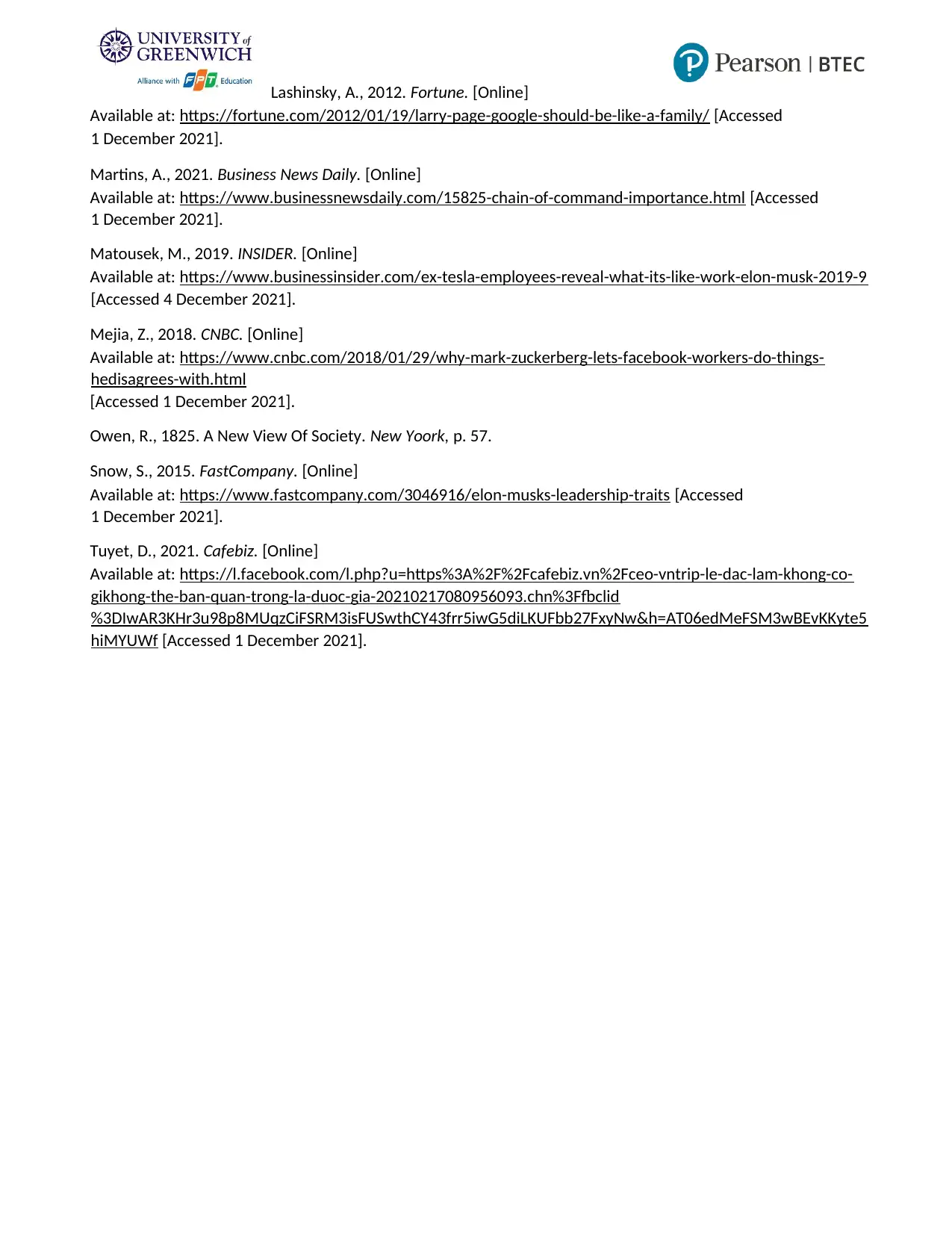
Lashinsky, A., 2012. Fortune. [Online]
Available at: https://fortune.com/2012/01/19/larry-page-google-should-be-like-a-family/ [Accessed
1 December 2021].
Martins, A., 2021. Business News Daily. [Online]
Available at: https://www.businessnewsdaily.com/15825-chain-of-command-importance.html [Accessed
1 December 2021].
Matousek, M., 2019. INSIDER. [Online]
Available at: https://www.businessinsider.com/ex-tesla-employees-reveal-what-its-like-work-elon-musk-2019-9
[Accessed 4 December 2021].
Mejia, Z., 2018. CNBC. [Online]
Available at: https://www.cnbc.com/2018/01/29/why-mark-zuckerberg-lets-facebook-workers-do-things-
hedisagrees-with.html
[Accessed 1 December 2021].
Owen, R., 1825. A New View Of Society. New Yoork, p. 57.
Snow, S., 2015. FastCompany. [Online]
Available at: https://www.fastcompany.com/3046916/elon-musks-leadership-traits [Accessed
1 December 2021].
Tuyet, D., 2021. Cafebiz. [Online]
Available at: https://l.facebook.com/l.php?u=https%3A%2F%2Fcafebiz.vn%2Fceo-vntrip-le-dac-lam-khong-co-
gikhong-the-ban-quan-trong-la-duoc-gia-20210217080956093.chn%3Ffbclid
%3DIwAR3KHr3u98p8MUqzCiFSRM3isFUSwthCY43frr5iwG5diLKUFbb27FxyNw&h=AT06edMeFSM3wBEvKKyte5
hiMYUWf [Accessed 1 December 2021].
Available at: https://fortune.com/2012/01/19/larry-page-google-should-be-like-a-family/ [Accessed
1 December 2021].
Martins, A., 2021. Business News Daily. [Online]
Available at: https://www.businessnewsdaily.com/15825-chain-of-command-importance.html [Accessed
1 December 2021].
Matousek, M., 2019. INSIDER. [Online]
Available at: https://www.businessinsider.com/ex-tesla-employees-reveal-what-its-like-work-elon-musk-2019-9
[Accessed 4 December 2021].
Mejia, Z., 2018. CNBC. [Online]
Available at: https://www.cnbc.com/2018/01/29/why-mark-zuckerberg-lets-facebook-workers-do-things-
hedisagrees-with.html
[Accessed 1 December 2021].
Owen, R., 1825. A New View Of Society. New Yoork, p. 57.
Snow, S., 2015. FastCompany. [Online]
Available at: https://www.fastcompany.com/3046916/elon-musks-leadership-traits [Accessed
1 December 2021].
Tuyet, D., 2021. Cafebiz. [Online]
Available at: https://l.facebook.com/l.php?u=https%3A%2F%2Fcafebiz.vn%2Fceo-vntrip-le-dac-lam-khong-co-
gikhong-the-ban-quan-trong-la-duoc-gia-20210217080956093.chn%3Ffbclid
%3DIwAR3KHr3u98p8MUqzCiFSRM3isFUSwthCY43frr5iwG5diLKUFbb27FxyNw&h=AT06edMeFSM3wBEvKKyte5
hiMYUWf [Accessed 1 December 2021].
1 out of 37
Related Documents
Your All-in-One AI-Powered Toolkit for Academic Success.
+13062052269
info@desklib.com
Available 24*7 on WhatsApp / Email
![[object Object]](/_next/static/media/star-bottom.7253800d.svg)
Unlock your academic potential
© 2024 | Zucol Services PVT LTD | All rights reserved.





